Rule of the habsburg king Stock Photos and Images
(101)See rule of the habsburg king stock video clipsQuick filters:
Rule of the habsburg king Stock Photos and Images
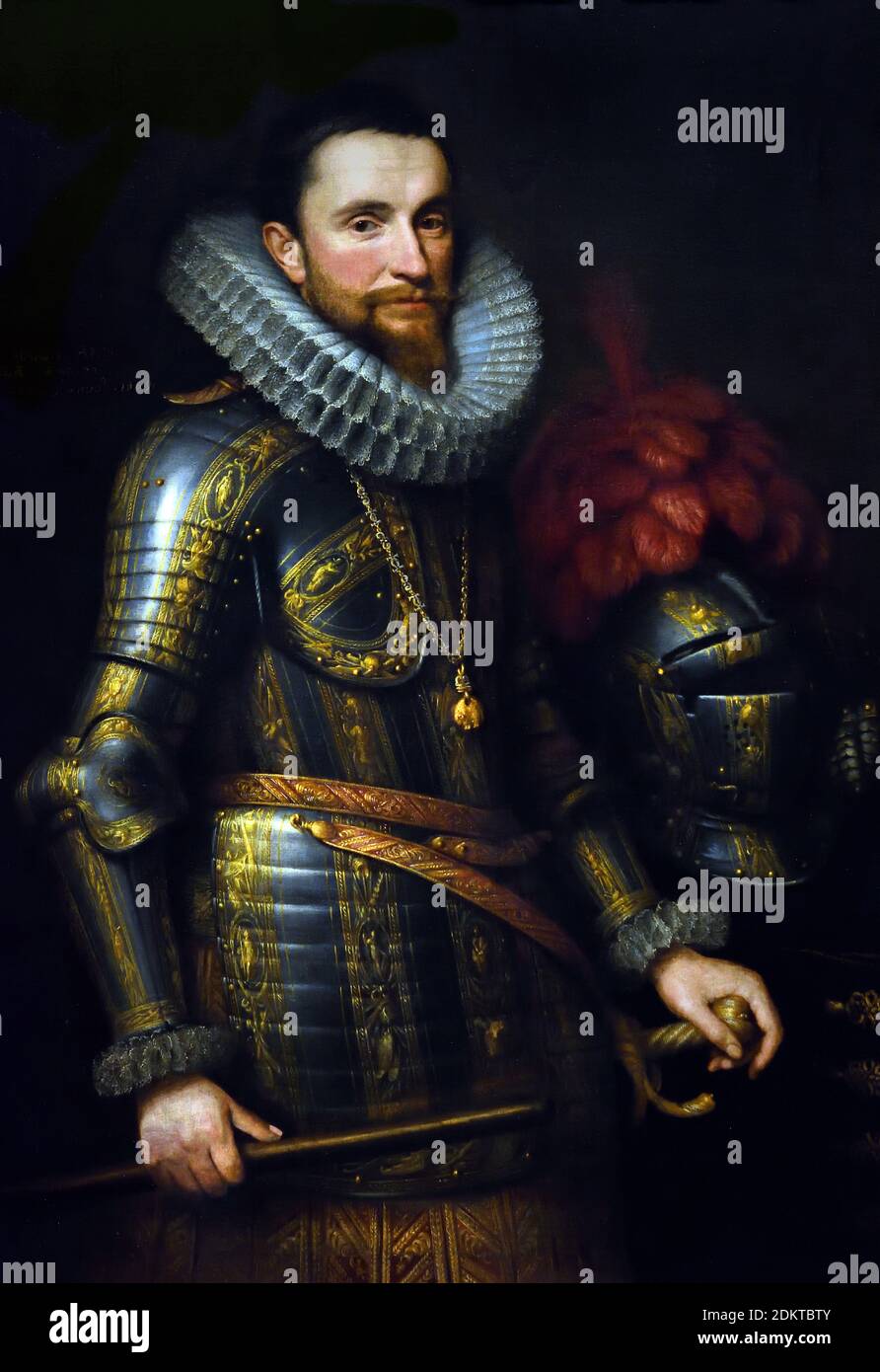 Ambrogio Spinola (1569-1630, Commander in Chief of the Spanish troops in the Southern Netherlands. Hip piece, standing in armor by a table on which stands the helmet with plumes. Command staff in the right hand, the left hand on the hilt of his epee. The emblem of the Order of the Golden Fleece on a chain around the neck. by Michiel Jansz. van Mierevelt (1566–1641) Holland, The Netherlands, Dutch, The Dutch Revolt 1566–1648 Low Countries against the rule of the Habsburg King Philip II of Spain The Eighty Years War. Stock Photohttps://www.alamy.com/image-license-details/?v=1https://www.alamy.com/ambrogio-spinola-1569-1630-commander-in-chief-of-the-spanish-troops-in-the-southern-netherlands-hip-piece-standing-in-armor-by-a-table-on-which-stands-the-helmet-with-plumes-command-staff-in-the-right-hand-the-left-hand-on-the-hilt-of-his-epee-the-emblem-of-the-order-of-the-golden-fleece-on-a-chain-around-the-neck-by-michiel-jansz-van-mierevelt-15661641-holland-the-netherlands-dutch-the-dutch-revolt-15661648-low-countries-against-the-rule-of-the-habsburg-king-philip-ii-of-spain-the-eighty-years-war-image390842731.html
Ambrogio Spinola (1569-1630, Commander in Chief of the Spanish troops in the Southern Netherlands. Hip piece, standing in armor by a table on which stands the helmet with plumes. Command staff in the right hand, the left hand on the hilt of his epee. The emblem of the Order of the Golden Fleece on a chain around the neck. by Michiel Jansz. van Mierevelt (1566–1641) Holland, The Netherlands, Dutch, The Dutch Revolt 1566–1648 Low Countries against the rule of the Habsburg King Philip II of Spain The Eighty Years War. Stock Photohttps://www.alamy.com/image-license-details/?v=1https://www.alamy.com/ambrogio-spinola-1569-1630-commander-in-chief-of-the-spanish-troops-in-the-southern-netherlands-hip-piece-standing-in-armor-by-a-table-on-which-stands-the-helmet-with-plumes-command-staff-in-the-right-hand-the-left-hand-on-the-hilt-of-his-epee-the-emblem-of-the-order-of-the-golden-fleece-on-a-chain-around-the-neck-by-michiel-jansz-van-mierevelt-15661641-holland-the-netherlands-dutch-the-dutch-revolt-15661648-low-countries-against-the-rule-of-the-habsburg-king-philip-ii-of-spain-the-eighty-years-war-image390842731.htmlRM2DKTBTY–Ambrogio Spinola (1569-1630, Commander in Chief of the Spanish troops in the Southern Netherlands. Hip piece, standing in armor by a table on which stands the helmet with plumes. Command staff in the right hand, the left hand on the hilt of his epee. The emblem of the Order of the Golden Fleece on a chain around the neck. by Michiel Jansz. van Mierevelt (1566–1641) Holland, The Netherlands, Dutch, The Dutch Revolt 1566–1648 Low Countries against the rule of the Habsburg King Philip II of Spain The Eighty Years War.
 William of Orange-Nassau (1533-1584) called the Taciturn. A member of the House of Nassau, he became Prince of Orange in 1544. Joined the rebellion against the rule of the Habsburg king Philip II of Spain. Portrait. Engraving. Wars of Flanders. Edition published in Antwerp, 1748. Stock Photohttps://www.alamy.com/image-license-details/?v=1https://www.alamy.com/william-of-orange-nassau-1533-1584-called-the-taciturn-a-member-of-the-house-of-nassau-he-became-prince-of-orange-in-1544-joined-the-rebellion-against-the-rule-of-the-habsburg-king-philip-ii-of-spain-portrait-engraving-wars-of-flanders-edition-published-in-antwerp-1748-image425944428.html
William of Orange-Nassau (1533-1584) called the Taciturn. A member of the House of Nassau, he became Prince of Orange in 1544. Joined the rebellion against the rule of the Habsburg king Philip II of Spain. Portrait. Engraving. Wars of Flanders. Edition published in Antwerp, 1748. Stock Photohttps://www.alamy.com/image-license-details/?v=1https://www.alamy.com/william-of-orange-nassau-1533-1584-called-the-taciturn-a-member-of-the-house-of-nassau-he-became-prince-of-orange-in-1544-joined-the-rebellion-against-the-rule-of-the-habsburg-king-philip-ii-of-spain-portrait-engraving-wars-of-flanders-edition-published-in-antwerp-1748-image425944428.htmlRM2FMYCD0–William of Orange-Nassau (1533-1584) called the Taciturn. A member of the House of Nassau, he became Prince of Orange in 1544. Joined the rebellion against the rule of the Habsburg king Philip II of Spain. Portrait. Engraving. Wars of Flanders. Edition published in Antwerp, 1748.
 Charles I (1887 ? 1922) Emperor of Austria, King of Hungary and the last of the monarchs belonging to the House of Habsburg Lorraine to rule over Austria Hungary. Charles became heir presumptive of Emperor Franz Joseph when his uncle Archduke Franz Ferdinand of Austria was assassinated in 1914. Stock Photohttps://www.alamy.com/image-license-details/?v=1https://www.alamy.com/charles-i-1887-1922-emperor-of-austria-king-of-hungary-and-the-last-of-the-monarchs-belonging-to-the-house-of-habsburg-lorraine-to-rule-over-austria-hungary-charles-became-heir-presumptive-of-emperor-franz-joseph-when-his-uncle-archduke-franz-ferdinand-of-austria-was-assassinated-in-1914-image634299403.html
Charles I (1887 ? 1922) Emperor of Austria, King of Hungary and the last of the monarchs belonging to the House of Habsburg Lorraine to rule over Austria Hungary. Charles became heir presumptive of Emperor Franz Joseph when his uncle Archduke Franz Ferdinand of Austria was assassinated in 1914. Stock Photohttps://www.alamy.com/image-license-details/?v=1https://www.alamy.com/charles-i-1887-1922-emperor-of-austria-king-of-hungary-and-the-last-of-the-monarchs-belonging-to-the-house-of-habsburg-lorraine-to-rule-over-austria-hungary-charles-became-heir-presumptive-of-emperor-franz-joseph-when-his-uncle-archduke-franz-ferdinand-of-austria-was-assassinated-in-1914-image634299403.htmlRM2YRXRA3–Charles I (1887 ? 1922) Emperor of Austria, King of Hungary and the last of the monarchs belonging to the House of Habsburg Lorraine to rule over Austria Hungary. Charles became heir presumptive of Emperor Franz Joseph when his uncle Archduke Franz Ferdinand of Austria was assassinated in 1914.
 The figures represented here are French royals between 1500 and 15500.They are, from left to right: Top Box: Francis I (died 1547), Eleanor of Austria, Queen Claudia (died 1524); Francis I (1547). Francis I was the first king of France from the Angouleme branch of the House of Valois. He was key to initiating the French Renaissance. Also under his rule, the expansion of first French colonial Empire. He ruled 1515 to his death in 1547. Eleanor of Austria (also called Eleanor of Castile) was from the house of Habsburg. She became Queen consort of Portugal and of France. Claude of France was Que Stock Photohttps://www.alamy.com/image-license-details/?v=1https://www.alamy.com/stock-image-the-figures-represented-here-are-french-royals-between-1500-and-15500they-165866760.html
The figures represented here are French royals between 1500 and 15500.They are, from left to right: Top Box: Francis I (died 1547), Eleanor of Austria, Queen Claudia (died 1524); Francis I (1547). Francis I was the first king of France from the Angouleme branch of the House of Valois. He was key to initiating the French Renaissance. Also under his rule, the expansion of first French colonial Empire. He ruled 1515 to his death in 1547. Eleanor of Austria (also called Eleanor of Castile) was from the house of Habsburg. She became Queen consort of Portugal and of France. Claude of France was Que Stock Photohttps://www.alamy.com/image-license-details/?v=1https://www.alamy.com/stock-image-the-figures-represented-here-are-french-royals-between-1500-and-15500they-165866760.htmlRFKHRTMT–The figures represented here are French royals between 1500 and 15500.They are, from left to right: Top Box: Francis I (died 1547), Eleanor of Austria, Queen Claudia (died 1524); Francis I (1547). Francis I was the first king of France from the Angouleme branch of the House of Valois. He was key to initiating the French Renaissance. Also under his rule, the expansion of first French colonial Empire. He ruled 1515 to his death in 1547. Eleanor of Austria (also called Eleanor of Castile) was from the house of Habsburg. She became Queen consort of Portugal and of France. Claude of France was Que
 Groningen brought under the rule of the Habsburgs, in honor of Mary of Hungary, governor of the Netherlands, Copper Medal. Obverse: the letter M under the hand and the brace, above the year within the inscription. Reverse: double-headed eagle under crown holds diamond-shaped coat of arms in front of her inscription, Groningen (province), Charles V of Habsburg (German emperor and king of Spain), Mary of Hungary (governor of the Netherlands), anonymous, Netherlands, 1536, copper (metal), striking (metalworking), d 2.8 cm × w 4.21 Stock Photohttps://www.alamy.com/image-license-details/?v=1https://www.alamy.com/groningen-brought-under-the-rule-of-the-habsburgs-in-honor-of-mary-of-hungary-governor-of-the-netherlands-copper-medal-obverse-the-letter-m-under-the-hand-and-the-brace-above-the-year-within-the-inscription-reverse-double-headed-eagle-under-crown-holds-diamond-shaped-coat-of-arms-in-front-of-her-inscription-groningen-province-charles-v-of-habsburg-german-emperor-and-king-of-spain-mary-of-hungary-governor-of-the-netherlands-anonymous-netherlands-1536-copper-metal-striking-metalworking-d-28-cm-w-421-image261388702.html
Groningen brought under the rule of the Habsburgs, in honor of Mary of Hungary, governor of the Netherlands, Copper Medal. Obverse: the letter M under the hand and the brace, above the year within the inscription. Reverse: double-headed eagle under crown holds diamond-shaped coat of arms in front of her inscription, Groningen (province), Charles V of Habsburg (German emperor and king of Spain), Mary of Hungary (governor of the Netherlands), anonymous, Netherlands, 1536, copper (metal), striking (metalworking), d 2.8 cm × w 4.21 Stock Photohttps://www.alamy.com/image-license-details/?v=1https://www.alamy.com/groningen-brought-under-the-rule-of-the-habsburgs-in-honor-of-mary-of-hungary-governor-of-the-netherlands-copper-medal-obverse-the-letter-m-under-the-hand-and-the-brace-above-the-year-within-the-inscription-reverse-double-headed-eagle-under-crown-holds-diamond-shaped-coat-of-arms-in-front-of-her-inscription-groningen-province-charles-v-of-habsburg-german-emperor-and-king-of-spain-mary-of-hungary-governor-of-the-netherlands-anonymous-netherlands-1536-copper-metal-striking-metalworking-d-28-cm-w-421-image261388702.htmlRMW577XP–Groningen brought under the rule of the Habsburgs, in honor of Mary of Hungary, governor of the Netherlands, Copper Medal. Obverse: the letter M under the hand and the brace, above the year within the inscription. Reverse: double-headed eagle under crown holds diamond-shaped coat of arms in front of her inscription, Groningen (province), Charles V of Habsburg (German emperor and king of Spain), Mary of Hungary (governor of the Netherlands), anonymous, Netherlands, 1536, copper (metal), striking (metalworking), d 2.8 cm × w 4.21
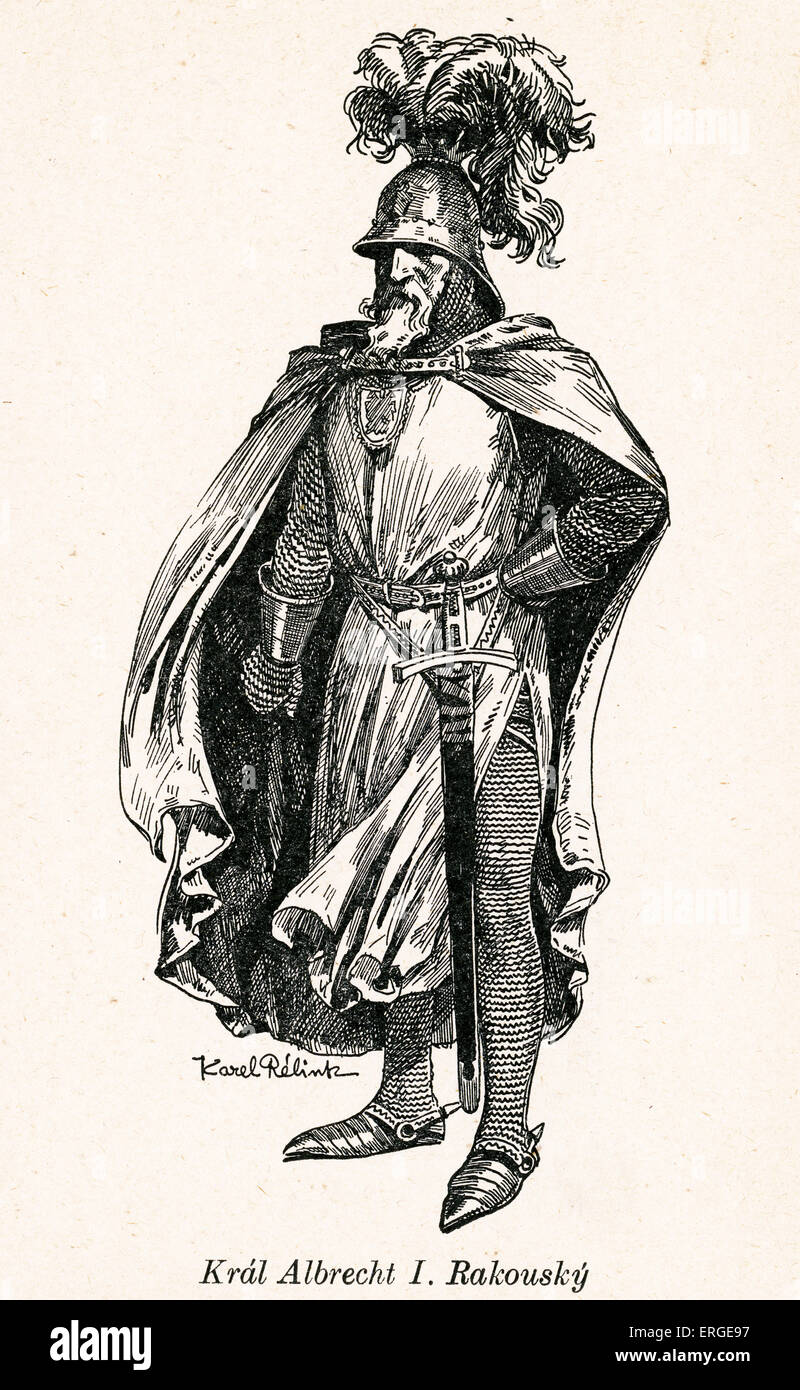 Albert I of Habsburg (Czech: Kral Albrecht I Rakousky/ Habsburský) by K. Relink. King of the Romans and Duke of Austria, the Stock Photohttps://www.alamy.com/image-license-details/?v=1https://www.alamy.com/stock-photo-albert-i-of-habsburg-czech-kral-albrecht-i-rakousky-habsbursk-by-k-83341027.html
Albert I of Habsburg (Czech: Kral Albrecht I Rakousky/ Habsburský) by K. Relink. King of the Romans and Duke of Austria, the Stock Photohttps://www.alamy.com/image-license-details/?v=1https://www.alamy.com/stock-photo-albert-i-of-habsburg-czech-kral-albrecht-i-rakousky-habsbursk-by-k-83341027.htmlRMERGE97–Albert I of Habsburg (Czech: Kral Albrecht I Rakousky/ Habsburský) by K. Relink. King of the Romans and Duke of Austria, the
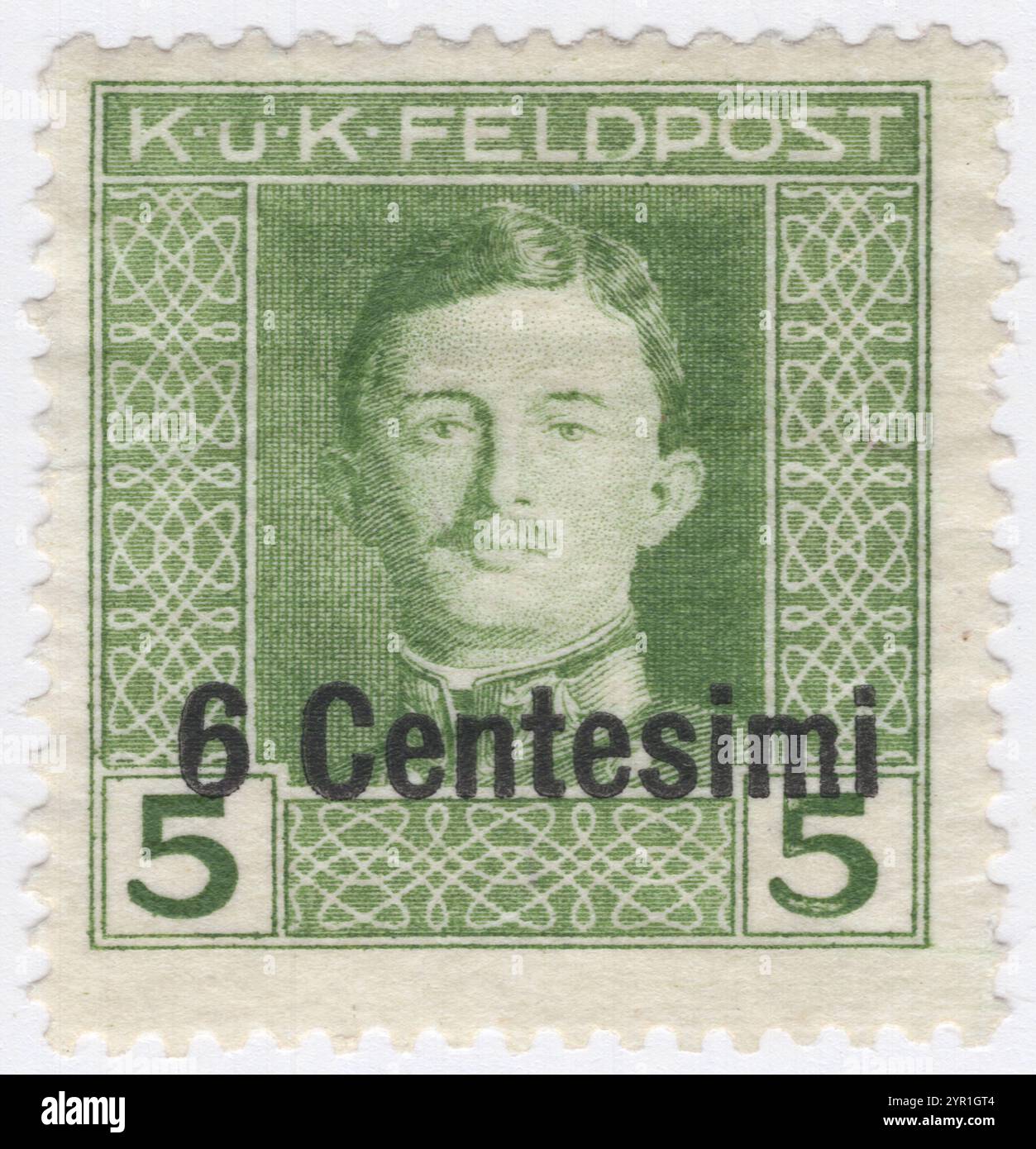 AUSTRIAN OCCUPATION OF ITALY - 1918 June 01: 6 centesimi on 5 heller olive-green Occupation postage stamp depicting portrait of Karl I, Emperor of Austria, King of Hungary, and the ruler of the other states of the Habsburg monarchy from November 1916 until the monarchy was abolished in April 1919. He was the last of the monarchs belonging to the House of Habsburg-Lorraine to rule over Austria-Hungary Stock Photohttps://www.alamy.com/image-license-details/?v=1https://www.alamy.com/austrian-occupation-of-italy-1918-june-01-6-centesimi-on-5-heller-olive-green-occupation-postage-stamp-depicting-portrait-of-karl-i-emperor-of-austria-king-of-hungary-and-the-ruler-of-the-other-states-of-the-habsburg-monarchy-from-november-1916-until-the-monarchy-was-abolished-in-april-1919-he-was-the-last-of-the-monarchs-belonging-to-the-house-of-habsburg-lorraine-to-rule-over-austria-hungary-image633745508.html
AUSTRIAN OCCUPATION OF ITALY - 1918 June 01: 6 centesimi on 5 heller olive-green Occupation postage stamp depicting portrait of Karl I, Emperor of Austria, King of Hungary, and the ruler of the other states of the Habsburg monarchy from November 1916 until the monarchy was abolished in April 1919. He was the last of the monarchs belonging to the House of Habsburg-Lorraine to rule over Austria-Hungary Stock Photohttps://www.alamy.com/image-license-details/?v=1https://www.alamy.com/austrian-occupation-of-italy-1918-june-01-6-centesimi-on-5-heller-olive-green-occupation-postage-stamp-depicting-portrait-of-karl-i-emperor-of-austria-king-of-hungary-and-the-ruler-of-the-other-states-of-the-habsburg-monarchy-from-november-1916-until-the-monarchy-was-abolished-in-april-1919-he-was-the-last-of-the-monarchs-belonging-to-the-house-of-habsburg-lorraine-to-rule-over-austria-hungary-image633745508.htmlRF2YR1GT4–AUSTRIAN OCCUPATION OF ITALY - 1918 June 01: 6 centesimi on 5 heller olive-green Occupation postage stamp depicting portrait of Karl I, Emperor of Austria, King of Hungary, and the ruler of the other states of the Habsburg monarchy from November 1916 until the monarchy was abolished in April 1919. He was the last of the monarchs belonging to the House of Habsburg-Lorraine to rule over Austria-Hungary
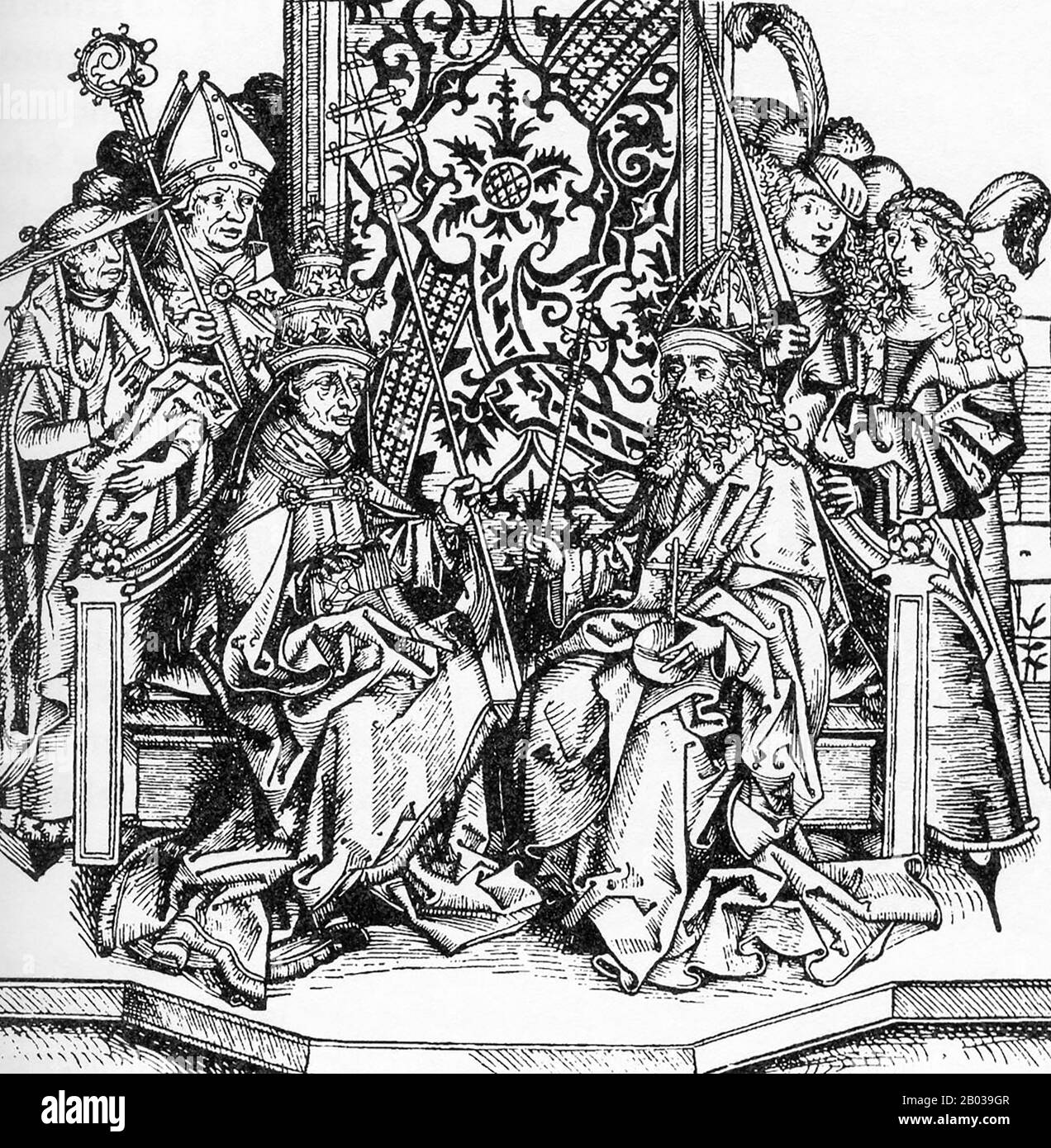 Frederick III (1415-1493), also known as Frederick the Fat and Frederick the Peaceful, was the eldest son of the Inner Austrian duke Ernest the Iron, a member of the Habsburg dynasty. He became duke of Inner Austria in 1424 at the age of nine, but would not be awarded rule until 1435, with his younger brother Albert asserting his rights as co-ruler. By 1439, Frederick had become the undisputed head of the Habsburg dynasty. Frederick was the cousin of late King Albert II, and was elected as King of Germany in 1440. He travelled to Italy in 1452 to be crowned Holy Roman Emperor. He was unsucces Stock Photohttps://www.alamy.com/image-license-details/?v=1https://www.alamy.com/frederick-iii-1415-1493-also-known-as-frederick-the-fat-and-frederick-the-peaceful-was-the-eldest-son-of-the-inner-austrian-duke-ernest-the-iron-a-member-of-the-habsburg-dynasty-he-became-duke-of-inner-austria-in-1424-at-the-age-of-nine-but-would-not-be-awarded-rule-until-1435-with-his-younger-brother-albert-asserting-his-rights-as-co-ruler-by-1439-frederick-had-become-the-undisputed-head-of-the-habsburg-dynasty-frederick-was-the-cousin-of-late-king-albert-ii-and-was-elected-as-king-of-germany-in-1440-he-travelled-to-italy-in-1452-to-be-crowned-holy-roman-emperor-he-was-unsucces-image344280743.html
Frederick III (1415-1493), also known as Frederick the Fat and Frederick the Peaceful, was the eldest son of the Inner Austrian duke Ernest the Iron, a member of the Habsburg dynasty. He became duke of Inner Austria in 1424 at the age of nine, but would not be awarded rule until 1435, with his younger brother Albert asserting his rights as co-ruler. By 1439, Frederick had become the undisputed head of the Habsburg dynasty. Frederick was the cousin of late King Albert II, and was elected as King of Germany in 1440. He travelled to Italy in 1452 to be crowned Holy Roman Emperor. He was unsucces Stock Photohttps://www.alamy.com/image-license-details/?v=1https://www.alamy.com/frederick-iii-1415-1493-also-known-as-frederick-the-fat-and-frederick-the-peaceful-was-the-eldest-son-of-the-inner-austrian-duke-ernest-the-iron-a-member-of-the-habsburg-dynasty-he-became-duke-of-inner-austria-in-1424-at-the-age-of-nine-but-would-not-be-awarded-rule-until-1435-with-his-younger-brother-albert-asserting-his-rights-as-co-ruler-by-1439-frederick-had-become-the-undisputed-head-of-the-habsburg-dynasty-frederick-was-the-cousin-of-late-king-albert-ii-and-was-elected-as-king-of-germany-in-1440-he-travelled-to-italy-in-1452-to-be-crowned-holy-roman-emperor-he-was-unsucces-image344280743.htmlRM2B039GR–Frederick III (1415-1493), also known as Frederick the Fat and Frederick the Peaceful, was the eldest son of the Inner Austrian duke Ernest the Iron, a member of the Habsburg dynasty. He became duke of Inner Austria in 1424 at the age of nine, but would not be awarded rule until 1435, with his younger brother Albert asserting his rights as co-ruler. By 1439, Frederick had become the undisputed head of the Habsburg dynasty. Frederick was the cousin of late King Albert II, and was elected as King of Germany in 1440. He travelled to Italy in 1452 to be crowned Holy Roman Emperor. He was unsucces
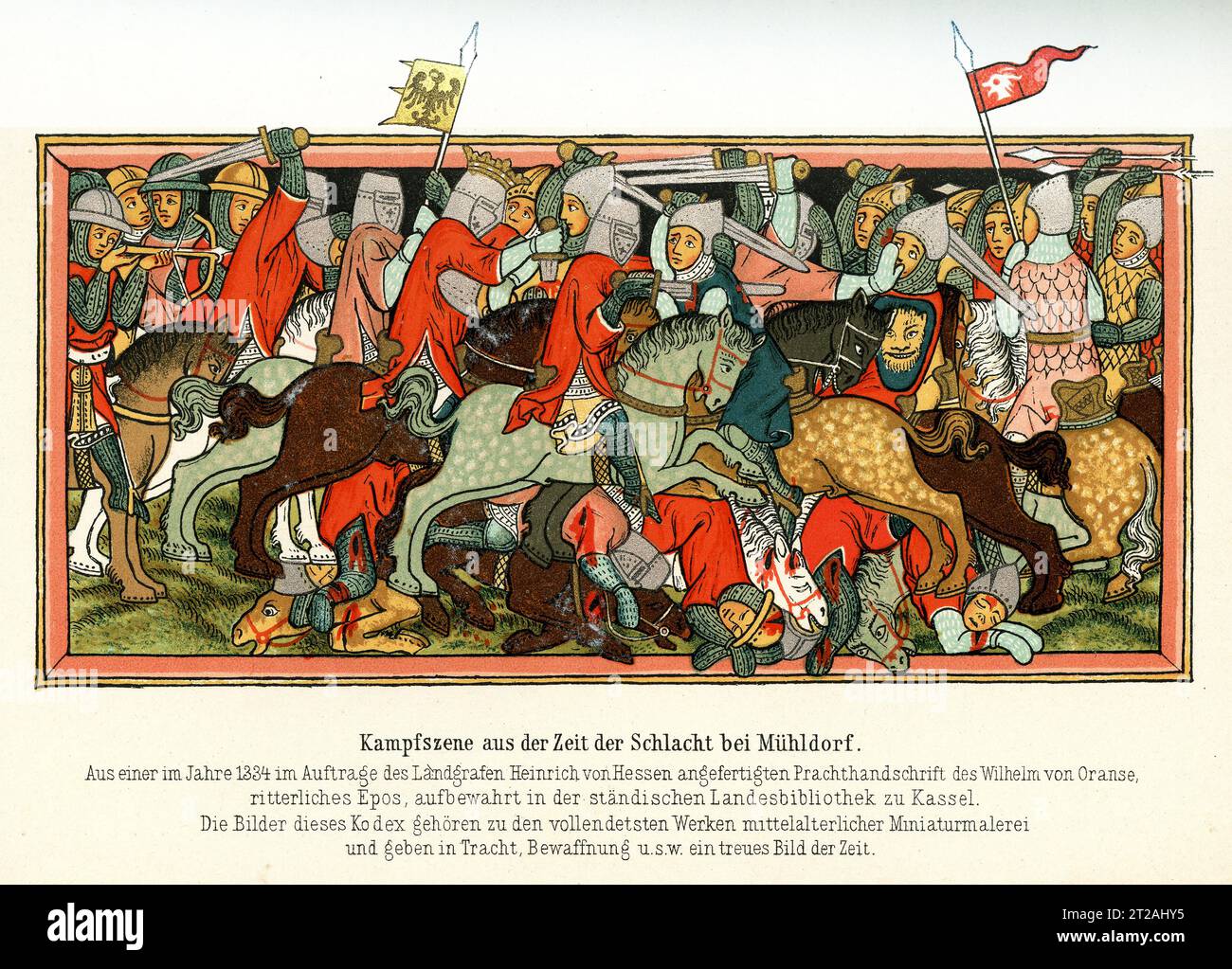 Miniature of the Battle of Mühldorf (year 1322) between the Bavarian dinasty Wittelsbach and the Austrian Habsburg for the rule over the Holy Roman Empire ending with the victory of German king Louis of Wittelsbach, Kassel Landesbibliothek Stock Photohttps://www.alamy.com/image-license-details/?v=1https://www.alamy.com/miniature-of-the-battle-of-mhldorf-year-1322-between-the-bavarian-dinasty-wittelsbach-and-the-austrian-habsburg-for-the-rule-over-the-holy-roman-empire-ending-with-the-victory-of-german-king-louis-of-wittelsbach-kassel-landesbibliothek-image569405065.html
Miniature of the Battle of Mühldorf (year 1322) between the Bavarian dinasty Wittelsbach and the Austrian Habsburg for the rule over the Holy Roman Empire ending with the victory of German king Louis of Wittelsbach, Kassel Landesbibliothek Stock Photohttps://www.alamy.com/image-license-details/?v=1https://www.alamy.com/miniature-of-the-battle-of-mhldorf-year-1322-between-the-bavarian-dinasty-wittelsbach-and-the-austrian-habsburg-for-the-rule-over-the-holy-roman-empire-ending-with-the-victory-of-german-king-louis-of-wittelsbach-kassel-landesbibliothek-image569405065.htmlRM2T2AHY5–Miniature of the Battle of Mühldorf (year 1322) between the Bavarian dinasty Wittelsbach and the Austrian Habsburg for the rule over the Holy Roman Empire ending with the victory of German king Louis of Wittelsbach, Kassel Landesbibliothek
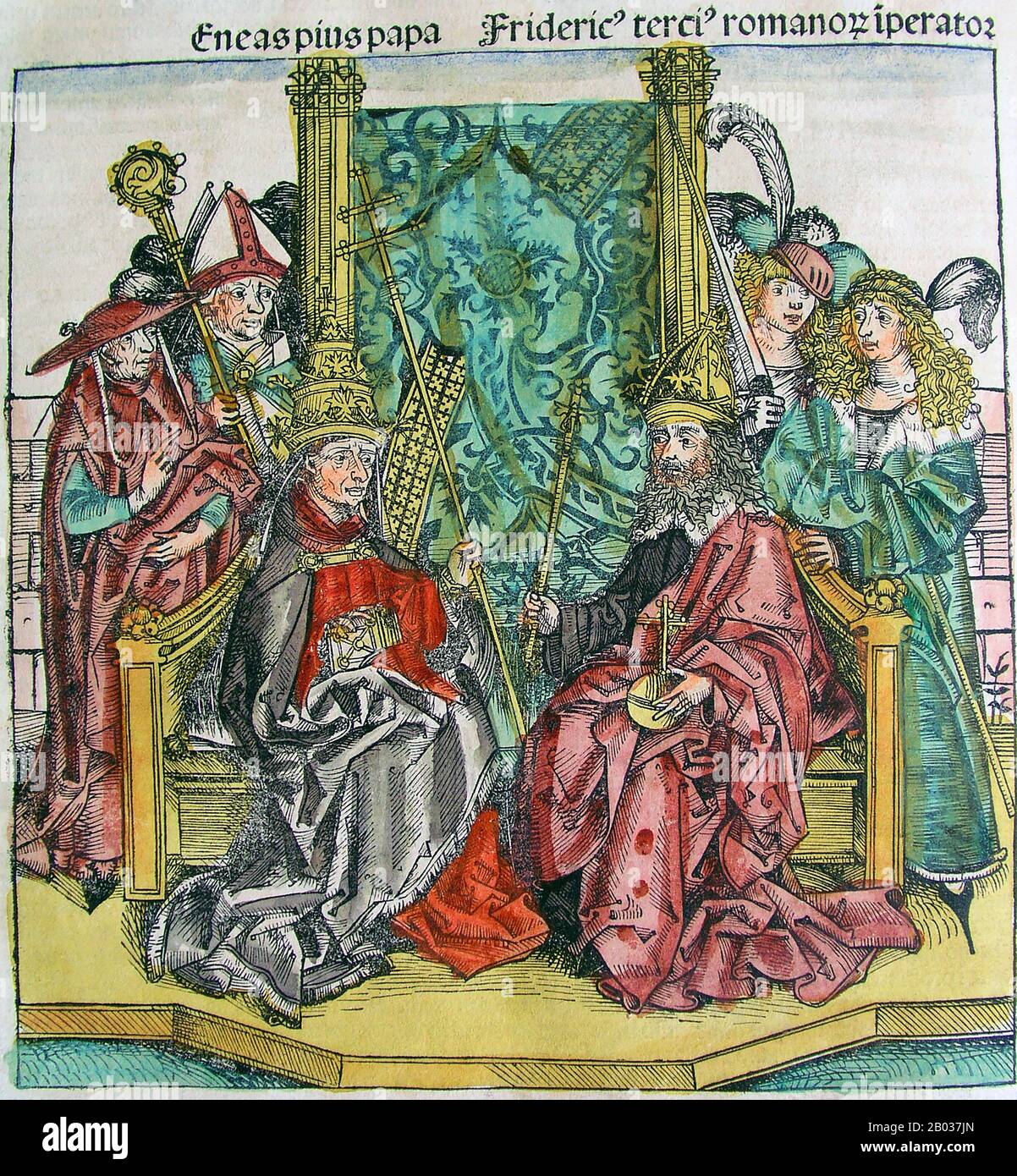 Frederick III (1415-1493), also known as Frederick the Fat and Frederick the Peaceful, was the eldest son of the Inner Austrian duke Ernest the Iron, a member of the Habsburg dynasty. He became duke of Inner Austria in 1424 at the age of nine, but would not be awarded rule until 1435, with his younger brother Albert asserting his rights as co-ruler. By 1439, Frederick had become the undisputed head of the Habsburg dynasty. Frederick was the cousin of late King Albert II, and was elected as King of Germany in 1440. He travelled to Italy in 1452 to receive his bride and be crowned Holy Roman Em Stock Photohttps://www.alamy.com/image-license-details/?v=1https://www.alamy.com/frederick-iii-1415-1493-also-known-as-frederick-the-fat-and-frederick-the-peaceful-was-the-eldest-son-of-the-inner-austrian-duke-ernest-the-iron-a-member-of-the-habsburg-dynasty-he-became-duke-of-inner-austria-in-1424-at-the-age-of-nine-but-would-not-be-awarded-rule-until-1435-with-his-younger-brother-albert-asserting-his-rights-as-co-ruler-by-1439-frederick-had-become-the-undisputed-head-of-the-habsburg-dynasty-frederick-was-the-cousin-of-late-king-albert-ii-and-was-elected-as-king-of-germany-in-1440-he-travelled-to-italy-in-1452-to-receive-his-bride-and-be-crowned-holy-roman-em-image344279229.html
Frederick III (1415-1493), also known as Frederick the Fat and Frederick the Peaceful, was the eldest son of the Inner Austrian duke Ernest the Iron, a member of the Habsburg dynasty. He became duke of Inner Austria in 1424 at the age of nine, but would not be awarded rule until 1435, with his younger brother Albert asserting his rights as co-ruler. By 1439, Frederick had become the undisputed head of the Habsburg dynasty. Frederick was the cousin of late King Albert II, and was elected as King of Germany in 1440. He travelled to Italy in 1452 to receive his bride and be crowned Holy Roman Em Stock Photohttps://www.alamy.com/image-license-details/?v=1https://www.alamy.com/frederick-iii-1415-1493-also-known-as-frederick-the-fat-and-frederick-the-peaceful-was-the-eldest-son-of-the-inner-austrian-duke-ernest-the-iron-a-member-of-the-habsburg-dynasty-he-became-duke-of-inner-austria-in-1424-at-the-age-of-nine-but-would-not-be-awarded-rule-until-1435-with-his-younger-brother-albert-asserting-his-rights-as-co-ruler-by-1439-frederick-had-become-the-undisputed-head-of-the-habsburg-dynasty-frederick-was-the-cousin-of-late-king-albert-ii-and-was-elected-as-king-of-germany-in-1440-he-travelled-to-italy-in-1452-to-receive-his-bride-and-be-crowned-holy-roman-em-image344279229.htmlRM2B037JN–Frederick III (1415-1493), also known as Frederick the Fat and Frederick the Peaceful, was the eldest son of the Inner Austrian duke Ernest the Iron, a member of the Habsburg dynasty. He became duke of Inner Austria in 1424 at the age of nine, but would not be awarded rule until 1435, with his younger brother Albert asserting his rights as co-ruler. By 1439, Frederick had become the undisputed head of the Habsburg dynasty. Frederick was the cousin of late King Albert II, and was elected as King of Germany in 1440. He travelled to Italy in 1452 to receive his bride and be crowned Holy Roman Em
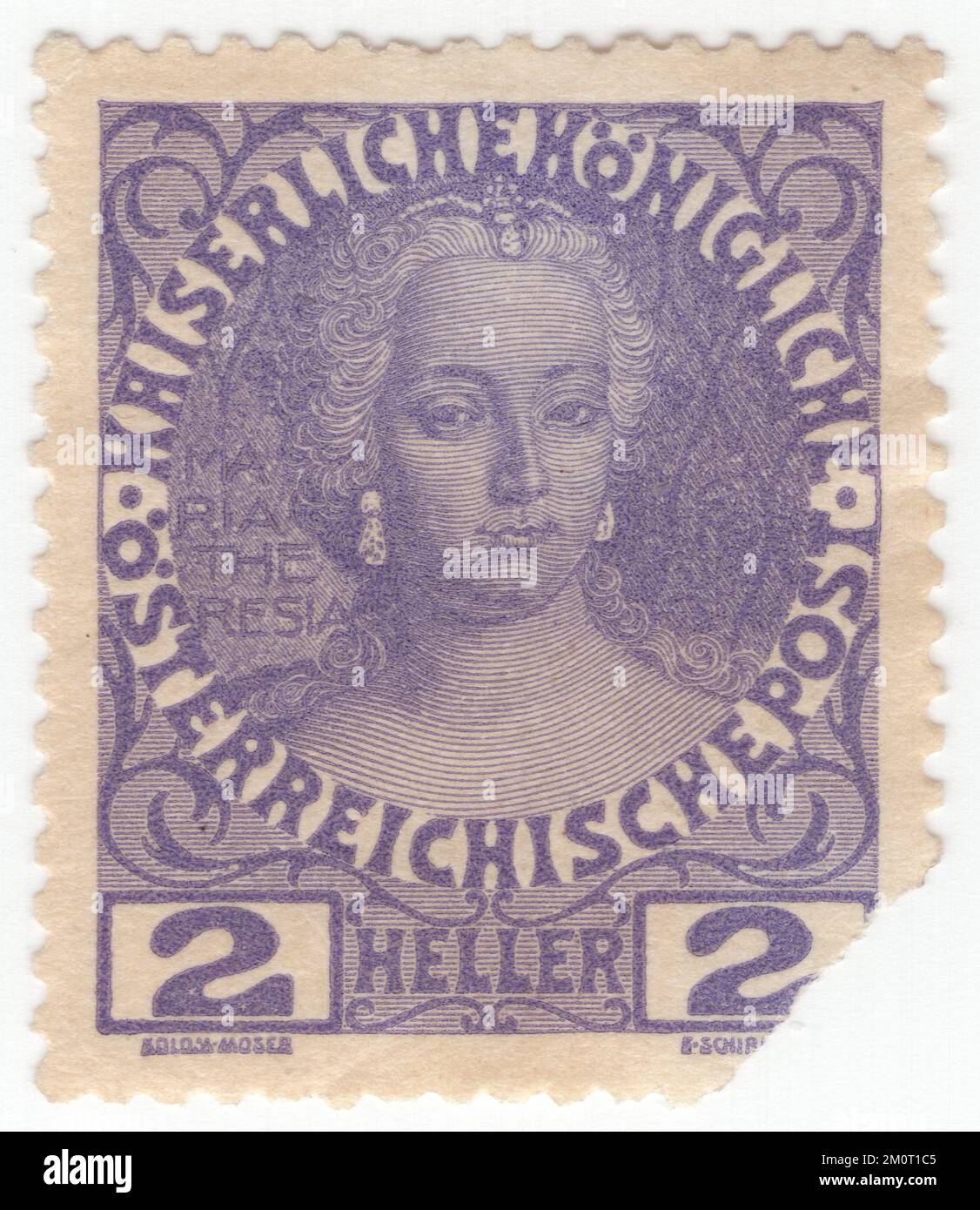 AUSTRIA — 1908: An 2 heller violet postage stamp depicting portrait of Maria Theresa. Definitive set issued for the 60th year of the reign of Austrian Monarch Franz Josef, Emperor of Austria, King of Hungary, and the other states of the Habsburg monarchy. Maria Theresa Walburga Amalia Christina was ruler of the Habsburg dominions from 1740 until her death in 1780, and the only woman to hold the position suo jure (in her own right). She was the sovereign of Austria, Hungary, Croatia, Bohemia, Transylvania, Mantua, Milan, Lodomeria and Galicia, the Austrian Netherlands, and Parma Stock Photohttps://www.alamy.com/image-license-details/?v=1https://www.alamy.com/austria-1908-an-2-heller-violet-postage-stamp-depicting-portrait-of-maria-theresa-definitive-set-issued-for-the-60th-year-of-the-reign-of-austrian-monarch-franz-josef-emperor-of-austria-king-of-hungary-and-the-other-states-of-the-habsburg-monarchy-maria-theresa-walburga-amalia-christina-was-ruler-of-the-habsburg-dominions-from-1740-until-her-death-in-1780-and-the-only-woman-to-hold-the-position-suo-jure-in-her-own-right-she-was-the-sovereign-of-austria-hungary-croatia-bohemia-transylvania-mantua-milan-lodomeria-and-galicia-the-austrian-netherlands-and-parma-image499628645.html
AUSTRIA — 1908: An 2 heller violet postage stamp depicting portrait of Maria Theresa. Definitive set issued for the 60th year of the reign of Austrian Monarch Franz Josef, Emperor of Austria, King of Hungary, and the other states of the Habsburg monarchy. Maria Theresa Walburga Amalia Christina was ruler of the Habsburg dominions from 1740 until her death in 1780, and the only woman to hold the position suo jure (in her own right). She was the sovereign of Austria, Hungary, Croatia, Bohemia, Transylvania, Mantua, Milan, Lodomeria and Galicia, the Austrian Netherlands, and Parma Stock Photohttps://www.alamy.com/image-license-details/?v=1https://www.alamy.com/austria-1908-an-2-heller-violet-postage-stamp-depicting-portrait-of-maria-theresa-definitive-set-issued-for-the-60th-year-of-the-reign-of-austrian-monarch-franz-josef-emperor-of-austria-king-of-hungary-and-the-other-states-of-the-habsburg-monarchy-maria-theresa-walburga-amalia-christina-was-ruler-of-the-habsburg-dominions-from-1740-until-her-death-in-1780-and-the-only-woman-to-hold-the-position-suo-jure-in-her-own-right-she-was-the-sovereign-of-austria-hungary-croatia-bohemia-transylvania-mantua-milan-lodomeria-and-galicia-the-austrian-netherlands-and-parma-image499628645.htmlRF2M0T1C5–AUSTRIA — 1908: An 2 heller violet postage stamp depicting portrait of Maria Theresa. Definitive set issued for the 60th year of the reign of Austrian Monarch Franz Josef, Emperor of Austria, King of Hungary, and the other states of the Habsburg monarchy. Maria Theresa Walburga Amalia Christina was ruler of the Habsburg dominions from 1740 until her death in 1780, and the only woman to hold the position suo jure (in her own right). She was the sovereign of Austria, Hungary, Croatia, Bohemia, Transylvania, Mantua, Milan, Lodomeria and Galicia, the Austrian Netherlands, and Parma
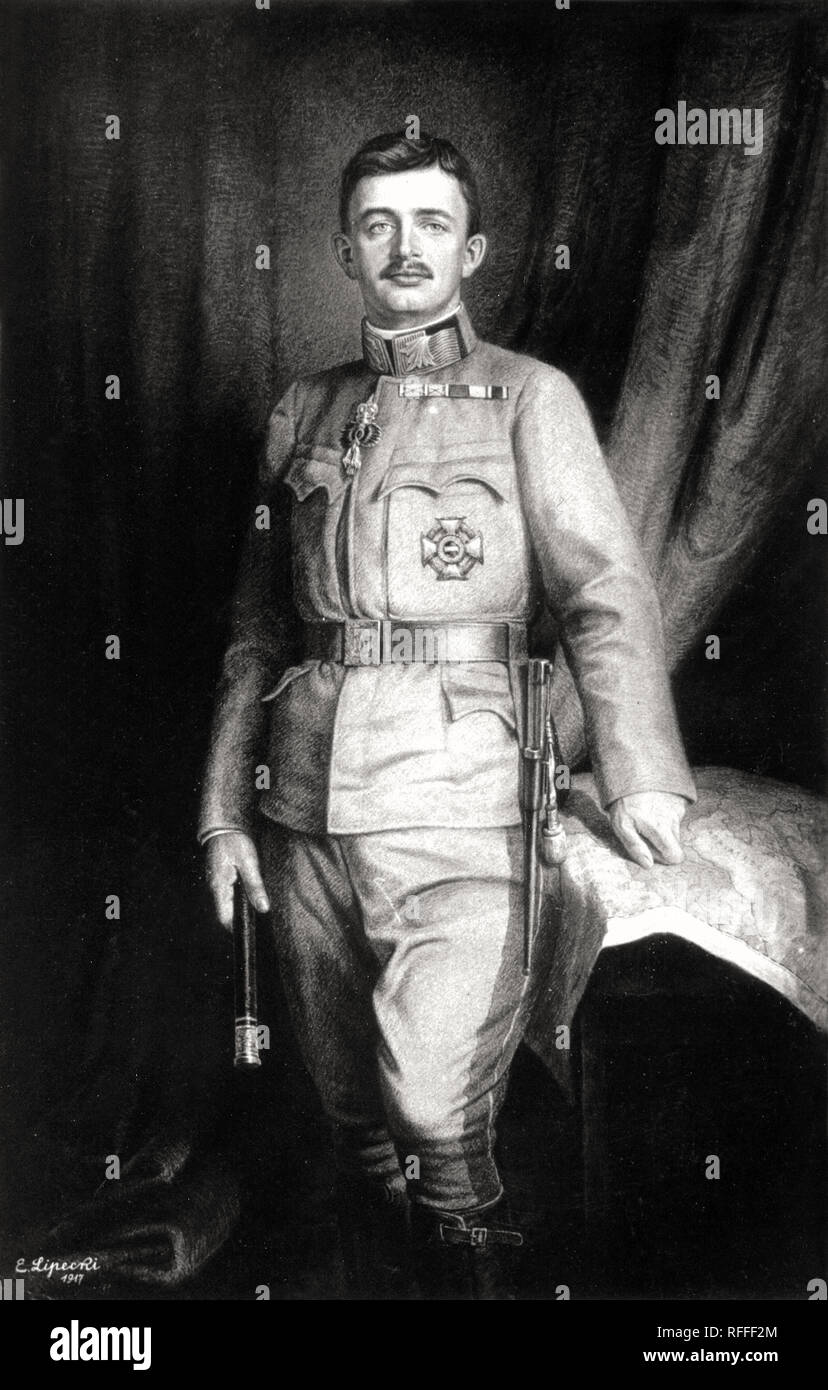 Charles I or Karl I (Karl Franz Josef Ludwig Hubert Georg Otto Maria) (17 August 1887 – 1 April 1922) was Emperor of Austria, King of Hungary, King of Croatia, King of Bohemia, and the last of the monarchs belonging to the House of Habsburg-Lorraine to rule over Austria-Hungary. Stock Photohttps://www.alamy.com/image-license-details/?v=1https://www.alamy.com/charles-i-or-karl-i-karl-franz-josef-ludwig-hubert-georg-otto-maria-17-august-1887-1-april-1922-was-emperor-of-austria-king-of-hungary-king-of-croatia-king-of-bohemia-and-the-last-of-the-monarchs-belonging-to-the-house-of-habsburg-lorraine-to-rule-over-austria-hungary-image233295740.html
Charles I or Karl I (Karl Franz Josef Ludwig Hubert Georg Otto Maria) (17 August 1887 – 1 April 1922) was Emperor of Austria, King of Hungary, King of Croatia, King of Bohemia, and the last of the monarchs belonging to the House of Habsburg-Lorraine to rule over Austria-Hungary. Stock Photohttps://www.alamy.com/image-license-details/?v=1https://www.alamy.com/charles-i-or-karl-i-karl-franz-josef-ludwig-hubert-georg-otto-maria-17-august-1887-1-april-1922-was-emperor-of-austria-king-of-hungary-king-of-croatia-king-of-bohemia-and-the-last-of-the-monarchs-belonging-to-the-house-of-habsburg-lorraine-to-rule-over-austria-hungary-image233295740.htmlRFRFFF2M–Charles I or Karl I (Karl Franz Josef Ludwig Hubert Georg Otto Maria) (17 August 1887 – 1 April 1922) was Emperor of Austria, King of Hungary, King of Croatia, King of Bohemia, and the last of the monarchs belonging to the House of Habsburg-Lorraine to rule over Austria-Hungary.
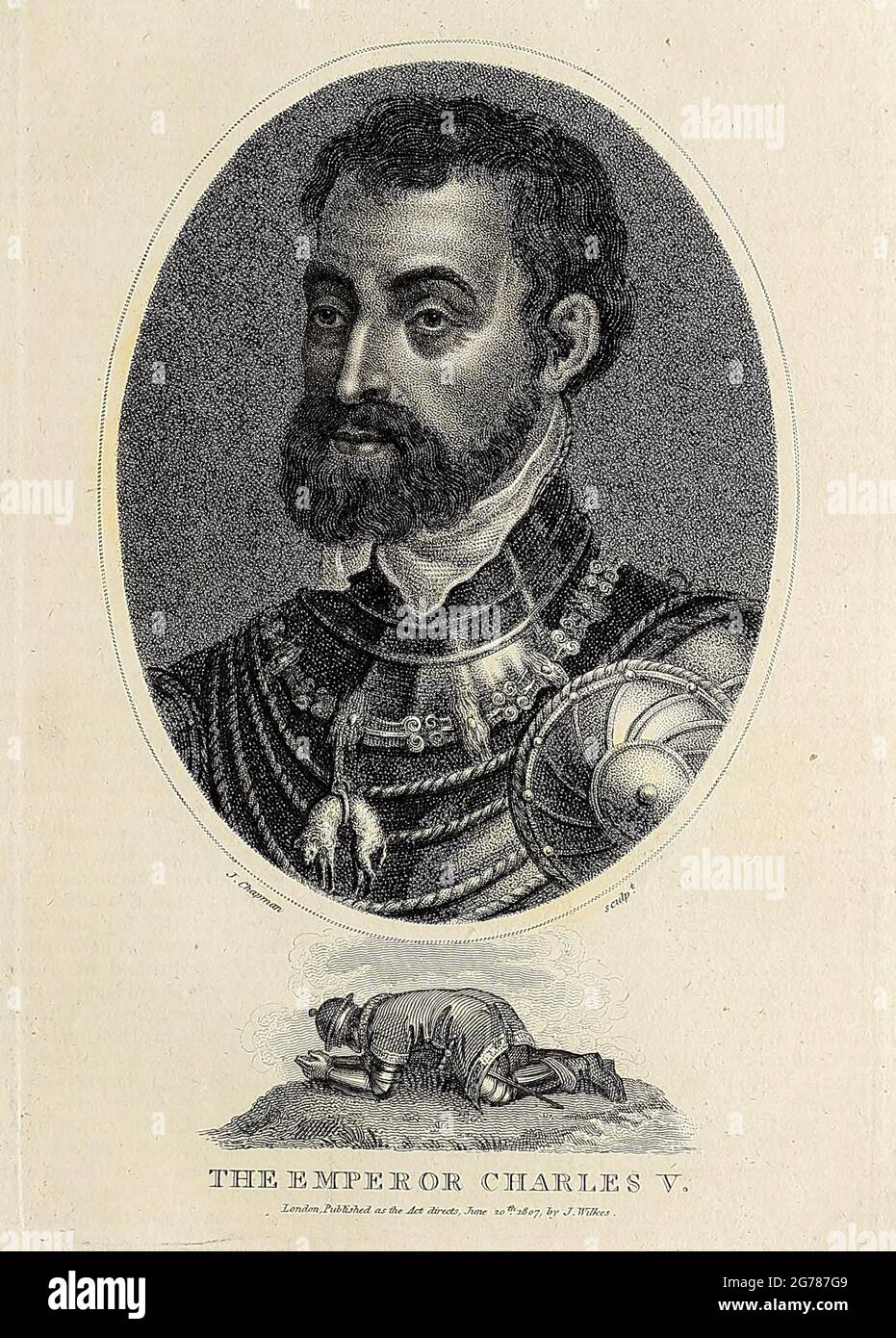 Charles V (24 February 1500 – 21 September 1558) was Holy Roman Emperor and Archduke of Austria from 1519 to 1556, King of Spain (Castile and Aragon) from 1516 to 1556, and Lord of the Netherlands as titular Duke of Burgundy from 1506 to 1555. As he was head of the rising House of Habsburg during the first half of the 16th century, his dominions in Europe included the Holy Roman Empire, extending from Germany to northern Italy with direct rule over the Austrian hereditary lands and the Burgundian Low Countries, and a unified Spain with its southern Italian kingdoms of Naples, Sicily, and Sardi Stock Photohttps://www.alamy.com/image-license-details/?v=1https://www.alamy.com/charles-v-24-february-1500-21-september-1558-was-holy-roman-emperor-and-archduke-of-austria-from-1519-to-1556-king-of-spain-castile-and-aragon-from-1516-to-1556-and-lord-of-the-netherlands-as-titular-duke-of-burgundy-from-1506-to-1555-as-he-was-head-of-the-rising-house-of-habsburg-during-the-first-half-of-the-16th-century-his-dominions-in-europe-included-the-holy-roman-empire-extending-from-germany-to-northern-italy-with-direct-rule-over-the-austrian-hereditary-lands-and-the-burgundian-low-countries-and-a-unified-spain-with-its-southern-italian-kingdoms-of-naples-sicily-and-sardi-image434743353.html
Charles V (24 February 1500 – 21 September 1558) was Holy Roman Emperor and Archduke of Austria from 1519 to 1556, King of Spain (Castile and Aragon) from 1516 to 1556, and Lord of the Netherlands as titular Duke of Burgundy from 1506 to 1555. As he was head of the rising House of Habsburg during the first half of the 16th century, his dominions in Europe included the Holy Roman Empire, extending from Germany to northern Italy with direct rule over the Austrian hereditary lands and the Burgundian Low Countries, and a unified Spain with its southern Italian kingdoms of Naples, Sicily, and Sardi Stock Photohttps://www.alamy.com/image-license-details/?v=1https://www.alamy.com/charles-v-24-february-1500-21-september-1558-was-holy-roman-emperor-and-archduke-of-austria-from-1519-to-1556-king-of-spain-castile-and-aragon-from-1516-to-1556-and-lord-of-the-netherlands-as-titular-duke-of-burgundy-from-1506-to-1555-as-he-was-head-of-the-rising-house-of-habsburg-during-the-first-half-of-the-16th-century-his-dominions-in-europe-included-the-holy-roman-empire-extending-from-germany-to-northern-italy-with-direct-rule-over-the-austrian-hereditary-lands-and-the-burgundian-low-countries-and-a-unified-spain-with-its-southern-italian-kingdoms-of-naples-sicily-and-sardi-image434743353.htmlRM2G787G9–Charles V (24 February 1500 – 21 September 1558) was Holy Roman Emperor and Archduke of Austria from 1519 to 1556, King of Spain (Castile and Aragon) from 1516 to 1556, and Lord of the Netherlands as titular Duke of Burgundy from 1506 to 1555. As he was head of the rising House of Habsburg during the first half of the 16th century, his dominions in Europe included the Holy Roman Empire, extending from Germany to northern Italy with direct rule over the Austrian hereditary lands and the Burgundian Low Countries, and a unified Spain with its southern Italian kingdoms of Naples, Sicily, and Sardi
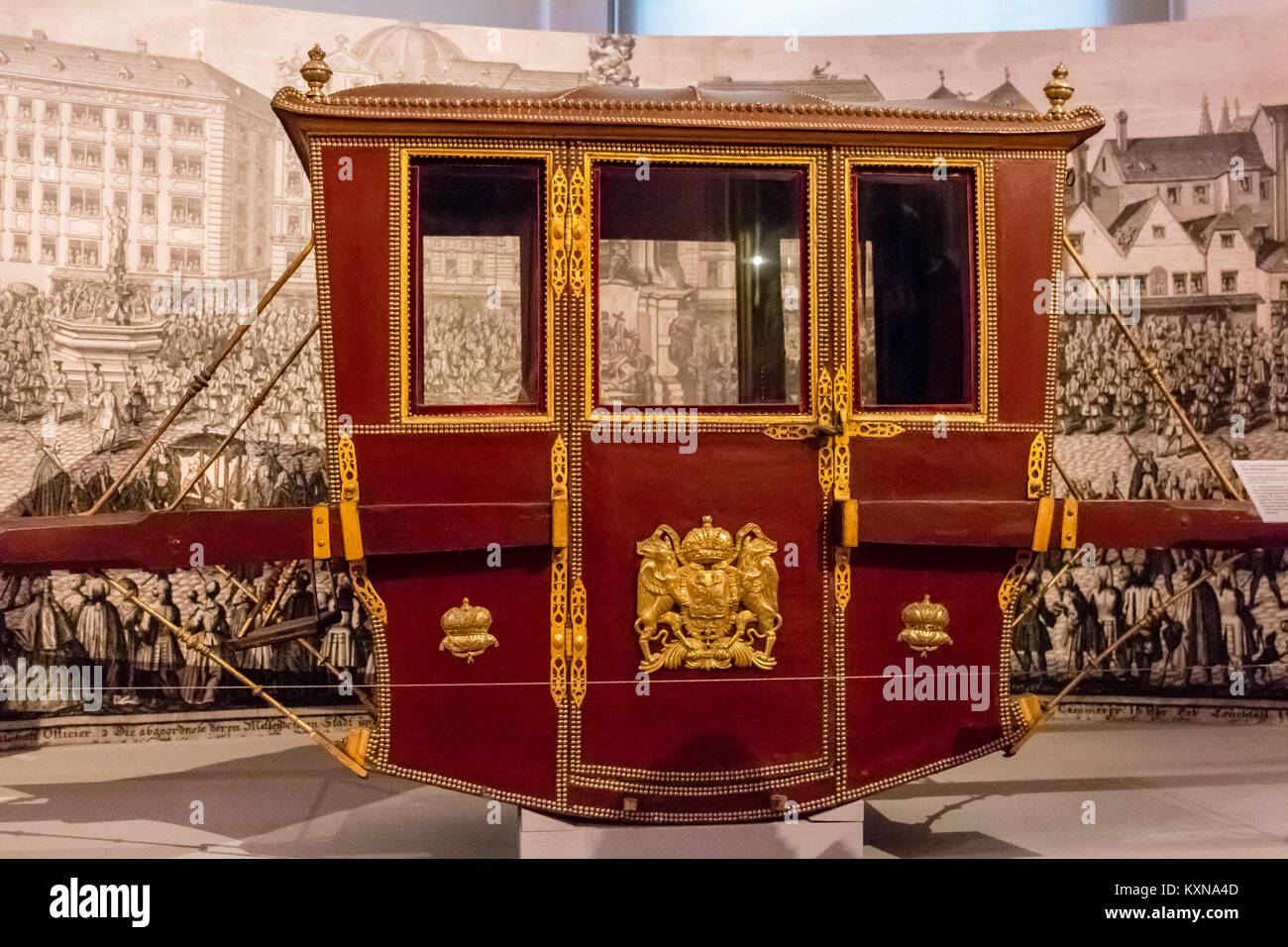 Sedan chair used by the Habsburg Monarchy, Imperial Carriage Museum, Schönbrunn, Vienna, Austria, Europe Stock Photohttps://www.alamy.com/image-license-details/?v=1https://www.alamy.com/stock-photo-sedan-chair-used-by-the-habsburg-monarchy-imperial-carriage-museum-171343325.html
Sedan chair used by the Habsburg Monarchy, Imperial Carriage Museum, Schönbrunn, Vienna, Austria, Europe Stock Photohttps://www.alamy.com/image-license-details/?v=1https://www.alamy.com/stock-photo-sedan-chair-used-by-the-habsburg-monarchy-imperial-carriage-museum-171343325.htmlRFKXNA4D–Sedan chair used by the Habsburg Monarchy, Imperial Carriage Museum, Schönbrunn, Vienna, Austria, Europe
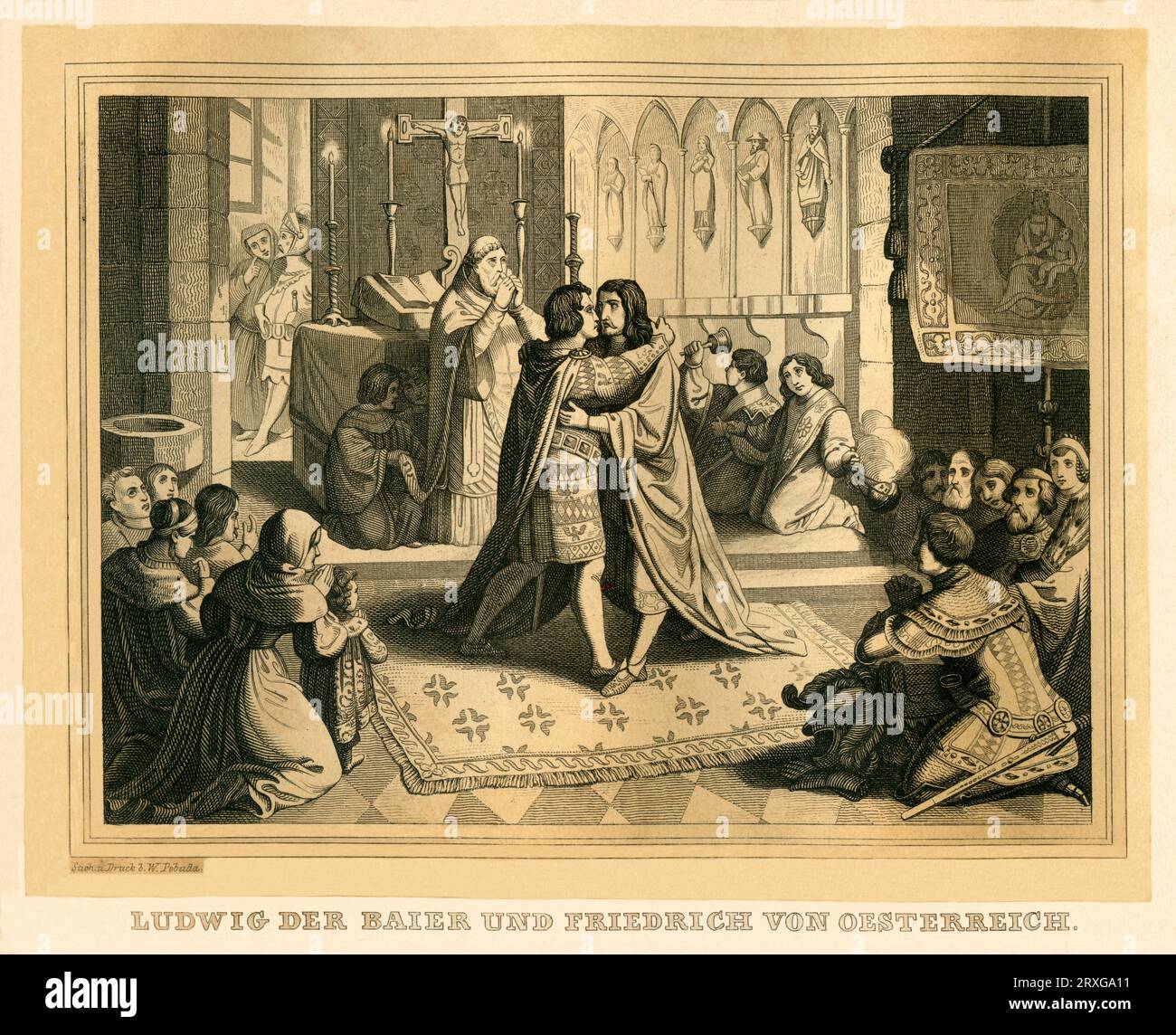 Europa, Versöhnung der beiden Fürsten Ludwig der Bayer und Friedrich von Österreich, Motiv aus : ' Historisch-Biographisches Universum ' . Eine Bilder-Chronik von denkwürdigen Ereignissen und berühmten Menschen, Artistischer Verlag von J. Scheible, Stuttgart, 1841 . / Europe, reconciliation of the prince Louis the Bavarian and the prince Frederick the Fair - house Habsburg - , image from : ' Historisch-Biographisches Universum ' . a picture chronicleof wellknown events and persons , publishing house : Artistischer Verlag J. Scheible, Stuttgart, 1841 . Stock Photohttps://www.alamy.com/image-license-details/?v=1https://www.alamy.com/europa-vershnung-der-beiden-frsten-ludwig-der-bayer-und-friedrich-von-sterreich-motiv-aus-historisch-biographisches-universum-eine-bilder-chronik-von-denkwrdigen-ereignissen-und-berhmten-menschen-artistischer-verlag-von-j-scheible-stuttgart-1841-europe-reconciliation-of-the-prince-louis-the-bavarian-and-the-prince-frederick-the-fair-house-habsburg-image-from-historisch-biographisches-universum-a-picture-chronicleof-wellknown-events-and-persons-publishing-house-artistischer-verlag-j-scheible-stuttgart-1841-image567071933.html
Europa, Versöhnung der beiden Fürsten Ludwig der Bayer und Friedrich von Österreich, Motiv aus : ' Historisch-Biographisches Universum ' . Eine Bilder-Chronik von denkwürdigen Ereignissen und berühmten Menschen, Artistischer Verlag von J. Scheible, Stuttgart, 1841 . / Europe, reconciliation of the prince Louis the Bavarian and the prince Frederick the Fair - house Habsburg - , image from : ' Historisch-Biographisches Universum ' . a picture chronicleof wellknown events and persons , publishing house : Artistischer Verlag J. Scheible, Stuttgart, 1841 . Stock Photohttps://www.alamy.com/image-license-details/?v=1https://www.alamy.com/europa-vershnung-der-beiden-frsten-ludwig-der-bayer-und-friedrich-von-sterreich-motiv-aus-historisch-biographisches-universum-eine-bilder-chronik-von-denkwrdigen-ereignissen-und-berhmten-menschen-artistischer-verlag-von-j-scheible-stuttgart-1841-europe-reconciliation-of-the-prince-louis-the-bavarian-and-the-prince-frederick-the-fair-house-habsburg-image-from-historisch-biographisches-universum-a-picture-chronicleof-wellknown-events-and-persons-publishing-house-artistischer-verlag-j-scheible-stuttgart-1841-image567071933.htmlRM2RXGA11–Europa, Versöhnung der beiden Fürsten Ludwig der Bayer und Friedrich von Österreich, Motiv aus : ' Historisch-Biographisches Universum ' . Eine Bilder-Chronik von denkwürdigen Ereignissen und berühmten Menschen, Artistischer Verlag von J. Scheible, Stuttgart, 1841 . / Europe, reconciliation of the prince Louis the Bavarian and the prince Frederick the Fair - house Habsburg - , image from : ' Historisch-Biographisches Universum ' . a picture chronicleof wellknown events and persons , publishing house : Artistischer Verlag J. Scheible, Stuttgart, 1841 .
 Groningen brought under the rule of the Habsburgs, in honor of Mary of Hungary, governor of the Netherlands, Copper Medal. Obverse: the letter M under the hand and the brace, above the year within the inscription. Reverse: double-headed eagle under crown holds diamond-shaped coat of arms in front of her inscription, Groningen (province), Charles V of Habsburg (German emperor and king of Spain), Mary of Hungary (governor of the Netherlands), anonymous, Netherlands, 1536, copper (metal), striking (metalworking), d 2.8 cm × w 4.21 gr, Reimagined by Gibon, design of warm cheerful glowing of bright Stock Photohttps://www.alamy.com/image-license-details/?v=1https://www.alamy.com/groningen-brought-under-the-rule-of-the-habsburgs-in-honor-of-mary-of-hungary-governor-of-the-netherlands-copper-medal-obverse-the-letter-m-under-the-hand-and-the-brace-above-the-year-within-the-inscription-reverse-double-headed-eagle-under-crown-holds-diamond-shaped-coat-of-arms-in-front-of-her-inscription-groningen-province-charles-v-of-habsburg-german-emperor-and-king-of-spain-mary-of-hungary-governor-of-the-netherlands-anonymous-netherlands-1536-copper-metal-striking-metalworking-d-28-cm-w-421-gr-reimagined-by-gibon-design-of-warm-cheerful-glowing-of-bright-image349991371.html
Groningen brought under the rule of the Habsburgs, in honor of Mary of Hungary, governor of the Netherlands, Copper Medal. Obverse: the letter M under the hand and the brace, above the year within the inscription. Reverse: double-headed eagle under crown holds diamond-shaped coat of arms in front of her inscription, Groningen (province), Charles V of Habsburg (German emperor and king of Spain), Mary of Hungary (governor of the Netherlands), anonymous, Netherlands, 1536, copper (metal), striking (metalworking), d 2.8 cm × w 4.21 gr, Reimagined by Gibon, design of warm cheerful glowing of bright Stock Photohttps://www.alamy.com/image-license-details/?v=1https://www.alamy.com/groningen-brought-under-the-rule-of-the-habsburgs-in-honor-of-mary-of-hungary-governor-of-the-netherlands-copper-medal-obverse-the-letter-m-under-the-hand-and-the-brace-above-the-year-within-the-inscription-reverse-double-headed-eagle-under-crown-holds-diamond-shaped-coat-of-arms-in-front-of-her-inscription-groningen-province-charles-v-of-habsburg-german-emperor-and-king-of-spain-mary-of-hungary-governor-of-the-netherlands-anonymous-netherlands-1536-copper-metal-striking-metalworking-d-28-cm-w-421-gr-reimagined-by-gibon-design-of-warm-cheerful-glowing-of-bright-image349991371.htmlRF2B9BDFR–Groningen brought under the rule of the Habsburgs, in honor of Mary of Hungary, governor of the Netherlands, Copper Medal. Obverse: the letter M under the hand and the brace, above the year within the inscription. Reverse: double-headed eagle under crown holds diamond-shaped coat of arms in front of her inscription, Groningen (province), Charles V of Habsburg (German emperor and king of Spain), Mary of Hungary (governor of the Netherlands), anonymous, Netherlands, 1536, copper (metal), striking (metalworking), d 2.8 cm × w 4.21 gr, Reimagined by Gibon, design of warm cheerful glowing of bright
 RECORD DATE NOT STATED the empire of austria can still be seen everywhere in austria and beyond the empire of austria can still be seen everywhere in austria Stock Photohttps://www.alamy.com/image-license-details/?v=1https://www.alamy.com/record-date-not-stated-the-empire-of-austria-can-still-be-seen-everywhere-in-austria-and-beyond-the-empire-of-austria-can-still-be-seen-everywhere-in-austria-image619469203.html
RECORD DATE NOT STATED the empire of austria can still be seen everywhere in austria and beyond the empire of austria can still be seen everywhere in austria Stock Photohttps://www.alamy.com/image-license-details/?v=1https://www.alamy.com/record-date-not-stated-the-empire-of-austria-can-still-be-seen-everywhere-in-austria-and-beyond-the-empire-of-austria-can-still-be-seen-everywhere-in-austria-image619469203.htmlRM2XYR783–RECORD DATE NOT STATED the empire of austria can still be seen everywhere in austria and beyond the empire of austria can still be seen everywhere in austria
 Portrait of Charles VII Albrecht in memory of his death in 1745, Jacob Andreas Fridrich (der Jungere), 1745 - 1779 Stock Photohttps://www.alamy.com/image-license-details/?v=1https://www.alamy.com/portrait-of-charles-vii-albrecht-in-memory-of-his-death-in-1745-jacob-andreas-fridrich-der-jungere-1745-1779-image570293525.html
Portrait of Charles VII Albrecht in memory of his death in 1745, Jacob Andreas Fridrich (der Jungere), 1745 - 1779 Stock Photohttps://www.alamy.com/image-license-details/?v=1https://www.alamy.com/portrait-of-charles-vii-albrecht-in-memory-of-his-death-in-1745-jacob-andreas-fridrich-der-jungere-1745-1779-image570293525.htmlRF2T3R35W–Portrait of Charles VII Albrecht in memory of his death in 1745, Jacob Andreas Fridrich (der Jungere), 1745 - 1779
 the empire of austria can still be seen everywhere in austria and beyond the empire of austria can still be seen everywhere in austria Stock Photohttps://www.alamy.com/image-license-details/?v=1https://www.alamy.com/the-empire-of-austria-can-still-be-seen-everywhere-in-austria-and-beyond-the-empire-of-austria-can-still-be-seen-everywhere-in-austria-image619963954.html
the empire of austria can still be seen everywhere in austria and beyond the empire of austria can still be seen everywhere in austria Stock Photohttps://www.alamy.com/image-license-details/?v=1https://www.alamy.com/the-empire-of-austria-can-still-be-seen-everywhere-in-austria-and-beyond-the-empire-of-austria-can-still-be-seen-everywhere-in-austria-image619963954.htmlRM2Y0HP9P–the empire of austria can still be seen everywhere in austria and beyond the empire of austria can still be seen everywhere in austria
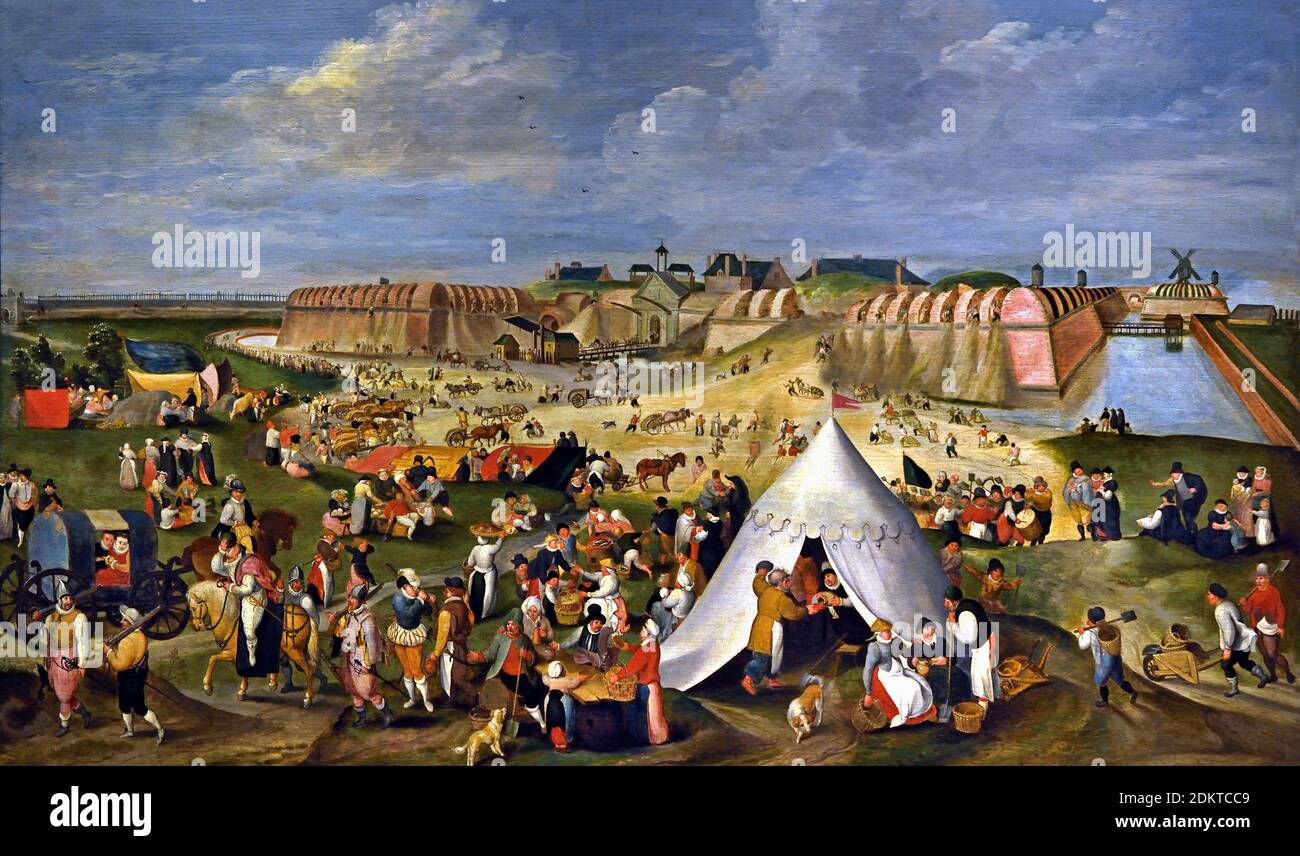 The demolition of the citadel of Antwerp in August 1577, Control the rebellious cities in the Netherlands, Duke of Alva the military manager Flips II building citadels or fortresses. The Antwerpers conquered the citadel of their city from the Spaniards in 1577. Pieter Balten. 1525 - 1598 after Maarten van Cleve 1527 - 1581 Flemish Renaissance painter Belgium Holland . The Dutch Revolt 1566–1648 Low Countries against the rule of the Habsburg King Philip II of Spain Eighty Years, War, Spanish, Dutch, Netherlands, Eighty Years' War, (1568–1648), war of Netherlands independence from Spain, Stock Photohttps://www.alamy.com/image-license-details/?v=1https://www.alamy.com/the-demolition-of-the-citadel-of-antwerp-in-august-1577-control-the-rebellious-cities-in-the-netherlands-duke-of-alva-the-military-manager-flips-ii-building-citadels-or-fortresses-the-antwerpers-conquered-the-citadel-of-their-city-from-the-spaniards-in-1577-pieter-balten-1525-1598-after-maarten-van-cleve-1527-1581-flemish-renaissance-painter-belgium-holland-the-dutch-revolt-15661648-low-countries-against-the-rule-of-the-habsburg-king-philip-ii-of-spain-eighty-years-war-spanish-dutch-netherlands-eighty-years-war-15681648-war-of-netherlands-independence-from-spain-image390843161.html
The demolition of the citadel of Antwerp in August 1577, Control the rebellious cities in the Netherlands, Duke of Alva the military manager Flips II building citadels or fortresses. The Antwerpers conquered the citadel of their city from the Spaniards in 1577. Pieter Balten. 1525 - 1598 after Maarten van Cleve 1527 - 1581 Flemish Renaissance painter Belgium Holland . The Dutch Revolt 1566–1648 Low Countries against the rule of the Habsburg King Philip II of Spain Eighty Years, War, Spanish, Dutch, Netherlands, Eighty Years' War, (1568–1648), war of Netherlands independence from Spain, Stock Photohttps://www.alamy.com/image-license-details/?v=1https://www.alamy.com/the-demolition-of-the-citadel-of-antwerp-in-august-1577-control-the-rebellious-cities-in-the-netherlands-duke-of-alva-the-military-manager-flips-ii-building-citadels-or-fortresses-the-antwerpers-conquered-the-citadel-of-their-city-from-the-spaniards-in-1577-pieter-balten-1525-1598-after-maarten-van-cleve-1527-1581-flemish-renaissance-painter-belgium-holland-the-dutch-revolt-15661648-low-countries-against-the-rule-of-the-habsburg-king-philip-ii-of-spain-eighty-years-war-spanish-dutch-netherlands-eighty-years-war-15681648-war-of-netherlands-independence-from-spain-image390843161.htmlRM2DKTCC9–The demolition of the citadel of Antwerp in August 1577, Control the rebellious cities in the Netherlands, Duke of Alva the military manager Flips II building citadels or fortresses. The Antwerpers conquered the citadel of their city from the Spaniards in 1577. Pieter Balten. 1525 - 1598 after Maarten van Cleve 1527 - 1581 Flemish Renaissance painter Belgium Holland . The Dutch Revolt 1566–1648 Low Countries against the rule of the Habsburg King Philip II of Spain Eighty Years, War, Spanish, Dutch, Netherlands, Eighty Years' War, (1568–1648), war of Netherlands independence from Spain,
 William of Orange-Nassau (1533-1584) called the Taciturn. A member of the House of Nassau, he became Prince of Orange in 1544. Joined the rebellion against the rule of the Habsburg king Philip II of Spain. Portrait. Engraving, detail. Wars of Flanders. Edition published in Antwerp, 1748. Stock Photohttps://www.alamy.com/image-license-details/?v=1https://www.alamy.com/william-of-orange-nassau-1533-1584-called-the-taciturn-a-member-of-the-house-of-nassau-he-became-prince-of-orange-in-1544-joined-the-rebellion-against-the-rule-of-the-habsburg-king-philip-ii-of-spain-portrait-engraving-detail-wars-of-flanders-edition-published-in-antwerp-1748-image425944430.html
William of Orange-Nassau (1533-1584) called the Taciturn. A member of the House of Nassau, he became Prince of Orange in 1544. Joined the rebellion against the rule of the Habsburg king Philip II of Spain. Portrait. Engraving, detail. Wars of Flanders. Edition published in Antwerp, 1748. Stock Photohttps://www.alamy.com/image-license-details/?v=1https://www.alamy.com/william-of-orange-nassau-1533-1584-called-the-taciturn-a-member-of-the-house-of-nassau-he-became-prince-of-orange-in-1544-joined-the-rebellion-against-the-rule-of-the-habsburg-king-philip-ii-of-spain-portrait-engraving-detail-wars-of-flanders-edition-published-in-antwerp-1748-image425944430.htmlRM2FMYCD2–William of Orange-Nassau (1533-1584) called the Taciturn. A member of the House of Nassau, he became Prince of Orange in 1544. Joined the rebellion against the rule of the Habsburg king Philip II of Spain. Portrait. Engraving, detail. Wars of Flanders. Edition published in Antwerp, 1748.
 Charles I or Karl I (1887 ? 1922) Emperor of Austria, King of Hungary and the last of the monarchs belonging to the House of Habsburg-Lorraine to rule over Austria-Hungary. Charles became heir presumptive of Emperor Franz Joseph when his uncle Archduke Franz Ferdinand of Austria was assassinated in 1914. He reigned from November 1916 ? November 1918. Stock Photohttps://www.alamy.com/image-license-details/?v=1https://www.alamy.com/charles-i-or-karl-i-1887-1922-emperor-of-austria-king-of-hungary-and-the-last-of-the-monarchs-belonging-to-the-house-of-habsburg-lorraine-to-rule-over-austria-hungary-charles-became-heir-presumptive-of-emperor-franz-joseph-when-his-uncle-archduke-franz-ferdinand-of-austria-was-assassinated-in-1914-he-reigned-from-november-1916-november-1918-image634318559.html
Charles I or Karl I (1887 ? 1922) Emperor of Austria, King of Hungary and the last of the monarchs belonging to the House of Habsburg-Lorraine to rule over Austria-Hungary. Charles became heir presumptive of Emperor Franz Joseph when his uncle Archduke Franz Ferdinand of Austria was assassinated in 1914. He reigned from November 1916 ? November 1918. Stock Photohttps://www.alamy.com/image-license-details/?v=1https://www.alamy.com/charles-i-or-karl-i-1887-1922-emperor-of-austria-king-of-hungary-and-the-last-of-the-monarchs-belonging-to-the-house-of-habsburg-lorraine-to-rule-over-austria-hungary-charles-became-heir-presumptive-of-emperor-franz-joseph-when-his-uncle-archduke-franz-ferdinand-of-austria-was-assassinated-in-1914-he-reigned-from-november-1916-november-1918-image634318559.htmlRM2YRYKP7–Charles I or Karl I (1887 ? 1922) Emperor of Austria, King of Hungary and the last of the monarchs belonging to the House of Habsburg-Lorraine to rule over Austria-Hungary. Charles became heir presumptive of Emperor Franz Joseph when his uncle Archduke Franz Ferdinand of Austria was assassinated in 1914. He reigned from November 1916 ? November 1918.
 Frederick III (1415-1493), also known as Frederick the Fat and Frederick the Peaceful, was the eldest son of the Inner Austrian duke Ernest the Iron, a member of the Habsburg dynasty. He became duke of Inner Austria in 1424 at the age of nine, but would not rule until 1435, with his younger brother Albert asserting his rights as co-ruler. By 1439, Frederick had become the undisputed head of the Habsburg dynasty. Stock Photohttps://www.alamy.com/image-license-details/?v=1https://www.alamy.com/frederick-iii-1415-1493-also-known-as-frederick-the-fat-and-frederick-the-peaceful-was-the-eldest-son-of-the-inner-austrian-duke-ernest-the-iron-a-member-of-the-habsburg-dynasty-he-became-duke-of-inner-austria-in-1424-at-the-age-of-nine-but-would-not-rule-until-1435-with-his-younger-brother-albert-asserting-his-rights-as-co-ruler-by-1439-frederick-had-become-the-undisputed-head-of-the-habsburg-dynasty-image344281994.html
Frederick III (1415-1493), also known as Frederick the Fat and Frederick the Peaceful, was the eldest son of the Inner Austrian duke Ernest the Iron, a member of the Habsburg dynasty. He became duke of Inner Austria in 1424 at the age of nine, but would not rule until 1435, with his younger brother Albert asserting his rights as co-ruler. By 1439, Frederick had become the undisputed head of the Habsburg dynasty. Stock Photohttps://www.alamy.com/image-license-details/?v=1https://www.alamy.com/frederick-iii-1415-1493-also-known-as-frederick-the-fat-and-frederick-the-peaceful-was-the-eldest-son-of-the-inner-austrian-duke-ernest-the-iron-a-member-of-the-habsburg-dynasty-he-became-duke-of-inner-austria-in-1424-at-the-age-of-nine-but-would-not-rule-until-1435-with-his-younger-brother-albert-asserting-his-rights-as-co-ruler-by-1439-frederick-had-become-the-undisputed-head-of-the-habsburg-dynasty-image344281994.htmlRM2B03B5E–Frederick III (1415-1493), also known as Frederick the Fat and Frederick the Peaceful, was the eldest son of the Inner Austrian duke Ernest the Iron, a member of the Habsburg dynasty. He became duke of Inner Austria in 1424 at the age of nine, but would not rule until 1435, with his younger brother Albert asserting his rights as co-ruler. By 1439, Frederick had become the undisputed head of the Habsburg dynasty.
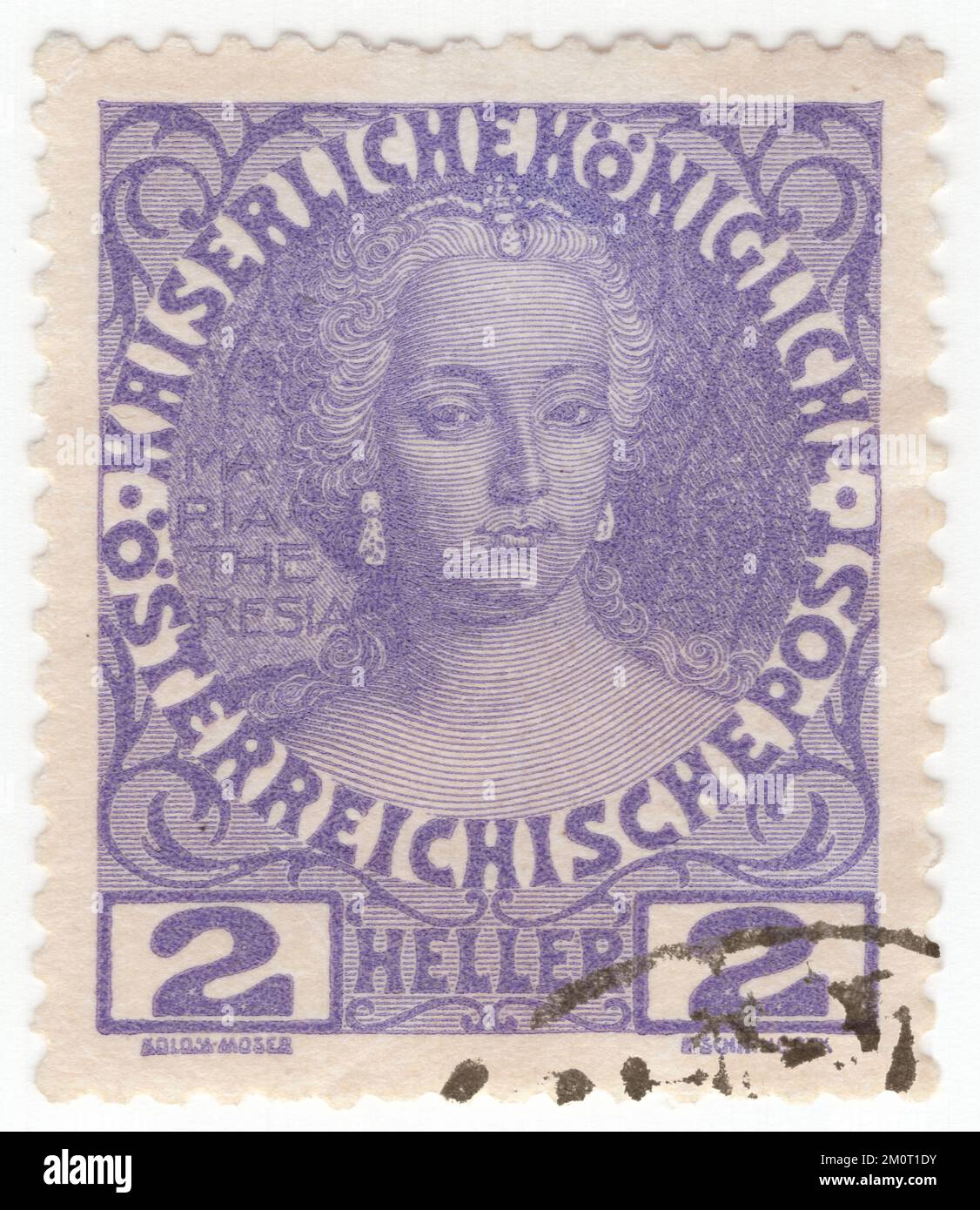 AUSTRIA — 1908: An 2 heller violet postage stamp depicting portrait of Maria Theresa. Definitive set issued for the 60th year of the reign of Austrian Monarch Franz Josef, Emperor of Austria, King of Hungary, and the other states of the Habsburg monarchy. Maria Theresa Walburga Amalia Christina was ruler of the Habsburg dominions from 1740 until her death in 1780, and the only woman to hold the position suo jure (in her own right). She was the sovereign of Austria, Hungary, Croatia, Bohemia, Transylvania, Mantua, Milan, Lodomeria and Galicia, the Austrian Netherlands, and Parma Stock Photohttps://www.alamy.com/image-license-details/?v=1https://www.alamy.com/austria-1908-an-2-heller-violet-postage-stamp-depicting-portrait-of-maria-theresa-definitive-set-issued-for-the-60th-year-of-the-reign-of-austrian-monarch-franz-josef-emperor-of-austria-king-of-hungary-and-the-other-states-of-the-habsburg-monarchy-maria-theresa-walburga-amalia-christina-was-ruler-of-the-habsburg-dominions-from-1740-until-her-death-in-1780-and-the-only-woman-to-hold-the-position-suo-jure-in-her-own-right-she-was-the-sovereign-of-austria-hungary-croatia-bohemia-transylvania-mantua-milan-lodomeria-and-galicia-the-austrian-netherlands-and-parma-image499628695.html
AUSTRIA — 1908: An 2 heller violet postage stamp depicting portrait of Maria Theresa. Definitive set issued for the 60th year of the reign of Austrian Monarch Franz Josef, Emperor of Austria, King of Hungary, and the other states of the Habsburg monarchy. Maria Theresa Walburga Amalia Christina was ruler of the Habsburg dominions from 1740 until her death in 1780, and the only woman to hold the position suo jure (in her own right). She was the sovereign of Austria, Hungary, Croatia, Bohemia, Transylvania, Mantua, Milan, Lodomeria and Galicia, the Austrian Netherlands, and Parma Stock Photohttps://www.alamy.com/image-license-details/?v=1https://www.alamy.com/austria-1908-an-2-heller-violet-postage-stamp-depicting-portrait-of-maria-theresa-definitive-set-issued-for-the-60th-year-of-the-reign-of-austrian-monarch-franz-josef-emperor-of-austria-king-of-hungary-and-the-other-states-of-the-habsburg-monarchy-maria-theresa-walburga-amalia-christina-was-ruler-of-the-habsburg-dominions-from-1740-until-her-death-in-1780-and-the-only-woman-to-hold-the-position-suo-jure-in-her-own-right-she-was-the-sovereign-of-austria-hungary-croatia-bohemia-transylvania-mantua-milan-lodomeria-and-galicia-the-austrian-netherlands-and-parma-image499628695.htmlRF2M0T1DY–AUSTRIA — 1908: An 2 heller violet postage stamp depicting portrait of Maria Theresa. Definitive set issued for the 60th year of the reign of Austrian Monarch Franz Josef, Emperor of Austria, King of Hungary, and the other states of the Habsburg monarchy. Maria Theresa Walburga Amalia Christina was ruler of the Habsburg dominions from 1740 until her death in 1780, and the only woman to hold the position suo jure (in her own right). She was the sovereign of Austria, Hungary, Croatia, Bohemia, Transylvania, Mantua, Milan, Lodomeria and Galicia, the Austrian Netherlands, and Parma
 Portrait of Charles VII Albrecht and Maria Amalia in Two Medallions in Allegorical Frame, Jacob Andreas Fridrich (der Jungere), 1742 - 1745 Stock Photohttps://www.alamy.com/image-license-details/?v=1https://www.alamy.com/portrait-of-charles-vii-albrecht-and-maria-amalia-in-two-medallions-in-allegorical-frame-jacob-andreas-fridrich-der-jungere-1742-1745-image570302979.html
Portrait of Charles VII Albrecht and Maria Amalia in Two Medallions in Allegorical Frame, Jacob Andreas Fridrich (der Jungere), 1742 - 1745 Stock Photohttps://www.alamy.com/image-license-details/?v=1https://www.alamy.com/portrait-of-charles-vii-albrecht-and-maria-amalia-in-two-medallions-in-allegorical-frame-jacob-andreas-fridrich-der-jungere-1742-1745-image570302979.htmlRF2T3RF7F–Portrait of Charles VII Albrecht and Maria Amalia in Two Medallions in Allegorical Frame, Jacob Andreas Fridrich (der Jungere), 1742 - 1745
 the empire of austria can still be seen everywhere in austria and beyond the empire of austria can still be seen everywhere in austria Stock Photohttps://www.alamy.com/image-license-details/?v=1https://www.alamy.com/the-empire-of-austria-can-still-be-seen-everywhere-in-austria-and-beyond-the-empire-of-austria-can-still-be-seen-everywhere-in-austria-image619468890.html
the empire of austria can still be seen everywhere in austria and beyond the empire of austria can still be seen everywhere in austria Stock Photohttps://www.alamy.com/image-license-details/?v=1https://www.alamy.com/the-empire-of-austria-can-still-be-seen-everywhere-in-austria-and-beyond-the-empire-of-austria-can-still-be-seen-everywhere-in-austria-image619468890.htmlRM2XYR6TX–the empire of austria can still be seen everywhere in austria and beyond the empire of austria can still be seen everywhere in austria
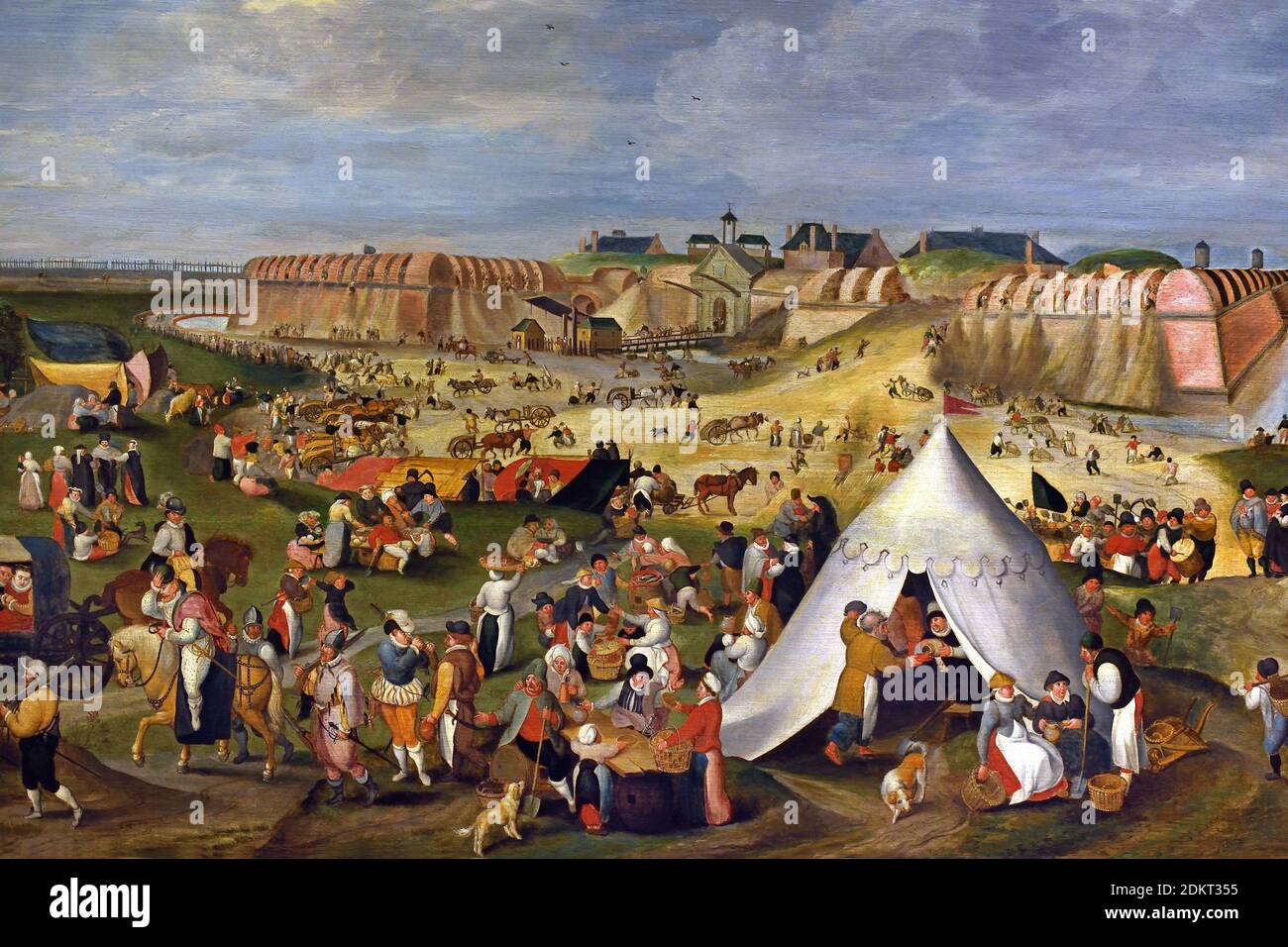 The demolition of the citadel of Antwerp in August 1577, Control the rebellious cities in the Netherlands, Duke of Alva the military manager Flips II building citadels or fortresses. The Antwerpers conquered the citadel of their city from the Spaniards in 1577. Pieter Balten. 1525 - 1598 after Maarten van Cleve 1527 - 1581 Flemish Renaissance painter Belgium Holland . The Dutch Revolt 1566–1648 Low Countries against the rule of the Habsburg King Philip II of Spain Eighty Years, War, Spanish, Dutch, Netherlands, Eighty Years' War, (1568–1648), war of Netherlands independence from Spain, Stock Photohttps://www.alamy.com/image-license-details/?v=1https://www.alamy.com/the-demolition-of-the-citadel-of-antwerp-in-august-1577-control-the-rebellious-cities-in-the-netherlands-duke-of-alva-the-military-manager-flips-ii-building-citadels-or-fortresses-the-antwerpers-conquered-the-citadel-of-their-city-from-the-spaniards-in-1577-pieter-balten-1525-1598-after-maarten-van-cleve-1527-1581-flemish-renaissance-painter-belgium-holland-the-dutch-revolt-15661648-low-countries-against-the-rule-of-the-habsburg-king-philip-ii-of-spain-eighty-years-war-spanish-dutch-netherlands-eighty-years-war-15681648-war-of-netherlands-independence-from-spain-image390835905.html
The demolition of the citadel of Antwerp in August 1577, Control the rebellious cities in the Netherlands, Duke of Alva the military manager Flips II building citadels or fortresses. The Antwerpers conquered the citadel of their city from the Spaniards in 1577. Pieter Balten. 1525 - 1598 after Maarten van Cleve 1527 - 1581 Flemish Renaissance painter Belgium Holland . The Dutch Revolt 1566–1648 Low Countries against the rule of the Habsburg King Philip II of Spain Eighty Years, War, Spanish, Dutch, Netherlands, Eighty Years' War, (1568–1648), war of Netherlands independence from Spain, Stock Photohttps://www.alamy.com/image-license-details/?v=1https://www.alamy.com/the-demolition-of-the-citadel-of-antwerp-in-august-1577-control-the-rebellious-cities-in-the-netherlands-duke-of-alva-the-military-manager-flips-ii-building-citadels-or-fortresses-the-antwerpers-conquered-the-citadel-of-their-city-from-the-spaniards-in-1577-pieter-balten-1525-1598-after-maarten-van-cleve-1527-1581-flemish-renaissance-painter-belgium-holland-the-dutch-revolt-15661648-low-countries-against-the-rule-of-the-habsburg-king-philip-ii-of-spain-eighty-years-war-spanish-dutch-netherlands-eighty-years-war-15681648-war-of-netherlands-independence-from-spain-image390835905.htmlRM2DKT355–The demolition of the citadel of Antwerp in August 1577, Control the rebellious cities in the Netherlands, Duke of Alva the military manager Flips II building citadels or fortresses. The Antwerpers conquered the citadel of their city from the Spaniards in 1577. Pieter Balten. 1525 - 1598 after Maarten van Cleve 1527 - 1581 Flemish Renaissance painter Belgium Holland . The Dutch Revolt 1566–1648 Low Countries against the rule of the Habsburg King Philip II of Spain Eighty Years, War, Spanish, Dutch, Netherlands, Eighty Years' War, (1568–1648), war of Netherlands independence from Spain,
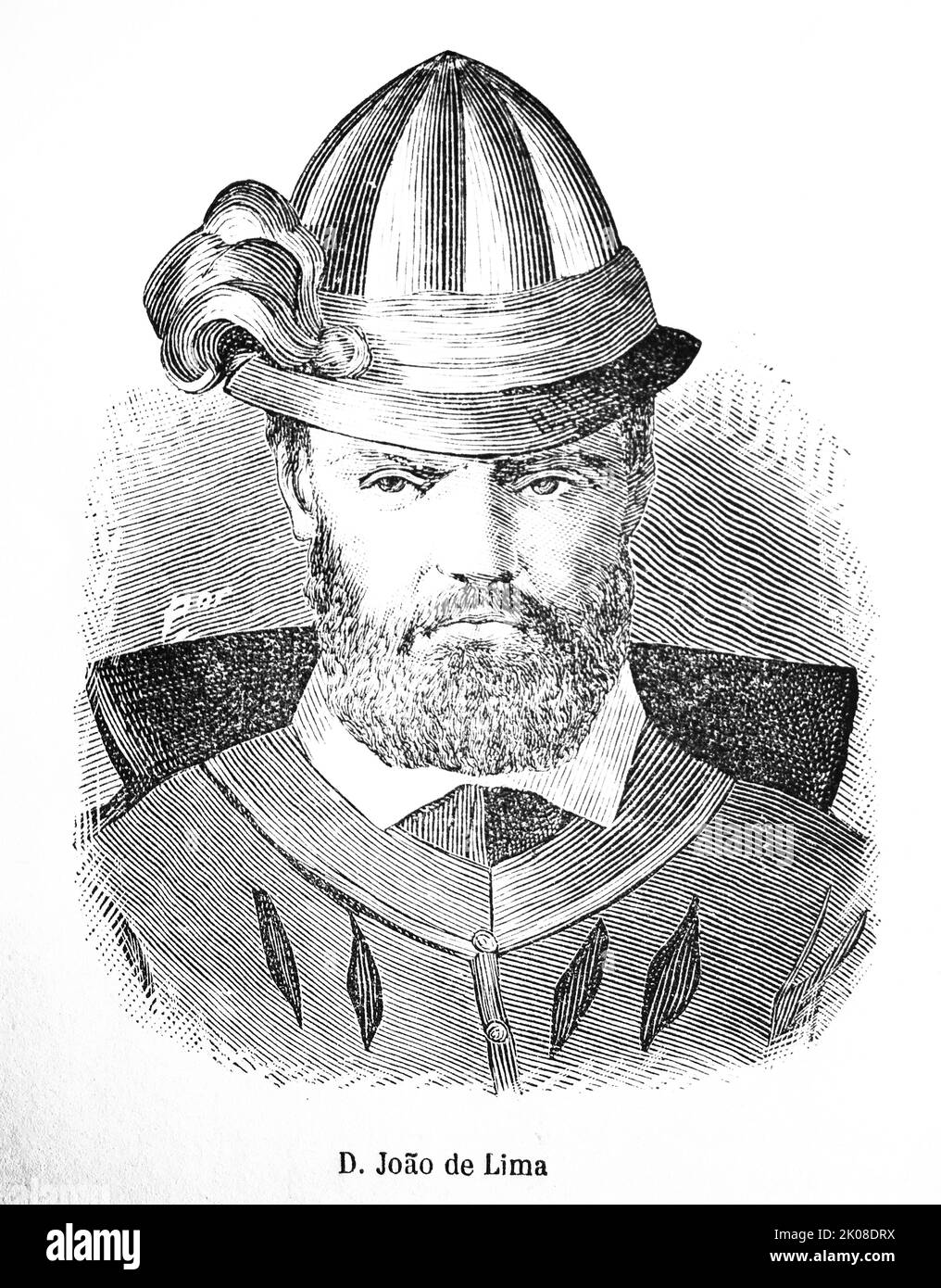 John IV (19 March 1604 - 6 November 1656), nicknamed John the Restorer, was the King of Portugal whose reign, lasting from 1640 until his death, began the Portuguese restoration of independence from Habsburg Spanish rule. His accession established the House of Braganza on the Portuguese throne, and marked the end of the 60-year-old Iberian Union by which Portugal and Spain shared the same monarch Stock Photohttps://www.alamy.com/image-license-details/?v=1https://www.alamy.com/john-iv-19-march-1604-6-november-1656-nicknamed-john-the-restorer-was-the-king-of-portugal-whose-reign-lasting-from-1640-until-his-death-began-the-portuguese-restoration-of-independence-from-habsburg-spanish-rule-his-accession-established-the-house-of-braganza-on-the-portuguese-throne-and-marked-the-end-of-the-60-year-old-iberian-union-by-which-portugal-and-spain-shared-the-same-monarch-image482076782.html
John IV (19 March 1604 - 6 November 1656), nicknamed John the Restorer, was the King of Portugal whose reign, lasting from 1640 until his death, began the Portuguese restoration of independence from Habsburg Spanish rule. His accession established the House of Braganza on the Portuguese throne, and marked the end of the 60-year-old Iberian Union by which Portugal and Spain shared the same monarch Stock Photohttps://www.alamy.com/image-license-details/?v=1https://www.alamy.com/john-iv-19-march-1604-6-november-1656-nicknamed-john-the-restorer-was-the-king-of-portugal-whose-reign-lasting-from-1640-until-his-death-began-the-portuguese-restoration-of-independence-from-habsburg-spanish-rule-his-accession-established-the-house-of-braganza-on-the-portuguese-throne-and-marked-the-end-of-the-60-year-old-iberian-union-by-which-portugal-and-spain-shared-the-same-monarch-image482076782.htmlRM2K08DRX–John IV (19 March 1604 - 6 November 1656), nicknamed John the Restorer, was the King of Portugal whose reign, lasting from 1640 until his death, began the Portuguese restoration of independence from Habsburg Spanish rule. His accession established the House of Braganza on the Portuguese throne, and marked the end of the 60-year-old Iberian Union by which Portugal and Spain shared the same monarch
 Frederick III (1415-1493), also known as Frederick the Fat and Frederick the Peaceful, was the eldest son of the Inner Austrian duke Ernest the Iron, a member of the Habsburg dynasty. He became duke of Inner Austria in 1424 at the age of nine, but would not rule until 1435, with his younger brother Albert asserting his rights as co-ruler. By 1439, Frederick had become the undisputed head of the Habsburg dynasty. Stock Photohttps://www.alamy.com/image-license-details/?v=1https://www.alamy.com/frederick-iii-1415-1493-also-known-as-frederick-the-fat-and-frederick-the-peaceful-was-the-eldest-son-of-the-inner-austrian-duke-ernest-the-iron-a-member-of-the-habsburg-dynasty-he-became-duke-of-inner-austria-in-1424-at-the-age-of-nine-but-would-not-rule-until-1435-with-his-younger-brother-albert-asserting-his-rights-as-co-ruler-by-1439-frederick-had-become-the-undisputed-head-of-the-habsburg-dynasty-image344281991.html
Frederick III (1415-1493), also known as Frederick the Fat and Frederick the Peaceful, was the eldest son of the Inner Austrian duke Ernest the Iron, a member of the Habsburg dynasty. He became duke of Inner Austria in 1424 at the age of nine, but would not rule until 1435, with his younger brother Albert asserting his rights as co-ruler. By 1439, Frederick had become the undisputed head of the Habsburg dynasty. Stock Photohttps://www.alamy.com/image-license-details/?v=1https://www.alamy.com/frederick-iii-1415-1493-also-known-as-frederick-the-fat-and-frederick-the-peaceful-was-the-eldest-son-of-the-inner-austrian-duke-ernest-the-iron-a-member-of-the-habsburg-dynasty-he-became-duke-of-inner-austria-in-1424-at-the-age-of-nine-but-would-not-rule-until-1435-with-his-younger-brother-albert-asserting-his-rights-as-co-ruler-by-1439-frederick-had-become-the-undisputed-head-of-the-habsburg-dynasty-image344281991.htmlRM2B03B5B–Frederick III (1415-1493), also known as Frederick the Fat and Frederick the Peaceful, was the eldest son of the Inner Austrian duke Ernest the Iron, a member of the Habsburg dynasty. He became duke of Inner Austria in 1424 at the age of nine, but would not rule until 1435, with his younger brother Albert asserting his rights as co-ruler. By 1439, Frederick had become the undisputed head of the Habsburg dynasty.
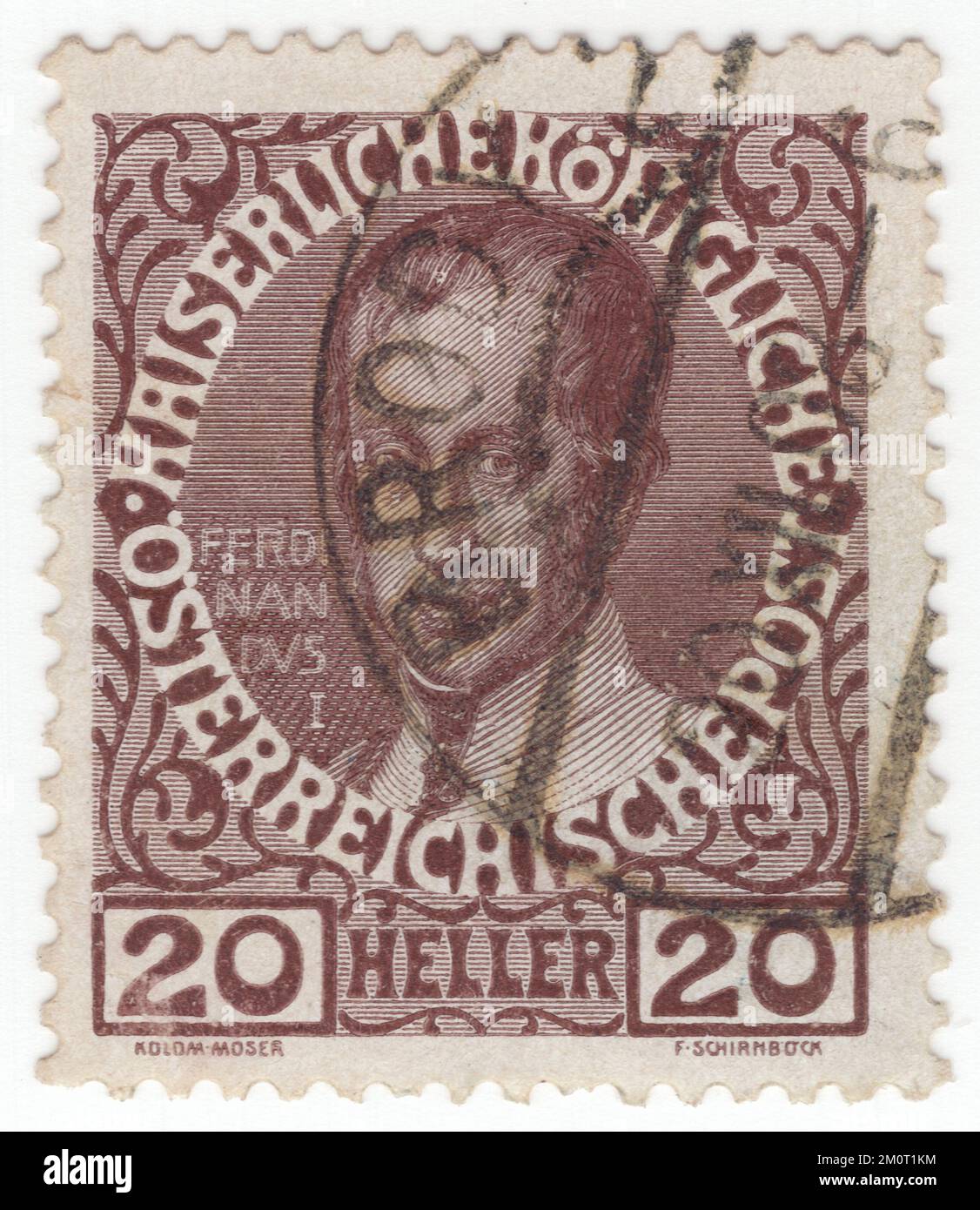 AUSTRIA - 1913: An 20 heller chocolate postage stamp depicting a portrait of Ferdinand I. Definitive set issued for the 60th year of the reign of Austrian Monarch Franz Josef, Emperor of Austria, King of Hungary, and the other states of the Habsburg monarchy. Ferdinand I was the Emperor of Austria from March 1835 until his abdication in December 1848. He was also King of Hungary, Croatia and Bohemia (as Ferdinand V), King of Lombardy–Venetia and holder of many other lesser titles. Due to his passive but well-intentioned character, he gained the sobriquet The Benign or The Benevolent Stock Photohttps://www.alamy.com/image-license-details/?v=1https://www.alamy.com/austria-1913-an-20-heller-chocolate-postage-stamp-depicting-a-portrait-of-ferdinand-i-definitive-set-issued-for-the-60th-year-of-the-reign-of-austrian-monarch-franz-josef-emperor-of-austria-king-of-hungary-and-the-other-states-of-the-habsburg-monarchy-ferdinand-i-was-the-emperor-of-austria-from-march-1835-until-his-abdication-in-december-1848-he-was-also-king-of-hungary-croatia-and-bohemia-as-ferdinand-v-king-of-lombardyvenetia-and-holder-of-many-other-lesser-titles-due-to-his-passive-but-well-intentioned-character-he-gained-the-sobriquet-the-benign-or-the-benevolent-image499628856.html
AUSTRIA - 1913: An 20 heller chocolate postage stamp depicting a portrait of Ferdinand I. Definitive set issued for the 60th year of the reign of Austrian Monarch Franz Josef, Emperor of Austria, King of Hungary, and the other states of the Habsburg monarchy. Ferdinand I was the Emperor of Austria from March 1835 until his abdication in December 1848. He was also King of Hungary, Croatia and Bohemia (as Ferdinand V), King of Lombardy–Venetia and holder of many other lesser titles. Due to his passive but well-intentioned character, he gained the sobriquet The Benign or The Benevolent Stock Photohttps://www.alamy.com/image-license-details/?v=1https://www.alamy.com/austria-1913-an-20-heller-chocolate-postage-stamp-depicting-a-portrait-of-ferdinand-i-definitive-set-issued-for-the-60th-year-of-the-reign-of-austrian-monarch-franz-josef-emperor-of-austria-king-of-hungary-and-the-other-states-of-the-habsburg-monarchy-ferdinand-i-was-the-emperor-of-austria-from-march-1835-until-his-abdication-in-december-1848-he-was-also-king-of-hungary-croatia-and-bohemia-as-ferdinand-v-king-of-lombardyvenetia-and-holder-of-many-other-lesser-titles-due-to-his-passive-but-well-intentioned-character-he-gained-the-sobriquet-the-benign-or-the-benevolent-image499628856.htmlRF2M0T1KM–AUSTRIA - 1913: An 20 heller chocolate postage stamp depicting a portrait of Ferdinand I. Definitive set issued for the 60th year of the reign of Austrian Monarch Franz Josef, Emperor of Austria, King of Hungary, and the other states of the Habsburg monarchy. Ferdinand I was the Emperor of Austria from March 1835 until his abdication in December 1848. He was also King of Hungary, Croatia and Bohemia (as Ferdinand V), King of Lombardy–Venetia and holder of many other lesser titles. Due to his passive but well-intentioned character, he gained the sobriquet The Benign or The Benevolent
 Frederick III (1415-1493), also known as Frederick the Fat and Frederick the Peaceful, was the eldest son of the Inner Austrian duke Ernest the Iron, a member of the Habsburg dynasty. He became duke of Inner Austria in 1424 at the age of nine, but would not rule until 1435, with his younger brother Albert asserting his rights as co-ruler. By 1439, Frederick had become the undisputed head of the Habsburg dynasty. Stock Photohttps://www.alamy.com/image-license-details/?v=1https://www.alamy.com/frederick-iii-1415-1493-also-known-as-frederick-the-fat-and-frederick-the-peaceful-was-the-eldest-son-of-the-inner-austrian-duke-ernest-the-iron-a-member-of-the-habsburg-dynasty-he-became-duke-of-inner-austria-in-1424-at-the-age-of-nine-but-would-not-rule-until-1435-with-his-younger-brother-albert-asserting-his-rights-as-co-ruler-by-1439-frederick-had-become-the-undisputed-head-of-the-habsburg-dynasty-image344282266.html
Frederick III (1415-1493), also known as Frederick the Fat and Frederick the Peaceful, was the eldest son of the Inner Austrian duke Ernest the Iron, a member of the Habsburg dynasty. He became duke of Inner Austria in 1424 at the age of nine, but would not rule until 1435, with his younger brother Albert asserting his rights as co-ruler. By 1439, Frederick had become the undisputed head of the Habsburg dynasty. Stock Photohttps://www.alamy.com/image-license-details/?v=1https://www.alamy.com/frederick-iii-1415-1493-also-known-as-frederick-the-fat-and-frederick-the-peaceful-was-the-eldest-son-of-the-inner-austrian-duke-ernest-the-iron-a-member-of-the-habsburg-dynasty-he-became-duke-of-inner-austria-in-1424-at-the-age-of-nine-but-would-not-rule-until-1435-with-his-younger-brother-albert-asserting-his-rights-as-co-ruler-by-1439-frederick-had-become-the-undisputed-head-of-the-habsburg-dynasty-image344282266.htmlRM2B03BF6–Frederick III (1415-1493), also known as Frederick the Fat and Frederick the Peaceful, was the eldest son of the Inner Austrian duke Ernest the Iron, a member of the Habsburg dynasty. He became duke of Inner Austria in 1424 at the age of nine, but would not rule until 1435, with his younger brother Albert asserting his rights as co-ruler. By 1439, Frederick had become the undisputed head of the Habsburg dynasty.
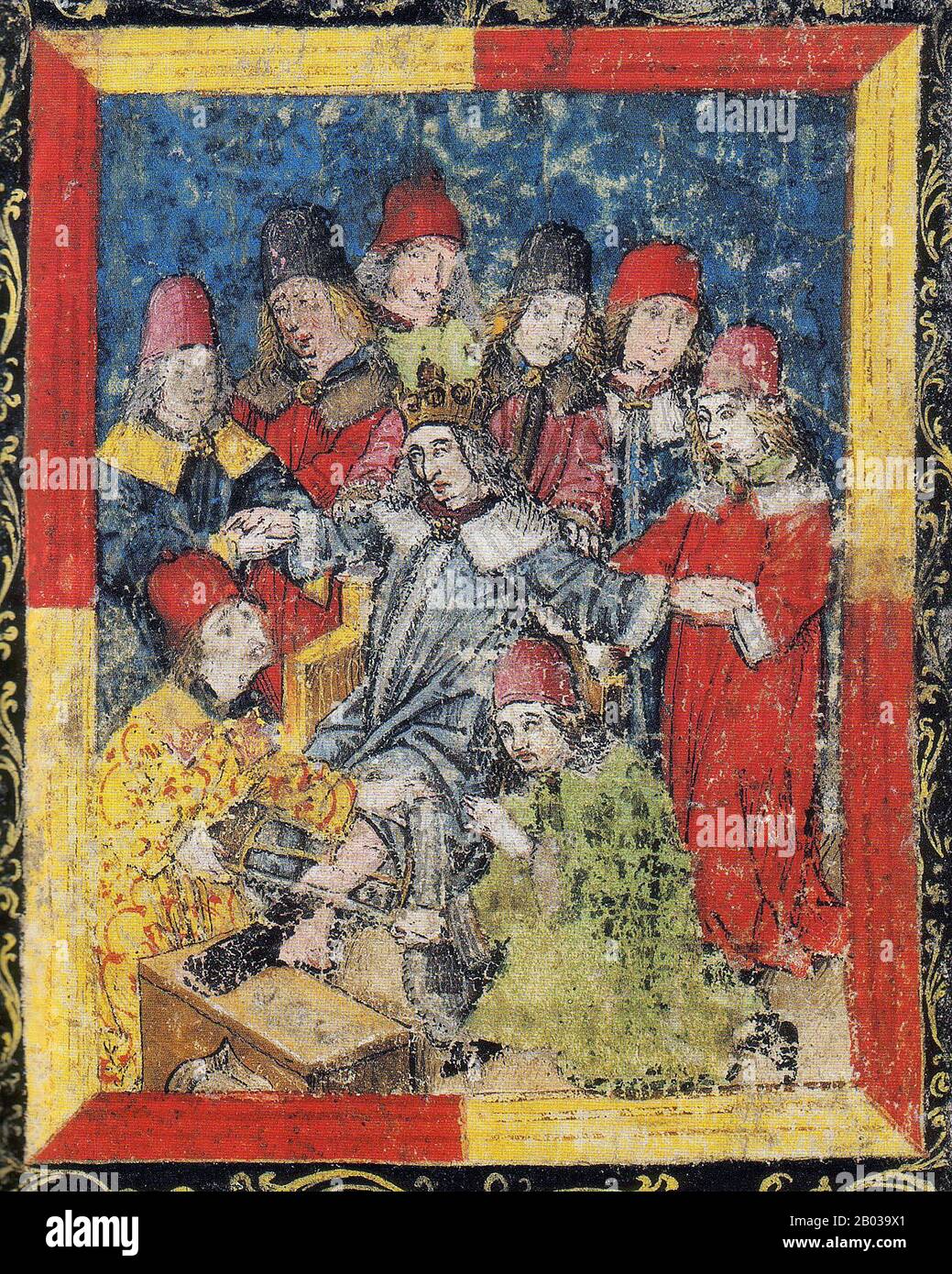 Frederick III (1415-1493), also known as Frederick the Fat and Frederick the Peaceful, was the eldest son of the Inner Austrian duke Ernest the Iron, a member of the Habsburg dynasty. He became duke of Inner Austria in 1424 at the age of nine, but would not be awarded rule until 1435, with his younger brother Albert asserting his rights as co-ruler. By 1439, Frederick had become the undisputed head of the Habsburg dynasty. Frederick died in 1493, aged 77, bleeding to death after having his infected left leg amputated. Stock Photohttps://www.alamy.com/image-license-details/?v=1https://www.alamy.com/frederick-iii-1415-1493-also-known-as-frederick-the-fat-and-frederick-the-peaceful-was-the-eldest-son-of-the-inner-austrian-duke-ernest-the-iron-a-member-of-the-habsburg-dynasty-he-became-duke-of-inner-austria-in-1424-at-the-age-of-nine-but-would-not-be-awarded-rule-until-1435-with-his-younger-brother-albert-asserting-his-rights-as-co-ruler-by-1439-frederick-had-become-the-undisputed-head-of-the-habsburg-dynasty-frederick-died-in-1493-aged-77-bleeding-to-death-after-having-his-infected-left-leg-amputated-image344281001.html
Frederick III (1415-1493), also known as Frederick the Fat and Frederick the Peaceful, was the eldest son of the Inner Austrian duke Ernest the Iron, a member of the Habsburg dynasty. He became duke of Inner Austria in 1424 at the age of nine, but would not be awarded rule until 1435, with his younger brother Albert asserting his rights as co-ruler. By 1439, Frederick had become the undisputed head of the Habsburg dynasty. Frederick died in 1493, aged 77, bleeding to death after having his infected left leg amputated. Stock Photohttps://www.alamy.com/image-license-details/?v=1https://www.alamy.com/frederick-iii-1415-1493-also-known-as-frederick-the-fat-and-frederick-the-peaceful-was-the-eldest-son-of-the-inner-austrian-duke-ernest-the-iron-a-member-of-the-habsburg-dynasty-he-became-duke-of-inner-austria-in-1424-at-the-age-of-nine-but-would-not-be-awarded-rule-until-1435-with-his-younger-brother-albert-asserting-his-rights-as-co-ruler-by-1439-frederick-had-become-the-undisputed-head-of-the-habsburg-dynasty-frederick-died-in-1493-aged-77-bleeding-to-death-after-having-his-infected-left-leg-amputated-image344281001.htmlRM2B039X1–Frederick III (1415-1493), also known as Frederick the Fat and Frederick the Peaceful, was the eldest son of the Inner Austrian duke Ernest the Iron, a member of the Habsburg dynasty. He became duke of Inner Austria in 1424 at the age of nine, but would not be awarded rule until 1435, with his younger brother Albert asserting his rights as co-ruler. By 1439, Frederick had become the undisputed head of the Habsburg dynasty. Frederick died in 1493, aged 77, bleeding to death after having his infected left leg amputated.
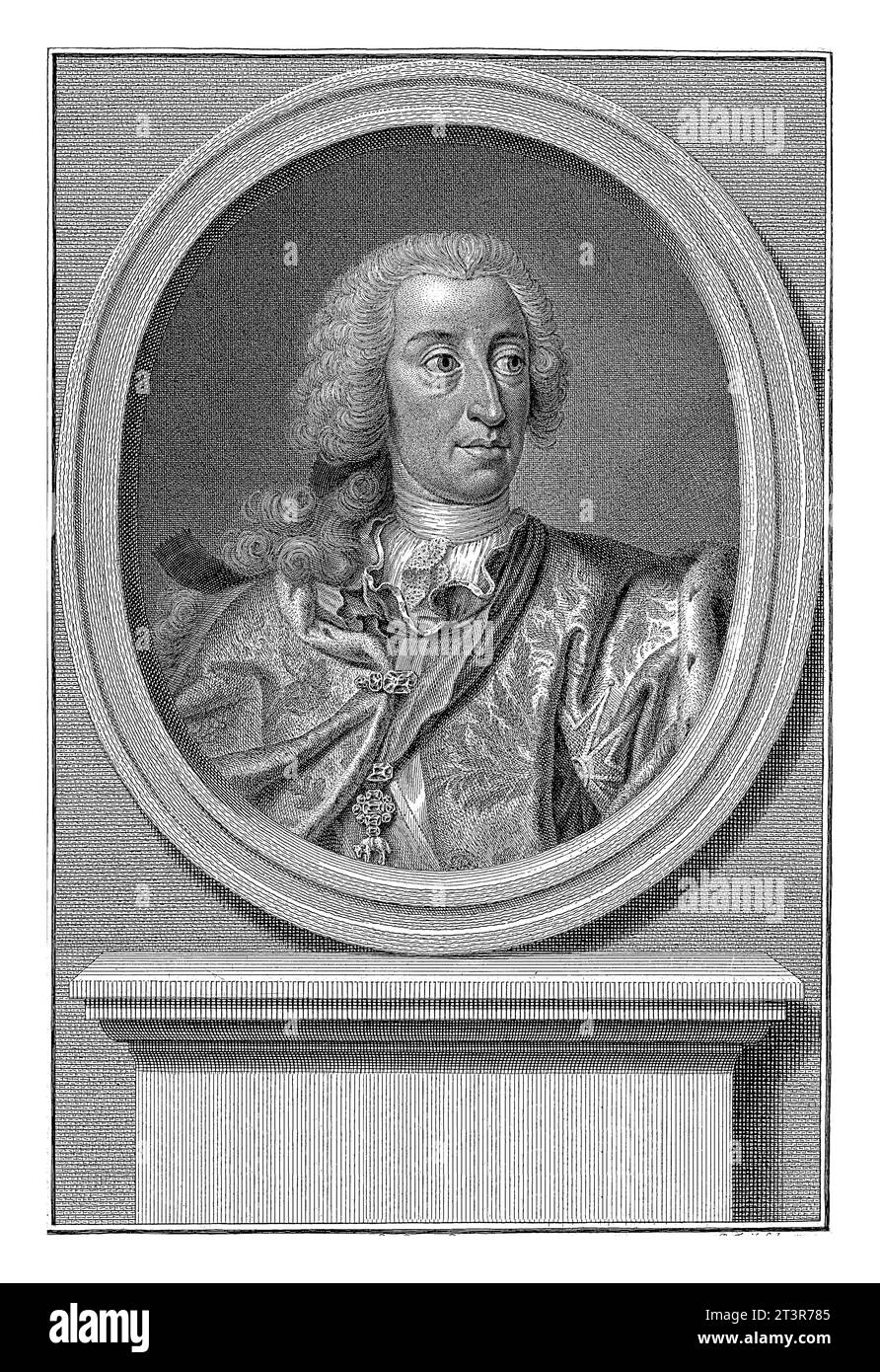 Portrait of German Emperor Charles VII Albert, Pieter Tanje, after Georg Desmarees, 1752 Portrait of Charles VII Albert, German Emperor. Stock Photohttps://www.alamy.com/image-license-details/?v=1https://www.alamy.com/portrait-of-german-emperor-charles-vii-albert-pieter-tanje-after-georg-desmarees-1752-portrait-of-charles-vii-albert-german-emperor-image570296725.html
Portrait of German Emperor Charles VII Albert, Pieter Tanje, after Georg Desmarees, 1752 Portrait of Charles VII Albert, German Emperor. Stock Photohttps://www.alamy.com/image-license-details/?v=1https://www.alamy.com/portrait-of-german-emperor-charles-vii-albert-pieter-tanje-after-georg-desmarees-1752-portrait-of-charles-vii-albert-german-emperor-image570296725.htmlRF2T3R785–Portrait of German Emperor Charles VII Albert, Pieter Tanje, after Georg Desmarees, 1752 Portrait of Charles VII Albert, German Emperor.
 the empire of austria can still be seen everywhere in austria and beyond the empire of austria can still be seen everywhere in austria Stock Photohttps://www.alamy.com/image-license-details/?v=1https://www.alamy.com/the-empire-of-austria-can-still-be-seen-everywhere-in-austria-and-beyond-the-empire-of-austria-can-still-be-seen-everywhere-in-austria-image619468926.html
the empire of austria can still be seen everywhere in austria and beyond the empire of austria can still be seen everywhere in austria Stock Photohttps://www.alamy.com/image-license-details/?v=1https://www.alamy.com/the-empire-of-austria-can-still-be-seen-everywhere-in-austria-and-beyond-the-empire-of-austria-can-still-be-seen-everywhere-in-austria-image619468926.htmlRM2XYR6X6–the empire of austria can still be seen everywhere in austria and beyond the empire of austria can still be seen everywhere in austria
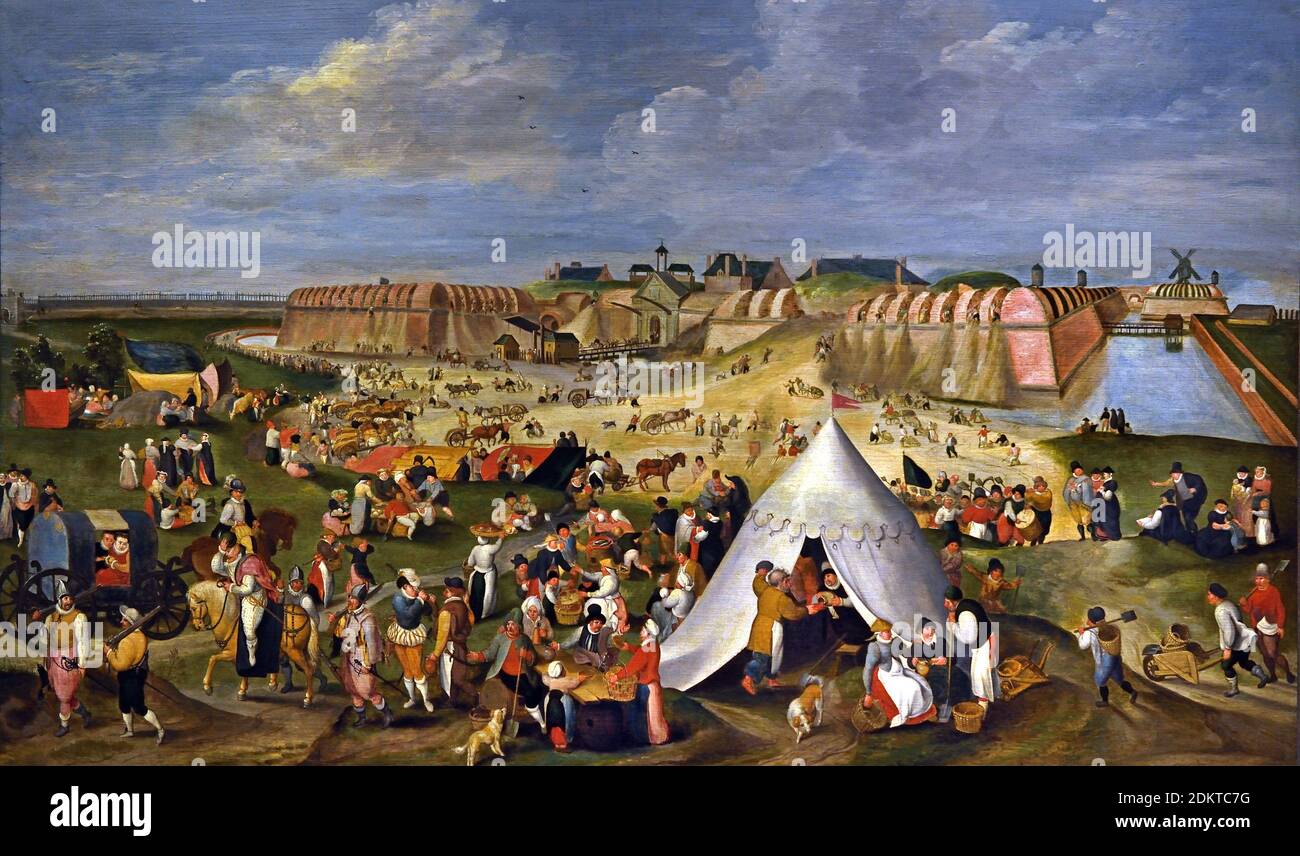 The demolition of the citadel of Antwerp in August 1577, Control the rebellious cities in the Netherlands, Duke of Alva the military manager Flips II building citadels or fortresses. The Antwerpers conquered the citadel of their city from the Spaniards in 1577. Pieter Balten. 1525 - 1598 after Maarten van Cleve 1527 - 1581 Flemish Renaissance painter Belgium Holland . The Dutch Revolt 1566–1648 Low Countries against the rule of the Habsburg King Philip II of Spain Eighty Years, War, Spanish, Dutch, Netherlands, Eighty Years' War, (1568–1648), war of Netherlands independence from Spain, Stock Photohttps://www.alamy.com/image-license-details/?v=1https://www.alamy.com/the-demolition-of-the-citadel-of-antwerp-in-august-1577-control-the-rebellious-cities-in-the-netherlands-duke-of-alva-the-military-manager-flips-ii-building-citadels-or-fortresses-the-antwerpers-conquered-the-citadel-of-their-city-from-the-spaniards-in-1577-pieter-balten-1525-1598-after-maarten-van-cleve-1527-1581-flemish-renaissance-painter-belgium-holland-the-dutch-revolt-15661648-low-countries-against-the-rule-of-the-habsburg-king-philip-ii-of-spain-eighty-years-war-spanish-dutch-netherlands-eighty-years-war-15681648-war-of-netherlands-independence-from-spain-image390843028.html
The demolition of the citadel of Antwerp in August 1577, Control the rebellious cities in the Netherlands, Duke of Alva the military manager Flips II building citadels or fortresses. The Antwerpers conquered the citadel of their city from the Spaniards in 1577. Pieter Balten. 1525 - 1598 after Maarten van Cleve 1527 - 1581 Flemish Renaissance painter Belgium Holland . The Dutch Revolt 1566–1648 Low Countries against the rule of the Habsburg King Philip II of Spain Eighty Years, War, Spanish, Dutch, Netherlands, Eighty Years' War, (1568–1648), war of Netherlands independence from Spain, Stock Photohttps://www.alamy.com/image-license-details/?v=1https://www.alamy.com/the-demolition-of-the-citadel-of-antwerp-in-august-1577-control-the-rebellious-cities-in-the-netherlands-duke-of-alva-the-military-manager-flips-ii-building-citadels-or-fortresses-the-antwerpers-conquered-the-citadel-of-their-city-from-the-spaniards-in-1577-pieter-balten-1525-1598-after-maarten-van-cleve-1527-1581-flemish-renaissance-painter-belgium-holland-the-dutch-revolt-15661648-low-countries-against-the-rule-of-the-habsburg-king-philip-ii-of-spain-eighty-years-war-spanish-dutch-netherlands-eighty-years-war-15681648-war-of-netherlands-independence-from-spain-image390843028.htmlRM2DKTC7G–The demolition of the citadel of Antwerp in August 1577, Control the rebellious cities in the Netherlands, Duke of Alva the military manager Flips II building citadels or fortresses. The Antwerpers conquered the citadel of their city from the Spaniards in 1577. Pieter Balten. 1525 - 1598 after Maarten van Cleve 1527 - 1581 Flemish Renaissance painter Belgium Holland . The Dutch Revolt 1566–1648 Low Countries against the rule of the Habsburg King Philip II of Spain Eighty Years, War, Spanish, Dutch, Netherlands, Eighty Years' War, (1568–1648), war of Netherlands independence from Spain,
 the empire of austria can still be seen everywhere in austria and beyond the empire of austria can still be seen everywhere in austria Stock Photohttps://www.alamy.com/image-license-details/?v=1https://www.alamy.com/the-empire-of-austria-can-still-be-seen-everywhere-in-austria-and-beyond-the-empire-of-austria-can-still-be-seen-everywhere-in-austria-image619669002.html
the empire of austria can still be seen everywhere in austria and beyond the empire of austria can still be seen everywhere in austria Stock Photohttps://www.alamy.com/image-license-details/?v=1https://www.alamy.com/the-empire-of-austria-can-still-be-seen-everywhere-in-austria-and-beyond-the-empire-of-austria-can-still-be-seen-everywhere-in-austria-image619669002.htmlRM2Y04A3P–the empire of austria can still be seen everywhere in austria and beyond the empire of austria can still be seen everywhere in austria
 the empire of austria can still be seen everywhere in austria and beyond the empire of austria can still be seen everywhere in austria Stock Photohttps://www.alamy.com/image-license-details/?v=1https://www.alamy.com/the-empire-of-austria-can-still-be-seen-everywhere-in-austria-and-beyond-the-empire-of-austria-can-still-be-seen-everywhere-in-austria-image619469111.html
the empire of austria can still be seen everywhere in austria and beyond the empire of austria can still be seen everywhere in austria Stock Photohttps://www.alamy.com/image-license-details/?v=1https://www.alamy.com/the-empire-of-austria-can-still-be-seen-everywhere-in-austria-and-beyond-the-empire-of-austria-can-still-be-seen-everywhere-in-austria-image619469111.htmlRM2XYR74R–the empire of austria can still be seen everywhere in austria and beyond the empire of austria can still be seen everywhere in austria
 the empire of austria can still be seen everywhere in austria and beyond the empire of austria can still be seen everywhere in austria Stock Photohttps://www.alamy.com/image-license-details/?v=1https://www.alamy.com/the-empire-of-austria-can-still-be-seen-everywhere-in-austria-and-beyond-the-empire-of-austria-can-still-be-seen-everywhere-in-austria-image619469116.html
the empire of austria can still be seen everywhere in austria and beyond the empire of austria can still be seen everywhere in austria Stock Photohttps://www.alamy.com/image-license-details/?v=1https://www.alamy.com/the-empire-of-austria-can-still-be-seen-everywhere-in-austria-and-beyond-the-empire-of-austria-can-still-be-seen-everywhere-in-austria-image619469116.htmlRM2XYR750–the empire of austria can still be seen everywhere in austria and beyond the empire of austria can still be seen everywhere in austria
 the empire of austria can still be seen everywhere in austria and beyond the empire of austria can still be seen everywhere in austria Stock Photohttps://www.alamy.com/image-license-details/?v=1https://www.alamy.com/the-empire-of-austria-can-still-be-seen-everywhere-in-austria-and-beyond-the-empire-of-austria-can-still-be-seen-everywhere-in-austria-image619469095.html
the empire of austria can still be seen everywhere in austria and beyond the empire of austria can still be seen everywhere in austria Stock Photohttps://www.alamy.com/image-license-details/?v=1https://www.alamy.com/the-empire-of-austria-can-still-be-seen-everywhere-in-austria-and-beyond-the-empire-of-austria-can-still-be-seen-everywhere-in-austria-image619469095.htmlRM2XYR747–the empire of austria can still be seen everywhere in austria and beyond the empire of austria can still be seen everywhere in austria
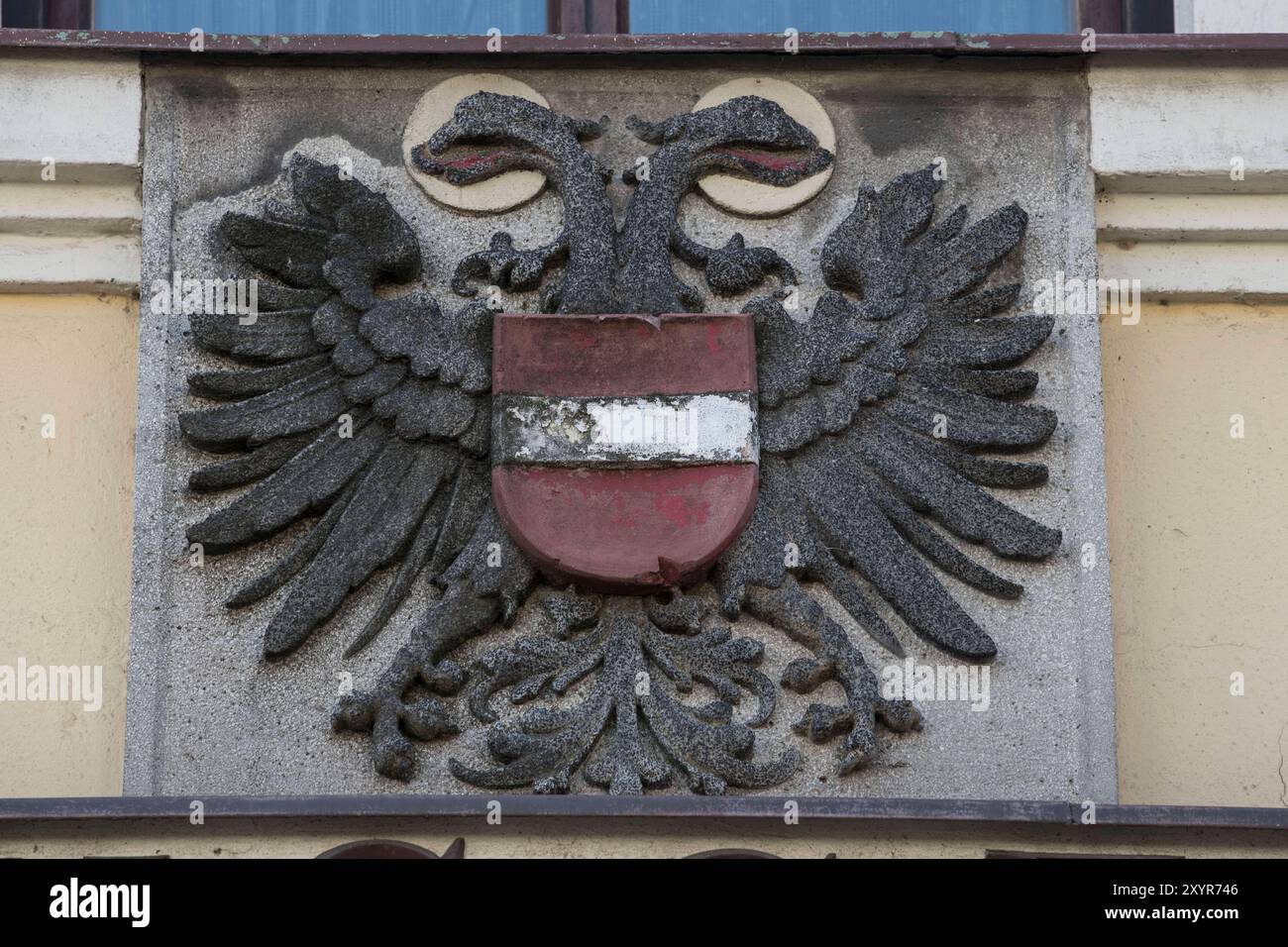 the empire of austria can still be seen everywhere in austria and beyond the empire of austria can still be seen everywhere in austria Stock Photohttps://www.alamy.com/image-license-details/?v=1https://www.alamy.com/the-empire-of-austria-can-still-be-seen-everywhere-in-austria-and-beyond-the-empire-of-austria-can-still-be-seen-everywhere-in-austria-image619469094.html
the empire of austria can still be seen everywhere in austria and beyond the empire of austria can still be seen everywhere in austria Stock Photohttps://www.alamy.com/image-license-details/?v=1https://www.alamy.com/the-empire-of-austria-can-still-be-seen-everywhere-in-austria-and-beyond-the-empire-of-austria-can-still-be-seen-everywhere-in-austria-image619469094.htmlRM2XYR746–the empire of austria can still be seen everywhere in austria and beyond the empire of austria can still be seen everywhere in austria
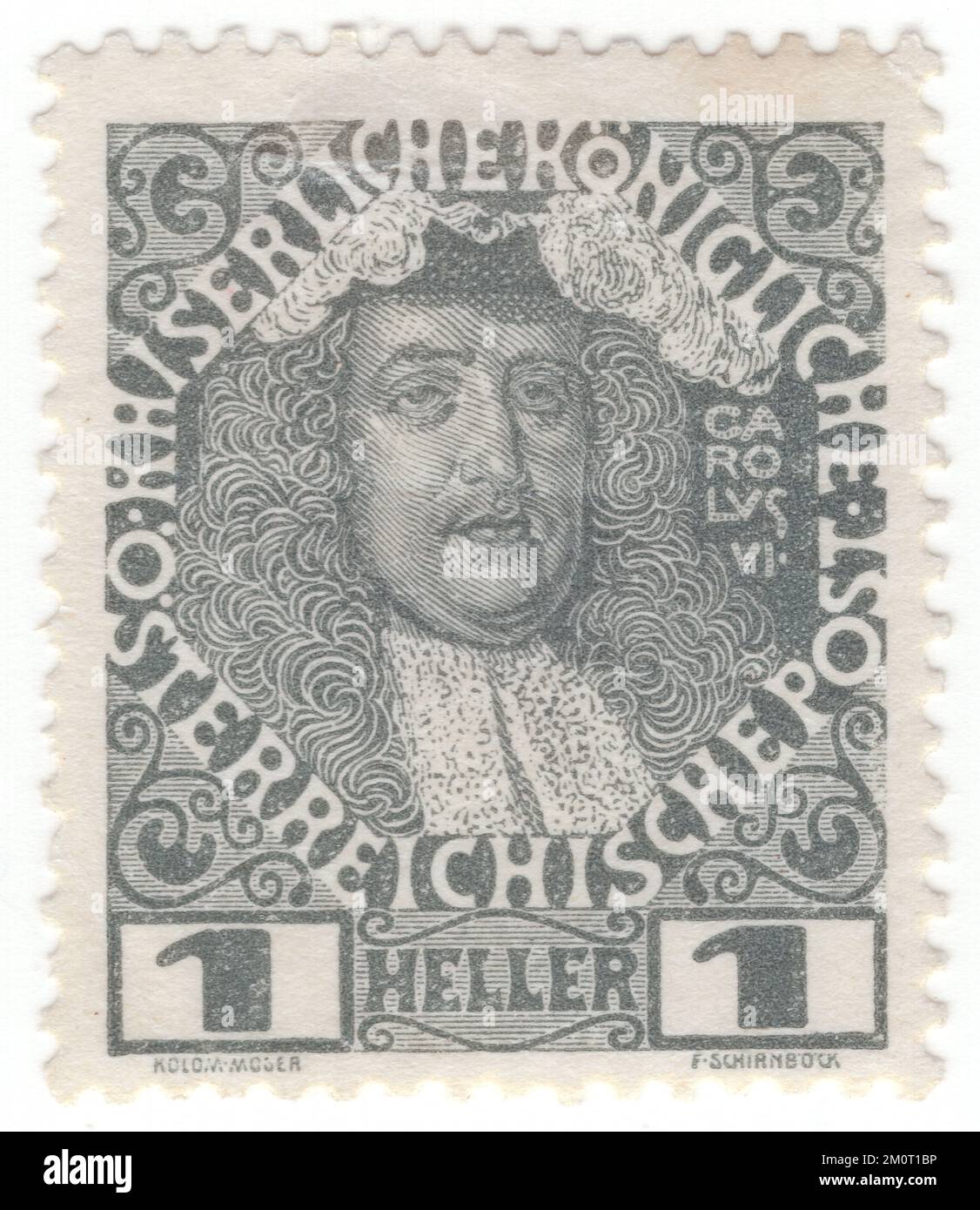 AUSTRIA — 1908: An 1 heller grey-black postage stamp depicting portrait of Karl VI. Definitive set issued for the 60th year of the reign of Austrian Monarch Franz Josef, Emperor of Austria, King of Hungary, and the other states of the Habsburg monarchy. Charles VI was Holy Roman Emperor and ruler of the Austrian Habsburg monarchy from 1711 until his death, succeeding his elder brother, Joseph I. He unsuccessfully claimed the throne of Spain following the death of his relative, Charles II. In 1708, he married Elisabeth Christine of Brunswick-Wolfenbüttel, by whom he had his four children Stock Photohttps://www.alamy.com/image-license-details/?v=1https://www.alamy.com/austria-1908-an-1-heller-grey-black-postage-stamp-depicting-portrait-of-karl-vi-definitive-set-issued-for-the-60th-year-of-the-reign-of-austrian-monarch-franz-josef-emperor-of-austria-king-of-hungary-and-the-other-states-of-the-habsburg-monarchy-charles-vi-was-holy-roman-emperor-and-ruler-of-the-austrian-habsburg-monarchy-from-1711-until-his-death-succeeding-his-elder-brother-joseph-i-he-unsuccessfully-claimed-the-throne-of-spain-following-the-death-of-his-relative-charles-ii-in-1708-he-married-elisabeth-christine-of-brunswick-wolfenbttel-by-whom-he-had-his-four-children-image499628634.html
AUSTRIA — 1908: An 1 heller grey-black postage stamp depicting portrait of Karl VI. Definitive set issued for the 60th year of the reign of Austrian Monarch Franz Josef, Emperor of Austria, King of Hungary, and the other states of the Habsburg monarchy. Charles VI was Holy Roman Emperor and ruler of the Austrian Habsburg monarchy from 1711 until his death, succeeding his elder brother, Joseph I. He unsuccessfully claimed the throne of Spain following the death of his relative, Charles II. In 1708, he married Elisabeth Christine of Brunswick-Wolfenbüttel, by whom he had his four children Stock Photohttps://www.alamy.com/image-license-details/?v=1https://www.alamy.com/austria-1908-an-1-heller-grey-black-postage-stamp-depicting-portrait-of-karl-vi-definitive-set-issued-for-the-60th-year-of-the-reign-of-austrian-monarch-franz-josef-emperor-of-austria-king-of-hungary-and-the-other-states-of-the-habsburg-monarchy-charles-vi-was-holy-roman-emperor-and-ruler-of-the-austrian-habsburg-monarchy-from-1711-until-his-death-succeeding-his-elder-brother-joseph-i-he-unsuccessfully-claimed-the-throne-of-spain-following-the-death-of-his-relative-charles-ii-in-1708-he-married-elisabeth-christine-of-brunswick-wolfenbttel-by-whom-he-had-his-four-children-image499628634.htmlRF2M0T1BP–AUSTRIA — 1908: An 1 heller grey-black postage stamp depicting portrait of Karl VI. Definitive set issued for the 60th year of the reign of Austrian Monarch Franz Josef, Emperor of Austria, King of Hungary, and the other states of the Habsburg monarchy. Charles VI was Holy Roman Emperor and ruler of the Austrian Habsburg monarchy from 1711 until his death, succeeding his elder brother, Joseph I. He unsuccessfully claimed the throne of Spain following the death of his relative, Charles II. In 1708, he married Elisabeth Christine of Brunswick-Wolfenbüttel, by whom he had his four children
 the empire of austria can still be seen everywhere in austria and beyond the empire of austria can still be seen everywhere in austria Stock Photohttps://www.alamy.com/image-license-details/?v=1https://www.alamy.com/the-empire-of-austria-can-still-be-seen-everywhere-in-austria-and-beyond-the-empire-of-austria-can-still-be-seen-everywhere-in-austria-image619469216.html
the empire of austria can still be seen everywhere in austria and beyond the empire of austria can still be seen everywhere in austria Stock Photohttps://www.alamy.com/image-license-details/?v=1https://www.alamy.com/the-empire-of-austria-can-still-be-seen-everywhere-in-austria-and-beyond-the-empire-of-austria-can-still-be-seen-everywhere-in-austria-image619469216.htmlRM2XYR78G–the empire of austria can still be seen everywhere in austria and beyond the empire of austria can still be seen everywhere in austria
 Frederick III (1415-1493), also known as Frederick the Fat and Frederick the Peaceful, was the eldest son of the Inner Austrian duke Ernest the Iron, a member of the Habsburg dynasty. He became duke of Inner Austria in 1424 at the age of nine, but would not be awarded rule until 1435, with his younger brother Albert asserting his rights as co-ruler. By 1439, Frederick had become the undisputed head of the Habsburg dynasty. Frederick died in 1493, aged 77, bleeding to death after having his infected left leg amputated. Stock Photohttps://www.alamy.com/image-license-details/?v=1https://www.alamy.com/frederick-iii-1415-1493-also-known-as-frederick-the-fat-and-frederick-the-peaceful-was-the-eldest-son-of-the-inner-austrian-duke-ernest-the-iron-a-member-of-the-habsburg-dynasty-he-became-duke-of-inner-austria-in-1424-at-the-age-of-nine-but-would-not-be-awarded-rule-until-1435-with-his-younger-brother-albert-asserting-his-rights-as-co-ruler-by-1439-frederick-had-become-the-undisputed-head-of-the-habsburg-dynasty-frederick-died-in-1493-aged-77-bleeding-to-death-after-having-his-infected-left-leg-amputated-image344281015.html
Frederick III (1415-1493), also known as Frederick the Fat and Frederick the Peaceful, was the eldest son of the Inner Austrian duke Ernest the Iron, a member of the Habsburg dynasty. He became duke of Inner Austria in 1424 at the age of nine, but would not be awarded rule until 1435, with his younger brother Albert asserting his rights as co-ruler. By 1439, Frederick had become the undisputed head of the Habsburg dynasty. Frederick died in 1493, aged 77, bleeding to death after having his infected left leg amputated. Stock Photohttps://www.alamy.com/image-license-details/?v=1https://www.alamy.com/frederick-iii-1415-1493-also-known-as-frederick-the-fat-and-frederick-the-peaceful-was-the-eldest-son-of-the-inner-austrian-duke-ernest-the-iron-a-member-of-the-habsburg-dynasty-he-became-duke-of-inner-austria-in-1424-at-the-age-of-nine-but-would-not-be-awarded-rule-until-1435-with-his-younger-brother-albert-asserting-his-rights-as-co-ruler-by-1439-frederick-had-become-the-undisputed-head-of-the-habsburg-dynasty-frederick-died-in-1493-aged-77-bleeding-to-death-after-having-his-infected-left-leg-amputated-image344281015.htmlRM2B039XF–Frederick III (1415-1493), also known as Frederick the Fat and Frederick the Peaceful, was the eldest son of the Inner Austrian duke Ernest the Iron, a member of the Habsburg dynasty. He became duke of Inner Austria in 1424 at the age of nine, but would not be awarded rule until 1435, with his younger brother Albert asserting his rights as co-ruler. By 1439, Frederick had become the undisputed head of the Habsburg dynasty. Frederick died in 1493, aged 77, bleeding to death after having his infected left leg amputated.
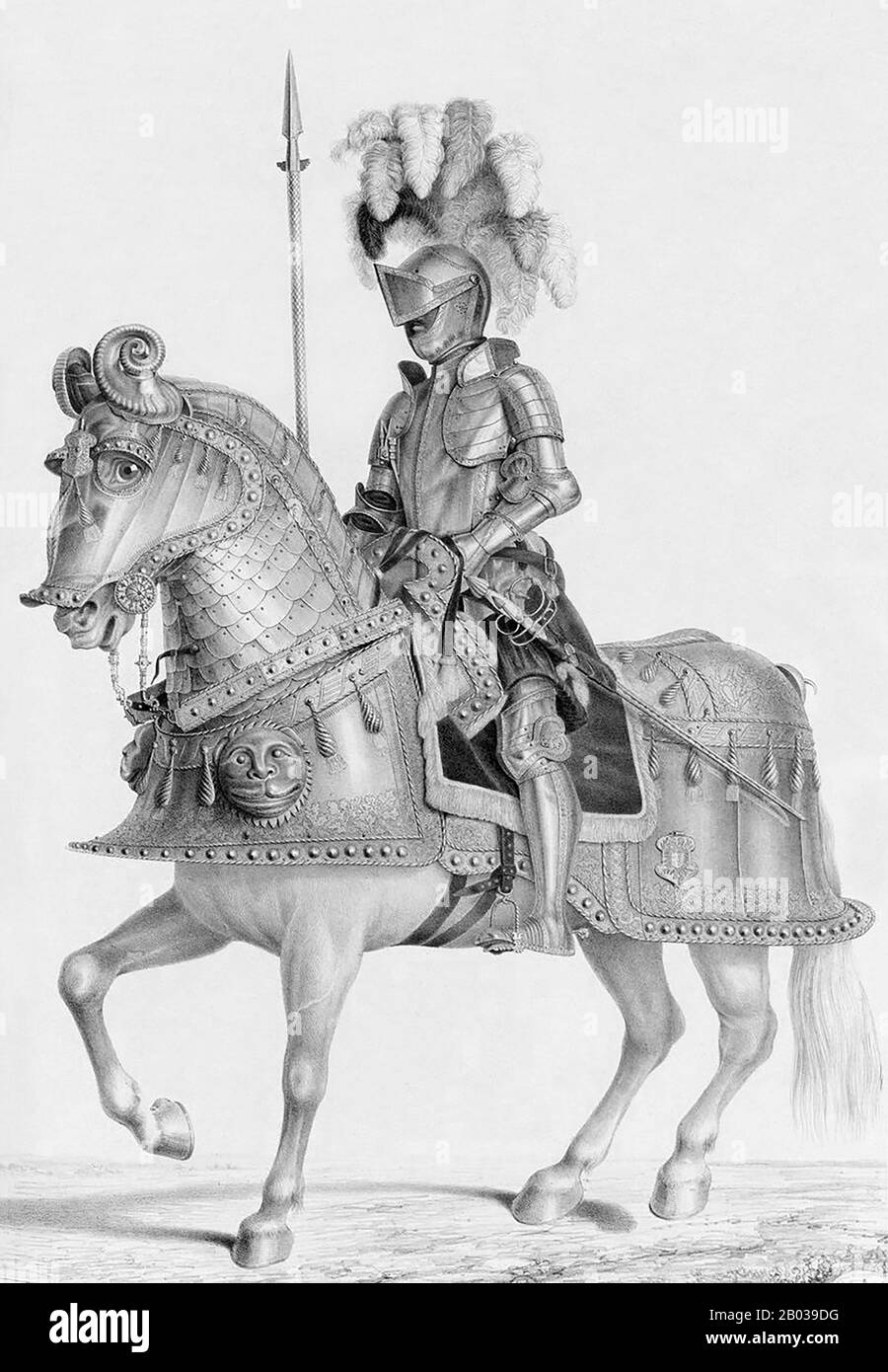 Charles V (24 February 1500 – 21 September 1558) was ruler of both the Holy Roman Empire from 1519 and the Spanish Empire (as Charles I of Spain) from 1516, as well as of the lands of the former Duchy of Burgundy from 1506. He stepped down from these and other positions by a series of abdications between 1554 and 1556. Through inheritance, Charles brought together under his rule extensive territories in western, central, and southern Europe, and the Spanish viceroyalties in the Americas and Asia. As a result, his domains spanned nearly 4 million square kilometres (1.5 million square miles), a Stock Photohttps://www.alamy.com/image-license-details/?v=1https://www.alamy.com/charles-v-24-february-1500-21-september-1558-was-ruler-of-both-the-holy-roman-empire-from-1519-and-the-spanish-empire-as-charles-i-of-spain-from-1516-as-well-as-of-the-lands-of-the-former-duchy-of-burgundy-from-1506-he-stepped-down-from-these-and-other-positions-by-a-series-of-abdications-between-1554-and-1556-through-inheritance-charles-brought-together-under-his-rule-extensive-territories-in-western-central-and-southern-europe-and-the-spanish-viceroyalties-in-the-americas-and-asia-as-a-result-his-domains-spanned-nearly-4-million-square-kilometres-15-million-square-miles-a-image344280652.html
Charles V (24 February 1500 – 21 September 1558) was ruler of both the Holy Roman Empire from 1519 and the Spanish Empire (as Charles I of Spain) from 1516, as well as of the lands of the former Duchy of Burgundy from 1506. He stepped down from these and other positions by a series of abdications between 1554 and 1556. Through inheritance, Charles brought together under his rule extensive territories in western, central, and southern Europe, and the Spanish viceroyalties in the Americas and Asia. As a result, his domains spanned nearly 4 million square kilometres (1.5 million square miles), a Stock Photohttps://www.alamy.com/image-license-details/?v=1https://www.alamy.com/charles-v-24-february-1500-21-september-1558-was-ruler-of-both-the-holy-roman-empire-from-1519-and-the-spanish-empire-as-charles-i-of-spain-from-1516-as-well-as-of-the-lands-of-the-former-duchy-of-burgundy-from-1506-he-stepped-down-from-these-and-other-positions-by-a-series-of-abdications-between-1554-and-1556-through-inheritance-charles-brought-together-under-his-rule-extensive-territories-in-western-central-and-southern-europe-and-the-spanish-viceroyalties-in-the-americas-and-asia-as-a-result-his-domains-spanned-nearly-4-million-square-kilometres-15-million-square-miles-a-image344280652.htmlRM2B039DG–Charles V (24 February 1500 – 21 September 1558) was ruler of both the Holy Roman Empire from 1519 and the Spanish Empire (as Charles I of Spain) from 1516, as well as of the lands of the former Duchy of Burgundy from 1506. He stepped down from these and other positions by a series of abdications between 1554 and 1556. Through inheritance, Charles brought together under his rule extensive territories in western, central, and southern Europe, and the Spanish viceroyalties in the Americas and Asia. As a result, his domains spanned nearly 4 million square kilometres (1.5 million square miles), a
 Portrait of Charles VII Albrecht, Roman German Emperor, Georg Paul Busch, 1742 - 1756, vintage engraved. Stock Photohttps://www.alamy.com/image-license-details/?v=1https://www.alamy.com/portrait-of-charles-vii-albrecht-roman-german-emperor-georg-paul-busch-1742-1756-vintage-engraved-image570296142.html
Portrait of Charles VII Albrecht, Roman German Emperor, Georg Paul Busch, 1742 - 1756, vintage engraved. Stock Photohttps://www.alamy.com/image-license-details/?v=1https://www.alamy.com/portrait-of-charles-vii-albrecht-roman-german-emperor-georg-paul-busch-1742-1756-vintage-engraved-image570296142.htmlRF2T3R6FA–Portrait of Charles VII Albrecht, Roman German Emperor, Georg Paul Busch, 1742 - 1756, vintage engraved.
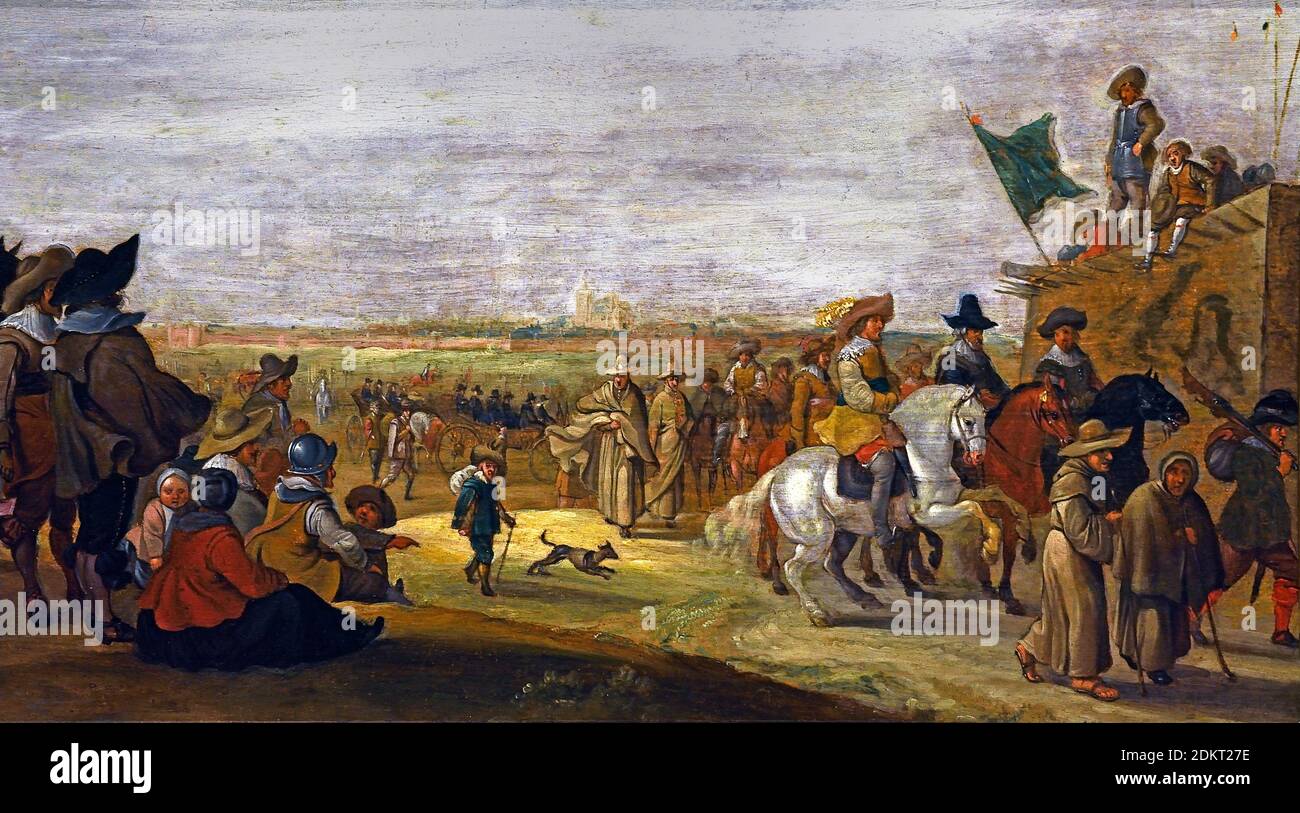 Departure Governor Schertz Grobbendonk Holland, The Netherlands, Dutch, With a salute Frederick Hendrik bids farewell to the captain of the Spanish garrison, Governor Schertz Grobbendonk, The Netherlands, The Dutch Revolt 1566–1648 Low Countries against the rule of the Habsburg King Philip II of Spain The Eighty Years War ( Frederick Henry sovereign prince of Orange ) Eighty Years, War, Spanish, Dutch, Netherlands, Eighty Years' War, (1568–1648), war of Netherlands independence from Spain, Stock Photohttps://www.alamy.com/image-license-details/?v=1https://www.alamy.com/departure-governor-schertz-grobbendonk-holland-the-netherlands-dutch-with-a-salute-frederick-hendrik-bids-farewell-to-the-captain-of-the-spanish-garrison-governor-schertz-grobbendonk-the-netherlands-the-dutch-revolt-15661648-low-countries-against-the-rule-of-the-habsburg-king-philip-ii-of-spain-the-eighty-years-war-frederick-henry-sovereign-prince-of-orange-eighty-years-war-spanish-dutch-netherlands-eighty-years-war-15681648-war-of-netherlands-independence-from-spain-image390835186.html
Departure Governor Schertz Grobbendonk Holland, The Netherlands, Dutch, With a salute Frederick Hendrik bids farewell to the captain of the Spanish garrison, Governor Schertz Grobbendonk, The Netherlands, The Dutch Revolt 1566–1648 Low Countries against the rule of the Habsburg King Philip II of Spain The Eighty Years War ( Frederick Henry sovereign prince of Orange ) Eighty Years, War, Spanish, Dutch, Netherlands, Eighty Years' War, (1568–1648), war of Netherlands independence from Spain, Stock Photohttps://www.alamy.com/image-license-details/?v=1https://www.alamy.com/departure-governor-schertz-grobbendonk-holland-the-netherlands-dutch-with-a-salute-frederick-hendrik-bids-farewell-to-the-captain-of-the-spanish-garrison-governor-schertz-grobbendonk-the-netherlands-the-dutch-revolt-15661648-low-countries-against-the-rule-of-the-habsburg-king-philip-ii-of-spain-the-eighty-years-war-frederick-henry-sovereign-prince-of-orange-eighty-years-war-spanish-dutch-netherlands-eighty-years-war-15681648-war-of-netherlands-independence-from-spain-image390835186.htmlRM2DKT27E–Departure Governor Schertz Grobbendonk Holland, The Netherlands, Dutch, With a salute Frederick Hendrik bids farewell to the captain of the Spanish garrison, Governor Schertz Grobbendonk, The Netherlands, The Dutch Revolt 1566–1648 Low Countries against the rule of the Habsburg King Philip II of Spain The Eighty Years War ( Frederick Henry sovereign prince of Orange ) Eighty Years, War, Spanish, Dutch, Netherlands, Eighty Years' War, (1568–1648), war of Netherlands independence from Spain,
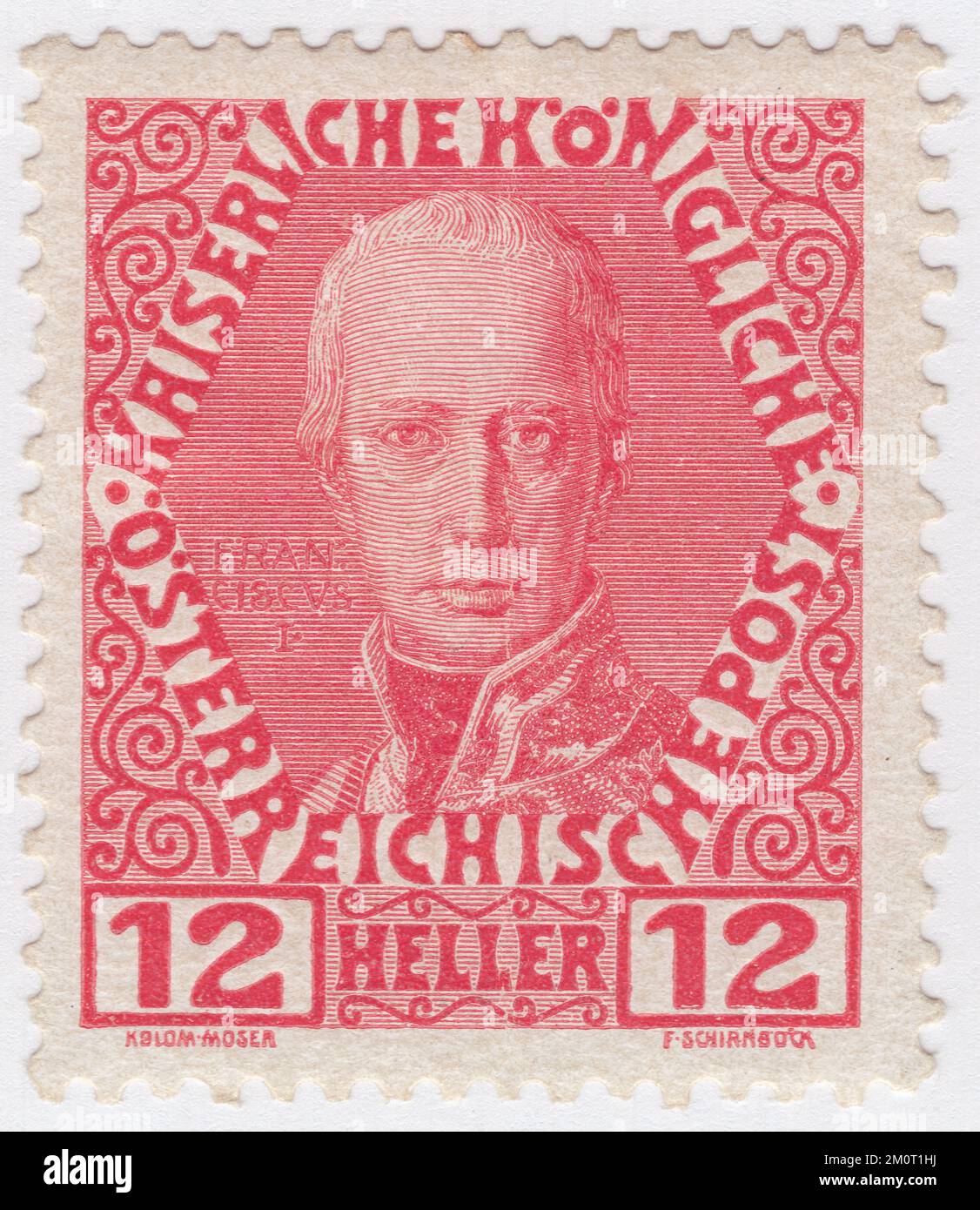 AUSTRIA — 1908: An 12 heller scarlet postage stamp depicting portrait of Franz I. Definitive set issued for the 60th year of the reign of Austrian Monarch Franz Josef, Emperor of Austria, King of Hungary, and the other states of the Habsburg monarchy. Francis I (Francis Stephen) was Holy Roman Emperor (1745–1765), Archduke of Austria (1740–1765), Duke of Lorraine and Bar (1729–1737), and Grand Duke of Tuscany (1737–1765). He became the ruler of the Holy Roman Empire, Austria, and Tuscany through his marriage to Maria Theresa, daughter of Emperor Charles VI Stock Photohttps://www.alamy.com/image-license-details/?v=1https://www.alamy.com/austria-1908-an-12-heller-scarlet-postage-stamp-depicting-portrait-of-franz-i-definitive-set-issued-for-the-60th-year-of-the-reign-of-austrian-monarch-franz-josef-emperor-of-austria-king-of-hungary-and-the-other-states-of-the-habsburg-monarchy-francis-i-francis-stephen-was-holy-roman-emperor-17451765-archduke-of-austria-17401765-duke-of-lorraine-and-bar-17291737-and-grand-duke-of-tuscany-17371765-he-became-the-ruler-of-the-holy-roman-empire-austria-and-tuscany-through-his-marriage-to-maria-theresa-daughter-of-emperor-charles-vi-image499628798.html
AUSTRIA — 1908: An 12 heller scarlet postage stamp depicting portrait of Franz I. Definitive set issued for the 60th year of the reign of Austrian Monarch Franz Josef, Emperor of Austria, King of Hungary, and the other states of the Habsburg monarchy. Francis I (Francis Stephen) was Holy Roman Emperor (1745–1765), Archduke of Austria (1740–1765), Duke of Lorraine and Bar (1729–1737), and Grand Duke of Tuscany (1737–1765). He became the ruler of the Holy Roman Empire, Austria, and Tuscany through his marriage to Maria Theresa, daughter of Emperor Charles VI Stock Photohttps://www.alamy.com/image-license-details/?v=1https://www.alamy.com/austria-1908-an-12-heller-scarlet-postage-stamp-depicting-portrait-of-franz-i-definitive-set-issued-for-the-60th-year-of-the-reign-of-austrian-monarch-franz-josef-emperor-of-austria-king-of-hungary-and-the-other-states-of-the-habsburg-monarchy-francis-i-francis-stephen-was-holy-roman-emperor-17451765-archduke-of-austria-17401765-duke-of-lorraine-and-bar-17291737-and-grand-duke-of-tuscany-17371765-he-became-the-ruler-of-the-holy-roman-empire-austria-and-tuscany-through-his-marriage-to-maria-theresa-daughter-of-emperor-charles-vi-image499628798.htmlRF2M0T1HJ–AUSTRIA — 1908: An 12 heller scarlet postage stamp depicting portrait of Franz I. Definitive set issued for the 60th year of the reign of Austrian Monarch Franz Josef, Emperor of Austria, King of Hungary, and the other states of the Habsburg monarchy. Francis I (Francis Stephen) was Holy Roman Emperor (1745–1765), Archduke of Austria (1740–1765), Duke of Lorraine and Bar (1729–1737), and Grand Duke of Tuscany (1737–1765). He became the ruler of the Holy Roman Empire, Austria, and Tuscany through his marriage to Maria Theresa, daughter of Emperor Charles VI
 the empire of austria can still be seen everywhere in austria and beyond the empire of austria can still be seen everywhere in austria Stock Photohttps://www.alamy.com/image-license-details/?v=1https://www.alamy.com/the-empire-of-austria-can-still-be-seen-everywhere-in-austria-and-beyond-the-empire-of-austria-can-still-be-seen-everywhere-in-austria-image619963726.html
the empire of austria can still be seen everywhere in austria and beyond the empire of austria can still be seen everywhere in austria Stock Photohttps://www.alamy.com/image-license-details/?v=1https://www.alamy.com/the-empire-of-austria-can-still-be-seen-everywhere-in-austria-and-beyond-the-empire-of-austria-can-still-be-seen-everywhere-in-austria-image619963726.htmlRM2Y0HP1J–the empire of austria can still be seen everywhere in austria and beyond the empire of austria can still be seen everywhere in austria
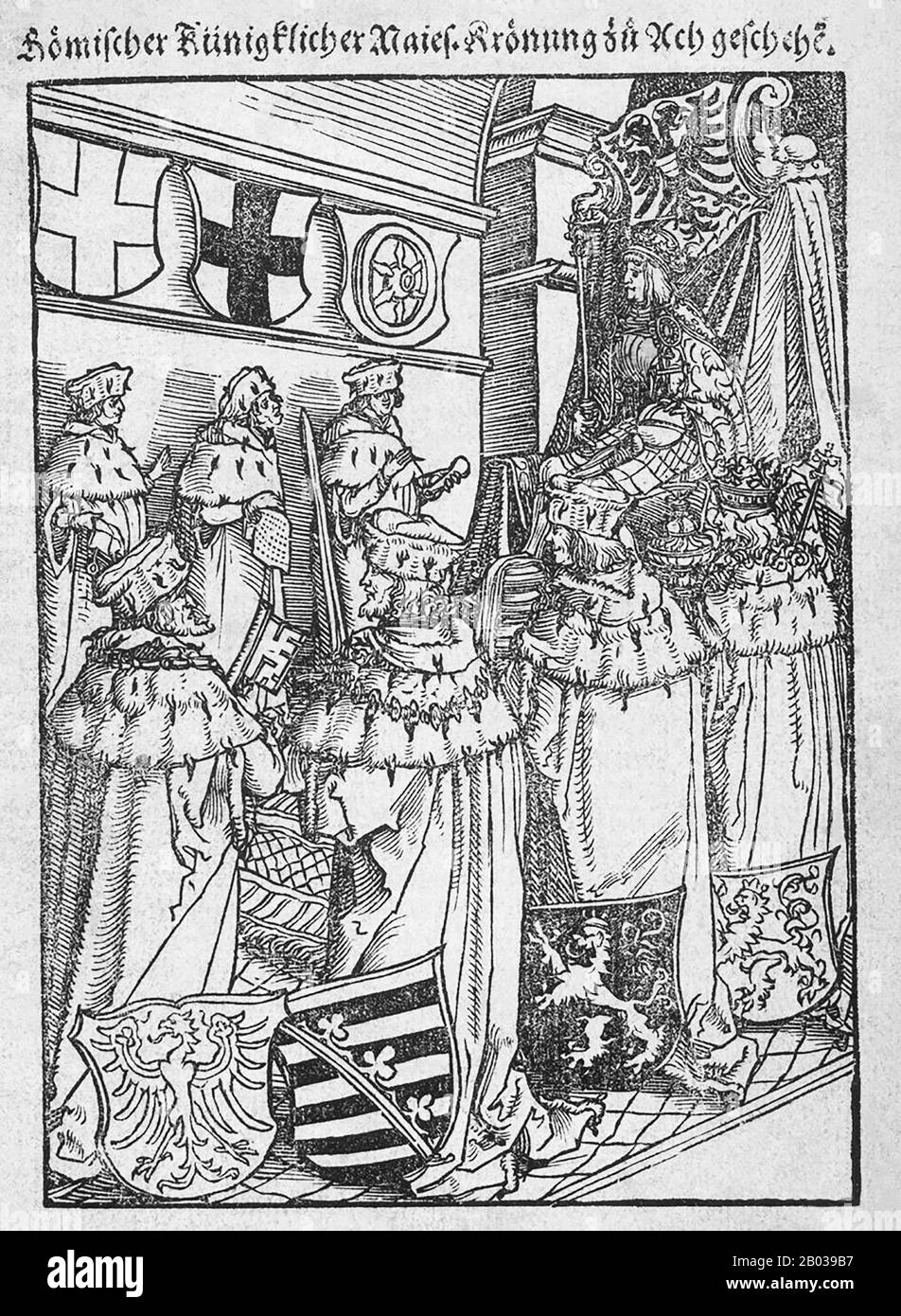 Charles V (24 February 1500 – 21 September 1558) was ruler of both the Holy Roman Empire from 1519 and the Spanish Empire (as Charles I of Spain) from 1516, as well as of the lands of the former Duchy of Burgundy from 1506. He stepped down from these and other positions by a series of abdications between 1554 and 1556. Through inheritance, Charles brought together under his rule extensive territories in western, central, and southern Europe, and the Spanish viceroyalties in the Americas and Asia. As a result, his domains spanned nearly 4 million square kilometres (1.5 million square miles), a Stock Photohttps://www.alamy.com/image-license-details/?v=1https://www.alamy.com/charles-v-24-february-1500-21-september-1558-was-ruler-of-both-the-holy-roman-empire-from-1519-and-the-spanish-empire-as-charles-i-of-spain-from-1516-as-well-as-of-the-lands-of-the-former-duchy-of-burgundy-from-1506-he-stepped-down-from-these-and-other-positions-by-a-series-of-abdications-between-1554-and-1556-through-inheritance-charles-brought-together-under-his-rule-extensive-territories-in-western-central-and-southern-europe-and-the-spanish-viceroyalties-in-the-americas-and-asia-as-a-result-his-domains-spanned-nearly-4-million-square-kilometres-15-million-square-miles-a-image344280587.html
Charles V (24 February 1500 – 21 September 1558) was ruler of both the Holy Roman Empire from 1519 and the Spanish Empire (as Charles I of Spain) from 1516, as well as of the lands of the former Duchy of Burgundy from 1506. He stepped down from these and other positions by a series of abdications between 1554 and 1556. Through inheritance, Charles brought together under his rule extensive territories in western, central, and southern Europe, and the Spanish viceroyalties in the Americas and Asia. As a result, his domains spanned nearly 4 million square kilometres (1.5 million square miles), a Stock Photohttps://www.alamy.com/image-license-details/?v=1https://www.alamy.com/charles-v-24-february-1500-21-september-1558-was-ruler-of-both-the-holy-roman-empire-from-1519-and-the-spanish-empire-as-charles-i-of-spain-from-1516-as-well-as-of-the-lands-of-the-former-duchy-of-burgundy-from-1506-he-stepped-down-from-these-and-other-positions-by-a-series-of-abdications-between-1554-and-1556-through-inheritance-charles-brought-together-under-his-rule-extensive-territories-in-western-central-and-southern-europe-and-the-spanish-viceroyalties-in-the-americas-and-asia-as-a-result-his-domains-spanned-nearly-4-million-square-kilometres-15-million-square-miles-a-image344280587.htmlRM2B039B7–Charles V (24 February 1500 – 21 September 1558) was ruler of both the Holy Roman Empire from 1519 and the Spanish Empire (as Charles I of Spain) from 1516, as well as of the lands of the former Duchy of Burgundy from 1506. He stepped down from these and other positions by a series of abdications between 1554 and 1556. Through inheritance, Charles brought together under his rule extensive territories in western, central, and southern Europe, and the Spanish viceroyalties in the Americas and Asia. As a result, his domains spanned nearly 4 million square kilometres (1.5 million square miles), a
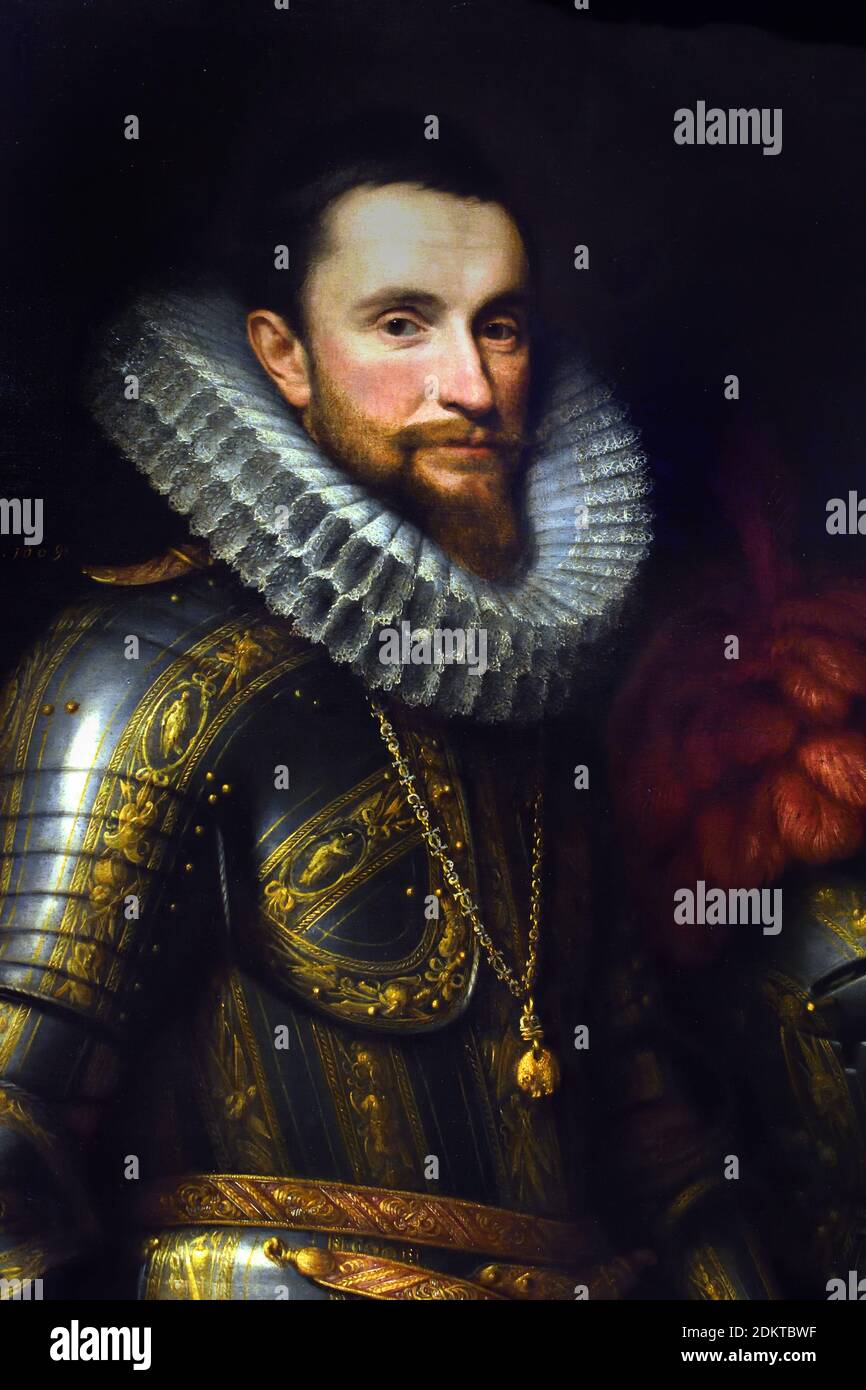 Ambrogio Spinola (1569-1630, Commander in Chief of the Spanish troops in the Southern Netherlands. Hip piece, standing in armor by a table on which stands the helmet with plumes. Command staff in the right hand, the left hand on the hilt of his epee. The emblem of the Order of the Golden Fleece on a chain around the neck. by Michiel Jansz. van Mierevelt (1566–1641) Holland, The Netherlands, Dutch, The Dutch Revolt 1566–1648 Low Countries against the rule of the Habsburg King Philip II of Spain Eighty Years, War, Spanish, Dutch, Netherlands, Stock Photohttps://www.alamy.com/image-license-details/?v=1https://www.alamy.com/ambrogio-spinola-1569-1630-commander-in-chief-of-the-spanish-troops-in-the-southern-netherlands-hip-piece-standing-in-armor-by-a-table-on-which-stands-the-helmet-with-plumes-command-staff-in-the-right-hand-the-left-hand-on-the-hilt-of-his-epee-the-emblem-of-the-order-of-the-golden-fleece-on-a-chain-around-the-neck-by-michiel-jansz-van-mierevelt-15661641-holland-the-netherlands-dutch-the-dutch-revolt-15661648-low-countries-against-the-rule-of-the-habsburg-king-philip-ii-of-spain-eighty-years-war-spanish-dutch-netherlands-image390842747.html
Ambrogio Spinola (1569-1630, Commander in Chief of the Spanish troops in the Southern Netherlands. Hip piece, standing in armor by a table on which stands the helmet with plumes. Command staff in the right hand, the left hand on the hilt of his epee. The emblem of the Order of the Golden Fleece on a chain around the neck. by Michiel Jansz. van Mierevelt (1566–1641) Holland, The Netherlands, Dutch, The Dutch Revolt 1566–1648 Low Countries against the rule of the Habsburg King Philip II of Spain Eighty Years, War, Spanish, Dutch, Netherlands, Stock Photohttps://www.alamy.com/image-license-details/?v=1https://www.alamy.com/ambrogio-spinola-1569-1630-commander-in-chief-of-the-spanish-troops-in-the-southern-netherlands-hip-piece-standing-in-armor-by-a-table-on-which-stands-the-helmet-with-plumes-command-staff-in-the-right-hand-the-left-hand-on-the-hilt-of-his-epee-the-emblem-of-the-order-of-the-golden-fleece-on-a-chain-around-the-neck-by-michiel-jansz-van-mierevelt-15661641-holland-the-netherlands-dutch-the-dutch-revolt-15661648-low-countries-against-the-rule-of-the-habsburg-king-philip-ii-of-spain-eighty-years-war-spanish-dutch-netherlands-image390842747.htmlRM2DKTBWF–Ambrogio Spinola (1569-1630, Commander in Chief of the Spanish troops in the Southern Netherlands. Hip piece, standing in armor by a table on which stands the helmet with plumes. Command staff in the right hand, the left hand on the hilt of his epee. The emblem of the Order of the Golden Fleece on a chain around the neck. by Michiel Jansz. van Mierevelt (1566–1641) Holland, The Netherlands, Dutch, The Dutch Revolt 1566–1648 Low Countries against the rule of the Habsburg King Philip II of Spain Eighty Years, War, Spanish, Dutch, Netherlands,
 AUSTRIA — 1908: An 12 heller scarlet postage stamp depicting portrait of Franz I. Definitive set issued for the 60th year of the reign of Austrian Monarch Franz Josef, Emperor of Austria, King of Hungary, and the other states of the Habsburg monarchy. Francis I (Francis Stephen) was Holy Roman Emperor (1745–1765), Archduke of Austria (1740–1765), Duke of Lorraine and Bar (1729–1737), and Grand Duke of Tuscany (1737–1765). He became the ruler of the Holy Roman Empire, Austria, and Tuscany through his marriage to Maria Theresa, daughter of Emperor Charles VI Stock Photohttps://www.alamy.com/image-license-details/?v=1https://www.alamy.com/austria-1908-an-12-heller-scarlet-postage-stamp-depicting-portrait-of-franz-i-definitive-set-issued-for-the-60th-year-of-the-reign-of-austrian-monarch-franz-josef-emperor-of-austria-king-of-hungary-and-the-other-states-of-the-habsburg-monarchy-francis-i-francis-stephen-was-holy-roman-emperor-17451765-archduke-of-austria-17401765-duke-of-lorraine-and-bar-17291737-and-grand-duke-of-tuscany-17371765-he-became-the-ruler-of-the-holy-roman-empire-austria-and-tuscany-through-his-marriage-to-maria-theresa-daughter-of-emperor-charles-vi-image499628852.html
AUSTRIA — 1908: An 12 heller scarlet postage stamp depicting portrait of Franz I. Definitive set issued for the 60th year of the reign of Austrian Monarch Franz Josef, Emperor of Austria, King of Hungary, and the other states of the Habsburg monarchy. Francis I (Francis Stephen) was Holy Roman Emperor (1745–1765), Archduke of Austria (1740–1765), Duke of Lorraine and Bar (1729–1737), and Grand Duke of Tuscany (1737–1765). He became the ruler of the Holy Roman Empire, Austria, and Tuscany through his marriage to Maria Theresa, daughter of Emperor Charles VI Stock Photohttps://www.alamy.com/image-license-details/?v=1https://www.alamy.com/austria-1908-an-12-heller-scarlet-postage-stamp-depicting-portrait-of-franz-i-definitive-set-issued-for-the-60th-year-of-the-reign-of-austrian-monarch-franz-josef-emperor-of-austria-king-of-hungary-and-the-other-states-of-the-habsburg-monarchy-francis-i-francis-stephen-was-holy-roman-emperor-17451765-archduke-of-austria-17401765-duke-of-lorraine-and-bar-17291737-and-grand-duke-of-tuscany-17371765-he-became-the-ruler-of-the-holy-roman-empire-austria-and-tuscany-through-his-marriage-to-maria-theresa-daughter-of-emperor-charles-vi-image499628852.htmlRF2M0T1KG–AUSTRIA — 1908: An 12 heller scarlet postage stamp depicting portrait of Franz I. Definitive set issued for the 60th year of the reign of Austrian Monarch Franz Josef, Emperor of Austria, King of Hungary, and the other states of the Habsburg monarchy. Francis I (Francis Stephen) was Holy Roman Emperor (1745–1765), Archduke of Austria (1740–1765), Duke of Lorraine and Bar (1729–1737), and Grand Duke of Tuscany (1737–1765). He became the ruler of the Holy Roman Empire, Austria, and Tuscany through his marriage to Maria Theresa, daughter of Emperor Charles VI
 the empire of austria can still be seen everywhere in austria and beyond the empire of austria can still be seen everywhere in austria Stock Photohttps://www.alamy.com/image-license-details/?v=1https://www.alamy.com/the-empire-of-austria-can-still-be-seen-everywhere-in-austria-and-beyond-the-empire-of-austria-can-still-be-seen-everywhere-in-austria-image619963720.html
the empire of austria can still be seen everywhere in austria and beyond the empire of austria can still be seen everywhere in austria Stock Photohttps://www.alamy.com/image-license-details/?v=1https://www.alamy.com/the-empire-of-austria-can-still-be-seen-everywhere-in-austria-and-beyond-the-empire-of-austria-can-still-be-seen-everywhere-in-austria-image619963720.htmlRM2Y0HP1C–the empire of austria can still be seen everywhere in austria and beyond the empire of austria can still be seen everywhere in austria
 AUSTRIA — 1913 January 1: 3 heller magenta postage stamp depicting portrait of Emperor Joseph II (1780-1790) by Adam Jakob. Definitive set issued for the 60th year of the reign of Austrian Monarch Franz Josef, Emperor of Austria, King of Hungary, and the other states of the Habsburg monarchy. Joseph II (Joseph Benedict Anthony Michael Adam) was Holy Roman Emperor from August 1765 and sole ruler of the Habsburg lands from November 29, 1780 until his death. He was the eldest son of Empress Maria Theresa and her husband, Emperor Francis I, and the brother of Marie Antoinette Stock Photohttps://www.alamy.com/image-license-details/?v=1https://www.alamy.com/austria-1913-january-1-3-heller-magenta-postage-stamp-depicting-portrait-of-emperor-joseph-ii-1780-1790-by-adam-jakob-definitive-set-issued-for-the-60th-year-of-the-reign-of-austrian-monarch-franz-josef-emperor-of-austria-king-of-hungary-and-the-other-states-of-the-habsburg-monarchy-joseph-ii-joseph-benedict-anthony-michael-adam-was-holy-roman-emperor-from-august-1765-and-sole-ruler-of-the-habsburg-lands-from-november-29-1780-until-his-death-he-was-the-eldest-son-of-empress-maria-theresa-and-her-husband-emperor-francis-i-and-the-brother-of-marie-antoinette-image630778468.html
AUSTRIA — 1913 January 1: 3 heller magenta postage stamp depicting portrait of Emperor Joseph II (1780-1790) by Adam Jakob. Definitive set issued for the 60th year of the reign of Austrian Monarch Franz Josef, Emperor of Austria, King of Hungary, and the other states of the Habsburg monarchy. Joseph II (Joseph Benedict Anthony Michael Adam) was Holy Roman Emperor from August 1765 and sole ruler of the Habsburg lands from November 29, 1780 until his death. He was the eldest son of Empress Maria Theresa and her husband, Emperor Francis I, and the brother of Marie Antoinette Stock Photohttps://www.alamy.com/image-license-details/?v=1https://www.alamy.com/austria-1913-january-1-3-heller-magenta-postage-stamp-depicting-portrait-of-emperor-joseph-ii-1780-1790-by-adam-jakob-definitive-set-issued-for-the-60th-year-of-the-reign-of-austrian-monarch-franz-josef-emperor-of-austria-king-of-hungary-and-the-other-states-of-the-habsburg-monarchy-joseph-ii-joseph-benedict-anthony-michael-adam-was-holy-roman-emperor-from-august-1765-and-sole-ruler-of-the-habsburg-lands-from-november-29-1780-until-his-death-he-was-the-eldest-son-of-empress-maria-theresa-and-her-husband-emperor-francis-i-and-the-brother-of-marie-antoinette-image630778468.htmlRF2YJ6CAC–AUSTRIA — 1913 January 1: 3 heller magenta postage stamp depicting portrait of Emperor Joseph II (1780-1790) by Adam Jakob. Definitive set issued for the 60th year of the reign of Austrian Monarch Franz Josef, Emperor of Austria, King of Hungary, and the other states of the Habsburg monarchy. Joseph II (Joseph Benedict Anthony Michael Adam) was Holy Roman Emperor from August 1765 and sole ruler of the Habsburg lands from November 29, 1780 until his death. He was the eldest son of Empress Maria Theresa and her husband, Emperor Francis I, and the brother of Marie Antoinette
 AUSTRIA — 1913: An 3 heller magenta postage stamp depicting portrait of Joseph II. Definitive set issued for the 60th year of the reign of Austrian Monarch Franz Josef, Emperor of Austria, King of Hungary, and the other states of the Habsburg monarchy. Joseph II (Joseph Benedict Anthony Michael Adam) was Holy Roman Emperor from August 1765 and sole ruler of the Habsburg lands from November 29, 1780 until his death. He was the eldest son of Empress Maria Theresa and her husband, Emperor Francis I, and the brother of Marie Antoinette, Maria Carolina of Austria and Maria Amalia, Duchess of Parma. Stock Photohttps://www.alamy.com/image-license-details/?v=1https://www.alamy.com/austria-1913-an-3-heller-magenta-postage-stamp-depicting-portrait-of-joseph-ii-definitive-set-issued-for-the-60th-year-of-the-reign-of-austrian-monarch-franz-josef-emperor-of-austria-king-of-hungary-and-the-other-states-of-the-habsburg-monarchy-joseph-ii-joseph-benedict-anthony-michael-adam-was-holy-roman-emperor-from-august-1765-and-sole-ruler-of-the-habsburg-lands-from-november-29-1780-until-his-death-he-was-the-eldest-son-of-empress-maria-theresa-and-her-husband-emperor-francis-i-and-the-brother-of-marie-antoinette-maria-carolina-of-austria-and-maria-amalia-duchess-of-parma-image499628710.html
AUSTRIA — 1913: An 3 heller magenta postage stamp depicting portrait of Joseph II. Definitive set issued for the 60th year of the reign of Austrian Monarch Franz Josef, Emperor of Austria, King of Hungary, and the other states of the Habsburg monarchy. Joseph II (Joseph Benedict Anthony Michael Adam) was Holy Roman Emperor from August 1765 and sole ruler of the Habsburg lands from November 29, 1780 until his death. He was the eldest son of Empress Maria Theresa and her husband, Emperor Francis I, and the brother of Marie Antoinette, Maria Carolina of Austria and Maria Amalia, Duchess of Parma. Stock Photohttps://www.alamy.com/image-license-details/?v=1https://www.alamy.com/austria-1913-an-3-heller-magenta-postage-stamp-depicting-portrait-of-joseph-ii-definitive-set-issued-for-the-60th-year-of-the-reign-of-austrian-monarch-franz-josef-emperor-of-austria-king-of-hungary-and-the-other-states-of-the-habsburg-monarchy-joseph-ii-joseph-benedict-anthony-michael-adam-was-holy-roman-emperor-from-august-1765-and-sole-ruler-of-the-habsburg-lands-from-november-29-1780-until-his-death-he-was-the-eldest-son-of-empress-maria-theresa-and-her-husband-emperor-francis-i-and-the-brother-of-marie-antoinette-maria-carolina-of-austria-and-maria-amalia-duchess-of-parma-image499628710.htmlRF2M0T1EE–AUSTRIA — 1913: An 3 heller magenta postage stamp depicting portrait of Joseph II. Definitive set issued for the 60th year of the reign of Austrian Monarch Franz Josef, Emperor of Austria, King of Hungary, and the other states of the Habsburg monarchy. Joseph II (Joseph Benedict Anthony Michael Adam) was Holy Roman Emperor from August 1765 and sole ruler of the Habsburg lands from November 29, 1780 until his death. He was the eldest son of Empress Maria Theresa and her husband, Emperor Francis I, and the brother of Marie Antoinette, Maria Carolina of Austria and Maria Amalia, Duchess of Parma.
 Charles V (24 February 1500 – 21 September 1558) was ruler of both the Holy Roman Empire from 1519 and the Spanish Empire (as Charles I of Spain) from 1516, as well as of the lands of the former Duchy of Burgundy from 1506. He stepped down from these and other positions by a series of abdications between 1554 and 1556. Through inheritance, Charles brought together under his rule extensive territories in western, central, and southern Europe, and the Spanish viceroyalties in the Americas and Asia. As a result, his domains spanned nearly 4 million square kilometres (1.5 million square miles), a Stock Photohttps://www.alamy.com/image-license-details/?v=1https://www.alamy.com/charles-v-24-february-1500-21-september-1558-was-ruler-of-both-the-holy-roman-empire-from-1519-and-the-spanish-empire-as-charles-i-of-spain-from-1516-as-well-as-of-the-lands-of-the-former-duchy-of-burgundy-from-1506-he-stepped-down-from-these-and-other-positions-by-a-series-of-abdications-between-1554-and-1556-through-inheritance-charles-brought-together-under-his-rule-extensive-territories-in-western-central-and-southern-europe-and-the-spanish-viceroyalties-in-the-americas-and-asia-as-a-result-his-domains-spanned-nearly-4-million-square-kilometres-15-million-square-miles-a-image344280596.html
Charles V (24 February 1500 – 21 September 1558) was ruler of both the Holy Roman Empire from 1519 and the Spanish Empire (as Charles I of Spain) from 1516, as well as of the lands of the former Duchy of Burgundy from 1506. He stepped down from these and other positions by a series of abdications between 1554 and 1556. Through inheritance, Charles brought together under his rule extensive territories in western, central, and southern Europe, and the Spanish viceroyalties in the Americas and Asia. As a result, his domains spanned nearly 4 million square kilometres (1.5 million square miles), a Stock Photohttps://www.alamy.com/image-license-details/?v=1https://www.alamy.com/charles-v-24-february-1500-21-september-1558-was-ruler-of-both-the-holy-roman-empire-from-1519-and-the-spanish-empire-as-charles-i-of-spain-from-1516-as-well-as-of-the-lands-of-the-former-duchy-of-burgundy-from-1506-he-stepped-down-from-these-and-other-positions-by-a-series-of-abdications-between-1554-and-1556-through-inheritance-charles-brought-together-under-his-rule-extensive-territories-in-western-central-and-southern-europe-and-the-spanish-viceroyalties-in-the-americas-and-asia-as-a-result-his-domains-spanned-nearly-4-million-square-kilometres-15-million-square-miles-a-image344280596.htmlRM2B039BG–Charles V (24 February 1500 – 21 September 1558) was ruler of both the Holy Roman Empire from 1519 and the Spanish Empire (as Charles I of Spain) from 1516, as well as of the lands of the former Duchy of Burgundy from 1506. He stepped down from these and other positions by a series of abdications between 1554 and 1556. Through inheritance, Charles brought together under his rule extensive territories in western, central, and southern Europe, and the Spanish viceroyalties in the Americas and Asia. As a result, his domains spanned nearly 4 million square kilometres (1.5 million square miles), a
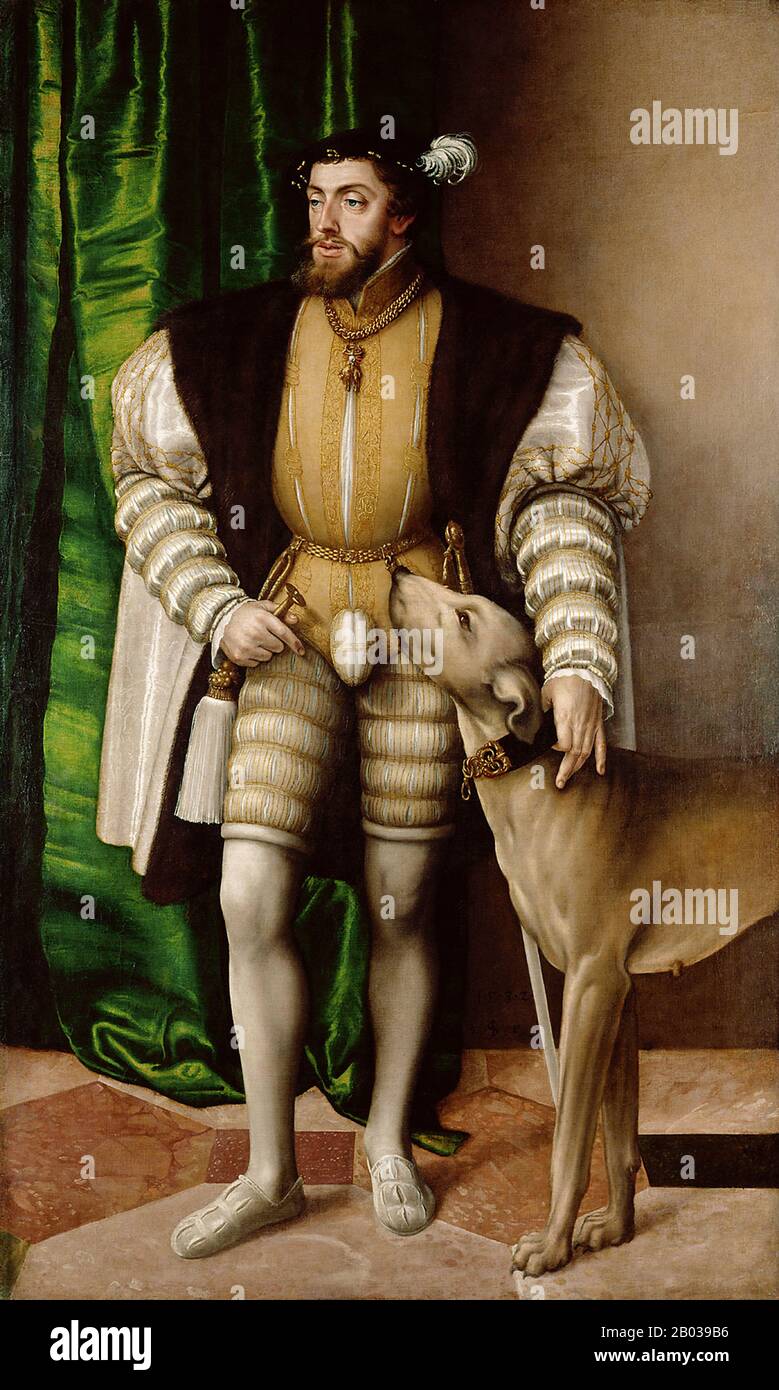 Charles V (24 February 1500 – 21 September 1558) was ruler of both the Holy Roman Empire from 1519 and the Spanish Empire (as Charles I of Spain) from 1516, as well as of the lands of the former Duchy of Burgundy from 1506. He stepped down from these and other positions by a series of abdications between 1554 and 1556. Through inheritance, Charles brought together under his rule extensive territories in western, central, and southern Europe, and the Spanish viceroyalties in the Americas and Asia. As a result, his domains spanned nearly 4 million square kilometres (1.5 million square miles), a Stock Photohttps://www.alamy.com/image-license-details/?v=1https://www.alamy.com/charles-v-24-february-1500-21-september-1558-was-ruler-of-both-the-holy-roman-empire-from-1519-and-the-spanish-empire-as-charles-i-of-spain-from-1516-as-well-as-of-the-lands-of-the-former-duchy-of-burgundy-from-1506-he-stepped-down-from-these-and-other-positions-by-a-series-of-abdications-between-1554-and-1556-through-inheritance-charles-brought-together-under-his-rule-extensive-territories-in-western-central-and-southern-europe-and-the-spanish-viceroyalties-in-the-americas-and-asia-as-a-result-his-domains-spanned-nearly-4-million-square-kilometres-15-million-square-miles-a-image344280586.html
Charles V (24 February 1500 – 21 September 1558) was ruler of both the Holy Roman Empire from 1519 and the Spanish Empire (as Charles I of Spain) from 1516, as well as of the lands of the former Duchy of Burgundy from 1506. He stepped down from these and other positions by a series of abdications between 1554 and 1556. Through inheritance, Charles brought together under his rule extensive territories in western, central, and southern Europe, and the Spanish viceroyalties in the Americas and Asia. As a result, his domains spanned nearly 4 million square kilometres (1.5 million square miles), a Stock Photohttps://www.alamy.com/image-license-details/?v=1https://www.alamy.com/charles-v-24-february-1500-21-september-1558-was-ruler-of-both-the-holy-roman-empire-from-1519-and-the-spanish-empire-as-charles-i-of-spain-from-1516-as-well-as-of-the-lands-of-the-former-duchy-of-burgundy-from-1506-he-stepped-down-from-these-and-other-positions-by-a-series-of-abdications-between-1554-and-1556-through-inheritance-charles-brought-together-under-his-rule-extensive-territories-in-western-central-and-southern-europe-and-the-spanish-viceroyalties-in-the-americas-and-asia-as-a-result-his-domains-spanned-nearly-4-million-square-kilometres-15-million-square-miles-a-image344280586.htmlRM2B039B6–Charles V (24 February 1500 – 21 September 1558) was ruler of both the Holy Roman Empire from 1519 and the Spanish Empire (as Charles I of Spain) from 1516, as well as of the lands of the former Duchy of Burgundy from 1506. He stepped down from these and other positions by a series of abdications between 1554 and 1556. Through inheritance, Charles brought together under his rule extensive territories in western, central, and southern Europe, and the Spanish viceroyalties in the Americas and Asia. As a result, his domains spanned nearly 4 million square kilometres (1.5 million square miles), a
 the empire of austria can still be seen everywhere in austria and beyond the empire of austria can still be seen everywhere in austria Stock Photohttps://www.alamy.com/image-license-details/?v=1https://www.alamy.com/the-empire-of-austria-can-still-be-seen-everywhere-in-austria-and-beyond-the-empire-of-austria-can-still-be-seen-everywhere-in-austria-image619963734.html
the empire of austria can still be seen everywhere in austria and beyond the empire of austria can still be seen everywhere in austria Stock Photohttps://www.alamy.com/image-license-details/?v=1https://www.alamy.com/the-empire-of-austria-can-still-be-seen-everywhere-in-austria-and-beyond-the-empire-of-austria-can-still-be-seen-everywhere-in-austria-image619963734.htmlRM2Y0HP1X–the empire of austria can still be seen everywhere in austria and beyond the empire of austria can still be seen everywhere in austria
 AUSTRIA — 1913: An 3 heller magenta postage stamp depicting portrait of Joseph II. Definitive set issued for the 60th year of the reign of Austrian Monarch Franz Josef, Emperor of Austria, King of Hungary, and the other states of the Habsburg monarchy. Joseph II (Joseph Benedict Anthony Michael Adam) was Holy Roman Emperor from August 1765 and sole ruler of the Habsburg lands from November 29, 1780 until his death. He was the eldest son of Empress Maria Theresa and her husband, Emperor Francis I, and the brother of Marie Antoinette, Maria Carolina of Austria and Maria Amalia, Duchess of Parma. Stock Photohttps://www.alamy.com/image-license-details/?v=1https://www.alamy.com/austria-1913-an-3-heller-magenta-postage-stamp-depicting-portrait-of-joseph-ii-definitive-set-issued-for-the-60th-year-of-the-reign-of-austrian-monarch-franz-josef-emperor-of-austria-king-of-hungary-and-the-other-states-of-the-habsburg-monarchy-joseph-ii-joseph-benedict-anthony-michael-adam-was-holy-roman-emperor-from-august-1765-and-sole-ruler-of-the-habsburg-lands-from-november-29-1780-until-his-death-he-was-the-eldest-son-of-empress-maria-theresa-and-her-husband-emperor-francis-i-and-the-brother-of-marie-antoinette-maria-carolina-of-austria-and-maria-amalia-duchess-of-parma-image499628713.html
AUSTRIA — 1913: An 3 heller magenta postage stamp depicting portrait of Joseph II. Definitive set issued for the 60th year of the reign of Austrian Monarch Franz Josef, Emperor of Austria, King of Hungary, and the other states of the Habsburg monarchy. Joseph II (Joseph Benedict Anthony Michael Adam) was Holy Roman Emperor from August 1765 and sole ruler of the Habsburg lands from November 29, 1780 until his death. He was the eldest son of Empress Maria Theresa and her husband, Emperor Francis I, and the brother of Marie Antoinette, Maria Carolina of Austria and Maria Amalia, Duchess of Parma. Stock Photohttps://www.alamy.com/image-license-details/?v=1https://www.alamy.com/austria-1913-an-3-heller-magenta-postage-stamp-depicting-portrait-of-joseph-ii-definitive-set-issued-for-the-60th-year-of-the-reign-of-austrian-monarch-franz-josef-emperor-of-austria-king-of-hungary-and-the-other-states-of-the-habsburg-monarchy-joseph-ii-joseph-benedict-anthony-michael-adam-was-holy-roman-emperor-from-august-1765-and-sole-ruler-of-the-habsburg-lands-from-november-29-1780-until-his-death-he-was-the-eldest-son-of-empress-maria-theresa-and-her-husband-emperor-francis-i-and-the-brother-of-marie-antoinette-maria-carolina-of-austria-and-maria-amalia-duchess-of-parma-image499628713.htmlRF2M0T1EH–AUSTRIA — 1913: An 3 heller magenta postage stamp depicting portrait of Joseph II. Definitive set issued for the 60th year of the reign of Austrian Monarch Franz Josef, Emperor of Austria, King of Hungary, and the other states of the Habsburg monarchy. Joseph II (Joseph Benedict Anthony Michael Adam) was Holy Roman Emperor from August 1765 and sole ruler of the Habsburg lands from November 29, 1780 until his death. He was the eldest son of Empress Maria Theresa and her husband, Emperor Francis I, and the brother of Marie Antoinette, Maria Carolina of Austria and Maria Amalia, Duchess of Parma.
 the empire of austria can still be seen everywhere in austria and beyond the empire of austria can still be seen everywhere in austria Stock Photohttps://www.alamy.com/image-license-details/?v=1https://www.alamy.com/the-empire-of-austria-can-still-be-seen-everywhere-in-austria-and-beyond-the-empire-of-austria-can-still-be-seen-everywhere-in-austria-image619963711.html
the empire of austria can still be seen everywhere in austria and beyond the empire of austria can still be seen everywhere in austria Stock Photohttps://www.alamy.com/image-license-details/?v=1https://www.alamy.com/the-empire-of-austria-can-still-be-seen-everywhere-in-austria-and-beyond-the-empire-of-austria-can-still-be-seen-everywhere-in-austria-image619963711.htmlRM2Y0HP13–the empire of austria can still be seen everywhere in austria and beyond the empire of austria can still be seen everywhere in austria
![AUSTRIA — 1913: An 30 heller olive-green postage stamp depicting portrait of Franz Joseph I as youth. Definitive set issued for the 60th year of the reign of Austrian Monarch Franz Josef, Emperor of Austria, King of Hungary, and the other states of the Habsburg monarchy. Franz Joseph I or Francis Joseph I was Emperor of Austria, King of Hungary, and the other states of the Habsburg monarchy from 2 December 1848 until his death on 21 November 1916.[1] In the early part of his reign, his realms and territories were referred to as the Austrian Empire, but were reconstituted as the dual monarchy Stock Photo AUSTRIA — 1913: An 30 heller olive-green postage stamp depicting portrait of Franz Joseph I as youth. Definitive set issued for the 60th year of the reign of Austrian Monarch Franz Josef, Emperor of Austria, King of Hungary, and the other states of the Habsburg monarchy. Franz Joseph I or Francis Joseph I was Emperor of Austria, King of Hungary, and the other states of the Habsburg monarchy from 2 December 1848 until his death on 21 November 1916.[1] In the early part of his reign, his realms and territories were referred to as the Austrian Empire, but were reconstituted as the dual monarchy Stock Photo](https://c8.alamy.com/comp/2M0T1M3/austria-1913-an-30-heller-olive-green-postage-stamp-depicting-portrait-of-franz-joseph-i-as-youth-definitive-set-issued-for-the-60th-year-of-the-reign-of-austrian-monarch-franz-josef-emperor-of-austria-king-of-hungary-and-the-other-states-of-the-habsburg-monarchy-franz-joseph-i-or-francis-joseph-i-was-emperor-of-austria-king-of-hungary-and-the-other-states-of-the-habsburg-monarchy-from-2-december-1848-until-his-death-on-21-november-1916-1-in-the-early-part-of-his-reign-his-realms-and-territories-were-referred-to-as-the-austrian-empire-but-were-reconstituted-as-the-dual-monarchy-2M0T1M3.jpg) AUSTRIA — 1913: An 30 heller olive-green postage stamp depicting portrait of Franz Joseph I as youth. Definitive set issued for the 60th year of the reign of Austrian Monarch Franz Josef, Emperor of Austria, King of Hungary, and the other states of the Habsburg monarchy. Franz Joseph I or Francis Joseph I was Emperor of Austria, King of Hungary, and the other states of the Habsburg monarchy from 2 December 1848 until his death on 21 November 1916.[1] In the early part of his reign, his realms and territories were referred to as the Austrian Empire, but were reconstituted as the dual monarchy Stock Photohttps://www.alamy.com/image-license-details/?v=1https://www.alamy.com/austria-1913-an-30-heller-olive-green-postage-stamp-depicting-portrait-of-franz-joseph-i-as-youth-definitive-set-issued-for-the-60th-year-of-the-reign-of-austrian-monarch-franz-josef-emperor-of-austria-king-of-hungary-and-the-other-states-of-the-habsburg-monarchy-franz-joseph-i-or-francis-joseph-i-was-emperor-of-austria-king-of-hungary-and-the-other-states-of-the-habsburg-monarchy-from-2-december-1848-until-his-death-on-21-november-1916-1-in-the-early-part-of-his-reign-his-realms-and-territories-were-referred-to-as-the-austrian-empire-but-were-reconstituted-as-the-dual-monarchy-image499628867.html
AUSTRIA — 1913: An 30 heller olive-green postage stamp depicting portrait of Franz Joseph I as youth. Definitive set issued for the 60th year of the reign of Austrian Monarch Franz Josef, Emperor of Austria, King of Hungary, and the other states of the Habsburg monarchy. Franz Joseph I or Francis Joseph I was Emperor of Austria, King of Hungary, and the other states of the Habsburg monarchy from 2 December 1848 until his death on 21 November 1916.[1] In the early part of his reign, his realms and territories were referred to as the Austrian Empire, but were reconstituted as the dual monarchy Stock Photohttps://www.alamy.com/image-license-details/?v=1https://www.alamy.com/austria-1913-an-30-heller-olive-green-postage-stamp-depicting-portrait-of-franz-joseph-i-as-youth-definitive-set-issued-for-the-60th-year-of-the-reign-of-austrian-monarch-franz-josef-emperor-of-austria-king-of-hungary-and-the-other-states-of-the-habsburg-monarchy-franz-joseph-i-or-francis-joseph-i-was-emperor-of-austria-king-of-hungary-and-the-other-states-of-the-habsburg-monarchy-from-2-december-1848-until-his-death-on-21-november-1916-1-in-the-early-part-of-his-reign-his-realms-and-territories-were-referred-to-as-the-austrian-empire-but-were-reconstituted-as-the-dual-monarchy-image499628867.htmlRF2M0T1M3–AUSTRIA — 1913: An 30 heller olive-green postage stamp depicting portrait of Franz Joseph I as youth. Definitive set issued for the 60th year of the reign of Austrian Monarch Franz Josef, Emperor of Austria, King of Hungary, and the other states of the Habsburg monarchy. Franz Joseph I or Francis Joseph I was Emperor of Austria, King of Hungary, and the other states of the Habsburg monarchy from 2 December 1848 until his death on 21 November 1916.[1] In the early part of his reign, his realms and territories were referred to as the Austrian Empire, but were reconstituted as the dual monarchy
 AUSTRIA — 1916 October 21: 1 heller blackish grey-green postage due stamp depicting portrait of King Karl VI, issued for the 60th year of the reign of Austrian Monarch Franz Josef, Emperor of Austria. Regular Issue of 1908 with Emperor Charles VI (1711-1740), overprinted in Carmine 'PORTO' Stock Photohttps://www.alamy.com/image-license-details/?v=1https://www.alamy.com/austria-1916-october-21-1-heller-blackish-grey-green-postage-due-stamp-depicting-portrait-of-king-karl-vi-issued-for-the-60th-year-of-the-reign-of-austrian-monarch-franz-josef-emperor-of-austria-regular-issue-of-1908-with-emperor-charles-vi-1711-1740-overprinted-in-carmine-porto-image631378719.html
AUSTRIA — 1916 October 21: 1 heller blackish grey-green postage due stamp depicting portrait of King Karl VI, issued for the 60th year of the reign of Austrian Monarch Franz Josef, Emperor of Austria. Regular Issue of 1908 with Emperor Charles VI (1711-1740), overprinted in Carmine 'PORTO' Stock Photohttps://www.alamy.com/image-license-details/?v=1https://www.alamy.com/austria-1916-october-21-1-heller-blackish-grey-green-postage-due-stamp-depicting-portrait-of-king-karl-vi-issued-for-the-60th-year-of-the-reign-of-austrian-monarch-franz-josef-emperor-of-austria-regular-issue-of-1908-with-emperor-charles-vi-1711-1740-overprinted-in-carmine-porto-image631378719.htmlRF2YK5NYY–AUSTRIA — 1916 October 21: 1 heller blackish grey-green postage due stamp depicting portrait of King Karl VI, issued for the 60th year of the reign of Austrian Monarch Franz Josef, Emperor of Austria. Regular Issue of 1908 with Emperor Charles VI (1711-1740), overprinted in Carmine 'PORTO'
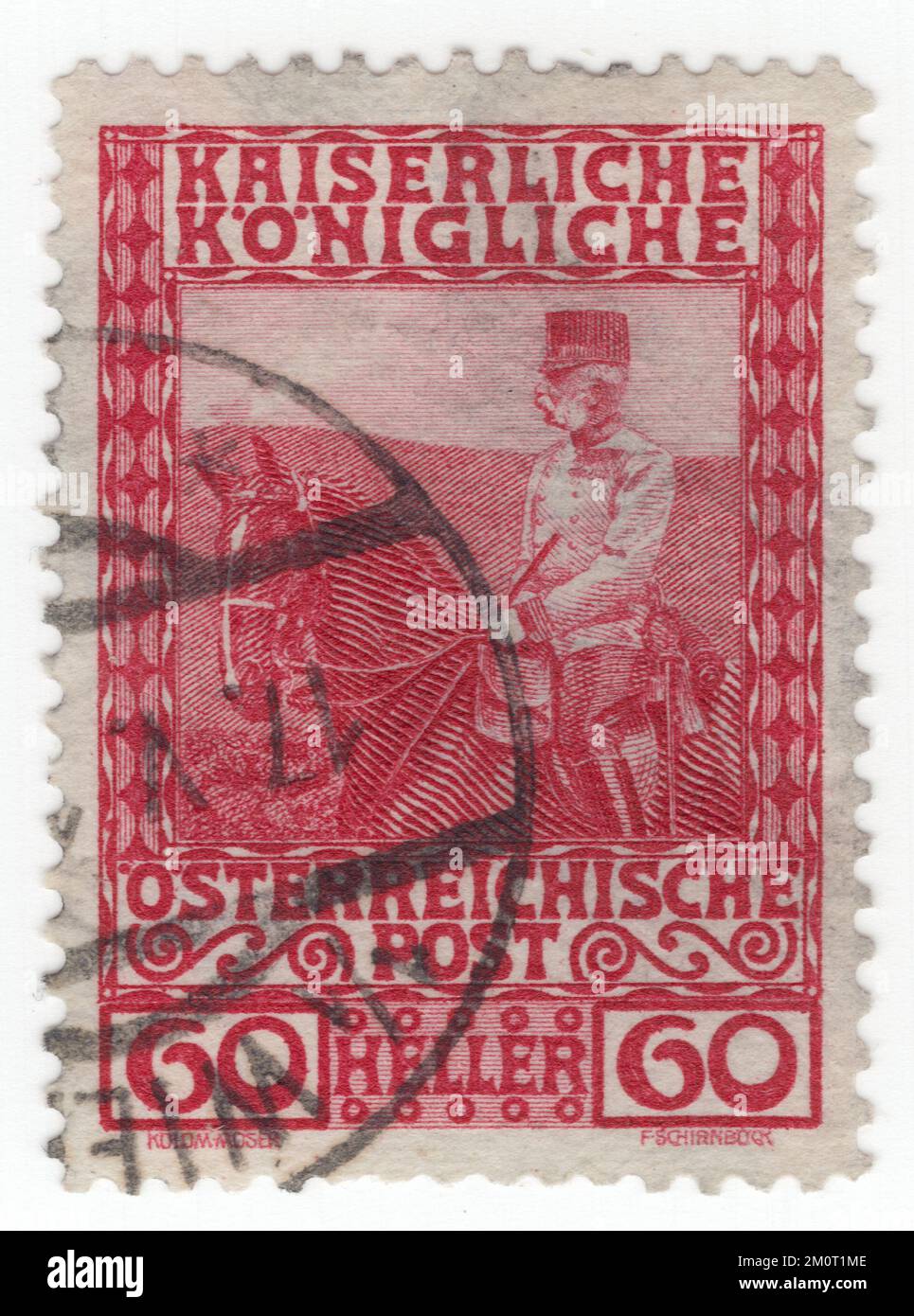 AUSTRIA — 1908: An 350 heller dark green postage stamp depicting portrait of Franz Joseph I. Definitive set issued for the 60th year of the reign of Austrian Monarch Franz Josef, Emperor of Austria, King of Hungary, and the other states of the Habsburg monarchy. Franz Joseph I or Francis Joseph I was Emperor of Austria, King of Hungary, and the other states of the Habsburg monarchy from 2 December 1848 until his death on 21 November 1916. In the early part of his reign, his realms and territories were referred to as the Austrian Empire, but were reconstituted as the dual monarchy Stock Photohttps://www.alamy.com/image-license-details/?v=1https://www.alamy.com/austria-1908-an-350-heller-dark-green-postage-stamp-depicting-portrait-of-franz-joseph-i-definitive-set-issued-for-the-60th-year-of-the-reign-of-austrian-monarch-franz-josef-emperor-of-austria-king-of-hungary-and-the-other-states-of-the-habsburg-monarchy-franz-joseph-i-or-francis-joseph-i-was-emperor-of-austria-king-of-hungary-and-the-other-states-of-the-habsburg-monarchy-from-2-december-1848-until-his-death-on-21-november-1916-in-the-early-part-of-his-reign-his-realms-and-territories-were-referred-to-as-the-austrian-empire-but-were-reconstituted-as-the-dual-monarchy-image499628878.html
AUSTRIA — 1908: An 350 heller dark green postage stamp depicting portrait of Franz Joseph I. Definitive set issued for the 60th year of the reign of Austrian Monarch Franz Josef, Emperor of Austria, King of Hungary, and the other states of the Habsburg monarchy. Franz Joseph I or Francis Joseph I was Emperor of Austria, King of Hungary, and the other states of the Habsburg monarchy from 2 December 1848 until his death on 21 November 1916. In the early part of his reign, his realms and territories were referred to as the Austrian Empire, but were reconstituted as the dual monarchy Stock Photohttps://www.alamy.com/image-license-details/?v=1https://www.alamy.com/austria-1908-an-350-heller-dark-green-postage-stamp-depicting-portrait-of-franz-joseph-i-definitive-set-issued-for-the-60th-year-of-the-reign-of-austrian-monarch-franz-josef-emperor-of-austria-king-of-hungary-and-the-other-states-of-the-habsburg-monarchy-franz-joseph-i-or-francis-joseph-i-was-emperor-of-austria-king-of-hungary-and-the-other-states-of-the-habsburg-monarchy-from-2-december-1848-until-his-death-on-21-november-1916-in-the-early-part-of-his-reign-his-realms-and-territories-were-referred-to-as-the-austrian-empire-but-were-reconstituted-as-the-dual-monarchy-image499628878.htmlRF2M0T1ME–AUSTRIA — 1908: An 350 heller dark green postage stamp depicting portrait of Franz Joseph I. Definitive set issued for the 60th year of the reign of Austrian Monarch Franz Josef, Emperor of Austria, King of Hungary, and the other states of the Habsburg monarchy. Franz Joseph I or Francis Joseph I was Emperor of Austria, King of Hungary, and the other states of the Habsburg monarchy from 2 December 1848 until his death on 21 November 1916. In the early part of his reign, his realms and territories were referred to as the Austrian Empire, but were reconstituted as the dual monarchy
 the empire of austria can still be seen everywhere in austria and beyond the empire of austria can still be seen everywhere in austria Stock Photohttps://www.alamy.com/image-license-details/?v=1https://www.alamy.com/the-empire-of-austria-can-still-be-seen-everywhere-in-austria-and-beyond-the-empire-of-austria-can-still-be-seen-everywhere-in-austria-image619963718.html
the empire of austria can still be seen everywhere in austria and beyond the empire of austria can still be seen everywhere in austria Stock Photohttps://www.alamy.com/image-license-details/?v=1https://www.alamy.com/the-empire-of-austria-can-still-be-seen-everywhere-in-austria-and-beyond-the-empire-of-austria-can-still-be-seen-everywhere-in-austria-image619963718.htmlRM2Y0HP1A–the empire of austria can still be seen everywhere in austria and beyond the empire of austria can still be seen everywhere in austria
![AUSTRIA — 1913: An 10 heller rose postage stamp depicting portrait of Franz Joseph I. Definitive set issued for the 60th year of the reign of Austrian Monarch Franz Josef, Emperor of Austria, King of Hungary, and the other states of the Habsburg monarchy. Franz Joseph I or Francis Joseph I was Emperor of Austria, King of Hungary, and the other states of the Habsburg monarchy from 2 December 1848 until his death on 21 November 1916.[1] In the early part of his reign, his realms and territories were referred to as the Austrian Empire, but were reconstituted as the dual monarchy Stock Photo AUSTRIA — 1913: An 10 heller rose postage stamp depicting portrait of Franz Joseph I. Definitive set issued for the 60th year of the reign of Austrian Monarch Franz Josef, Emperor of Austria, King of Hungary, and the other states of the Habsburg monarchy. Franz Joseph I or Francis Joseph I was Emperor of Austria, King of Hungary, and the other states of the Habsburg monarchy from 2 December 1848 until his death on 21 November 1916.[1] In the early part of his reign, his realms and territories were referred to as the Austrian Empire, but were reconstituted as the dual monarchy Stock Photo](https://c8.alamy.com/comp/2M0T1H2/austria-1913-an-10-heller-rose-postage-stamp-depicting-portrait-of-franz-joseph-i-definitive-set-issued-for-the-60th-year-of-the-reign-of-austrian-monarch-franz-josef-emperor-of-austria-king-of-hungary-and-the-other-states-of-the-habsburg-monarchy-franz-joseph-i-or-francis-joseph-i-was-emperor-of-austria-king-of-hungary-and-the-other-states-of-the-habsburg-monarchy-from-2-december-1848-until-his-death-on-21-november-1916-1-in-the-early-part-of-his-reign-his-realms-and-territories-were-referred-to-as-the-austrian-empire-but-were-reconstituted-as-the-dual-monarchy-2M0T1H2.jpg) AUSTRIA — 1913: An 10 heller rose postage stamp depicting portrait of Franz Joseph I. Definitive set issued for the 60th year of the reign of Austrian Monarch Franz Josef, Emperor of Austria, King of Hungary, and the other states of the Habsburg monarchy. Franz Joseph I or Francis Joseph I was Emperor of Austria, King of Hungary, and the other states of the Habsburg monarchy from 2 December 1848 until his death on 21 November 1916.[1] In the early part of his reign, his realms and territories were referred to as the Austrian Empire, but were reconstituted as the dual monarchy Stock Photohttps://www.alamy.com/image-license-details/?v=1https://www.alamy.com/austria-1913-an-10-heller-rose-postage-stamp-depicting-portrait-of-franz-joseph-i-definitive-set-issued-for-the-60th-year-of-the-reign-of-austrian-monarch-franz-josef-emperor-of-austria-king-of-hungary-and-the-other-states-of-the-habsburg-monarchy-franz-joseph-i-or-francis-joseph-i-was-emperor-of-austria-king-of-hungary-and-the-other-states-of-the-habsburg-monarchy-from-2-december-1848-until-his-death-on-21-november-1916-1-in-the-early-part-of-his-reign-his-realms-and-territories-were-referred-to-as-the-austrian-empire-but-were-reconstituted-as-the-dual-monarchy-image499628782.html
AUSTRIA — 1913: An 10 heller rose postage stamp depicting portrait of Franz Joseph I. Definitive set issued for the 60th year of the reign of Austrian Monarch Franz Josef, Emperor of Austria, King of Hungary, and the other states of the Habsburg monarchy. Franz Joseph I or Francis Joseph I was Emperor of Austria, King of Hungary, and the other states of the Habsburg monarchy from 2 December 1848 until his death on 21 November 1916.[1] In the early part of his reign, his realms and territories were referred to as the Austrian Empire, but were reconstituted as the dual monarchy Stock Photohttps://www.alamy.com/image-license-details/?v=1https://www.alamy.com/austria-1913-an-10-heller-rose-postage-stamp-depicting-portrait-of-franz-joseph-i-definitive-set-issued-for-the-60th-year-of-the-reign-of-austrian-monarch-franz-josef-emperor-of-austria-king-of-hungary-and-the-other-states-of-the-habsburg-monarchy-franz-joseph-i-or-francis-joseph-i-was-emperor-of-austria-king-of-hungary-and-the-other-states-of-the-habsburg-monarchy-from-2-december-1848-until-his-death-on-21-november-1916-1-in-the-early-part-of-his-reign-his-realms-and-territories-were-referred-to-as-the-austrian-empire-but-were-reconstituted-as-the-dual-monarchy-image499628782.htmlRF2M0T1H2–AUSTRIA — 1913: An 10 heller rose postage stamp depicting portrait of Franz Joseph I. Definitive set issued for the 60th year of the reign of Austrian Monarch Franz Josef, Emperor of Austria, King of Hungary, and the other states of the Habsburg monarchy. Franz Joseph I or Francis Joseph I was Emperor of Austria, King of Hungary, and the other states of the Habsburg monarchy from 2 December 1848 until his death on 21 November 1916.[1] In the early part of his reign, his realms and territories were referred to as the Austrian Empire, but were reconstituted as the dual monarchy
 the empire of austria can still be seen everywhere in austria and beyond the empire of austria can still be seen everywhere in austria Stock Photohttps://www.alamy.com/image-license-details/?v=1https://www.alamy.com/the-empire-of-austria-can-still-be-seen-everywhere-in-austria-and-beyond-the-empire-of-austria-can-still-be-seen-everywhere-in-austria-image619469206.html
the empire of austria can still be seen everywhere in austria and beyond the empire of austria can still be seen everywhere in austria Stock Photohttps://www.alamy.com/image-license-details/?v=1https://www.alamy.com/the-empire-of-austria-can-still-be-seen-everywhere-in-austria-and-beyond-the-empire-of-austria-can-still-be-seen-everywhere-in-austria-image619469206.htmlRM2XYR786–the empire of austria can still be seen everywhere in austria and beyond the empire of austria can still be seen everywhere in austria
 the empire of austria can still be seen everywhere in austria and beyond the empire of austria can still be seen everywhere in austria Stock Photohttps://www.alamy.com/image-license-details/?v=1https://www.alamy.com/the-empire-of-austria-can-still-be-seen-everywhere-in-austria-and-beyond-the-empire-of-austria-can-still-be-seen-everywhere-in-austria-image619668758.html
the empire of austria can still be seen everywhere in austria and beyond the empire of austria can still be seen everywhere in austria Stock Photohttps://www.alamy.com/image-license-details/?v=1https://www.alamy.com/the-empire-of-austria-can-still-be-seen-everywhere-in-austria-and-beyond-the-empire-of-austria-can-still-be-seen-everywhere-in-austria-image619668758.htmlRM2Y049R2–the empire of austria can still be seen everywhere in austria and beyond the empire of austria can still be seen everywhere in austria
 AUSTRIA — 1908: An 50 heller dark green postage stamp depicting portrait of Franz Joseph I. Definitive set issued for the 60th year of the reign of Austrian Monarch Franz Josef, Emperor of Austria, King of Hungary, and the other states of the Habsburg monarchy. Franz Joseph I or Francis Joseph I was Emperor of Austria, King of Hungary, and the other states of the Habsburg monarchy from 2 December 1848 until his death on 21 November 1916. In the early part of his reign, his realms and territories were referred to as the Austrian Empire, but were reconstituted as the dual monarchy Stock Photohttps://www.alamy.com/image-license-details/?v=1https://www.alamy.com/austria-1908-an-50-heller-dark-green-postage-stamp-depicting-portrait-of-franz-joseph-i-definitive-set-issued-for-the-60th-year-of-the-reign-of-austrian-monarch-franz-josef-emperor-of-austria-king-of-hungary-and-the-other-states-of-the-habsburg-monarchy-franz-joseph-i-or-francis-joseph-i-was-emperor-of-austria-king-of-hungary-and-the-other-states-of-the-habsburg-monarchy-from-2-december-1848-until-his-death-on-21-november-1916-in-the-early-part-of-his-reign-his-realms-and-territories-were-referred-to-as-the-austrian-empire-but-were-reconstituted-as-the-dual-monarchy-image499628876.html
AUSTRIA — 1908: An 50 heller dark green postage stamp depicting portrait of Franz Joseph I. Definitive set issued for the 60th year of the reign of Austrian Monarch Franz Josef, Emperor of Austria, King of Hungary, and the other states of the Habsburg monarchy. Franz Joseph I or Francis Joseph I was Emperor of Austria, King of Hungary, and the other states of the Habsburg monarchy from 2 December 1848 until his death on 21 November 1916. In the early part of his reign, his realms and territories were referred to as the Austrian Empire, but were reconstituted as the dual monarchy Stock Photohttps://www.alamy.com/image-license-details/?v=1https://www.alamy.com/austria-1908-an-50-heller-dark-green-postage-stamp-depicting-portrait-of-franz-joseph-i-definitive-set-issued-for-the-60th-year-of-the-reign-of-austrian-monarch-franz-josef-emperor-of-austria-king-of-hungary-and-the-other-states-of-the-habsburg-monarchy-franz-joseph-i-or-francis-joseph-i-was-emperor-of-austria-king-of-hungary-and-the-other-states-of-the-habsburg-monarchy-from-2-december-1848-until-his-death-on-21-november-1916-in-the-early-part-of-his-reign-his-realms-and-territories-were-referred-to-as-the-austrian-empire-but-were-reconstituted-as-the-dual-monarchy-image499628876.htmlRF2M0T1MC–AUSTRIA — 1908: An 50 heller dark green postage stamp depicting portrait of Franz Joseph I. Definitive set issued for the 60th year of the reign of Austrian Monarch Franz Josef, Emperor of Austria, King of Hungary, and the other states of the Habsburg monarchy. Franz Joseph I or Francis Joseph I was Emperor of Austria, King of Hungary, and the other states of the Habsburg monarchy from 2 December 1848 until his death on 21 November 1916. In the early part of his reign, his realms and territories were referred to as the Austrian Empire, but were reconstituted as the dual monarchy
 the empire of austria can still be seen everywhere in austria and beyond the empire of austria can still be seen everywhere in austria Stock Photohttps://www.alamy.com/image-license-details/?v=1https://www.alamy.com/the-empire-of-austria-can-still-be-seen-everywhere-in-austria-and-beyond-the-empire-of-austria-can-still-be-seen-everywhere-in-austria-image619668773.html
the empire of austria can still be seen everywhere in austria and beyond the empire of austria can still be seen everywhere in austria Stock Photohttps://www.alamy.com/image-license-details/?v=1https://www.alamy.com/the-empire-of-austria-can-still-be-seen-everywhere-in-austria-and-beyond-the-empire-of-austria-can-still-be-seen-everywhere-in-austria-image619668773.htmlRM2Y049RH–the empire of austria can still be seen everywhere in austria and beyond the empire of austria can still be seen everywhere in austria
 the empire of austria can still be seen everywhere in austria and beyond the empire of austria can still be seen everywhere in austria Stock Photohttps://www.alamy.com/image-license-details/?v=1https://www.alamy.com/the-empire-of-austria-can-still-be-seen-everywhere-in-austria-and-beyond-the-empire-of-austria-can-still-be-seen-everywhere-in-austria-image619668790.html
the empire of austria can still be seen everywhere in austria and beyond the empire of austria can still be seen everywhere in austria Stock Photohttps://www.alamy.com/image-license-details/?v=1https://www.alamy.com/the-empire-of-austria-can-still-be-seen-everywhere-in-austria-and-beyond-the-empire-of-austria-can-still-be-seen-everywhere-in-austria-image619668790.htmlRM2Y049T6–the empire of austria can still be seen everywhere in austria and beyond the empire of austria can still be seen everywhere in austria
![AUSTRIA — 1913: An 25 heller ultramarine postage stamp depicting portrait of Franz Joseph I. Definitive set issued for the 60th year of the reign of Austrian Monarch Franz Josef, Emperor of Austria, King of Hungary, and the other states of the Habsburg monarchy. Franz Joseph I or Francis Joseph I was Emperor of Austria, King of Hungary, and the other states of the Habsburg monarchy from 2 December 1848 until his death on 21 November 1916.[1] In the early part of his reign, his realms and territories were referred to as the Austrian Empire, but were reconstituted as the dual monarchy Stock Photo AUSTRIA — 1913: An 25 heller ultramarine postage stamp depicting portrait of Franz Joseph I. Definitive set issued for the 60th year of the reign of Austrian Monarch Franz Josef, Emperor of Austria, King of Hungary, and the other states of the Habsburg monarchy. Franz Joseph I or Francis Joseph I was Emperor of Austria, King of Hungary, and the other states of the Habsburg monarchy from 2 December 1848 until his death on 21 November 1916.[1] In the early part of his reign, his realms and territories were referred to as the Austrian Empire, but were reconstituted as the dual monarchy Stock Photo](https://c8.alamy.com/comp/2M0T1KX/austria-1913-an-25-heller-ultramarine-postage-stamp-depicting-portrait-of-franz-joseph-i-definitive-set-issued-for-the-60th-year-of-the-reign-of-austrian-monarch-franz-josef-emperor-of-austria-king-of-hungary-and-the-other-states-of-the-habsburg-monarchy-franz-joseph-i-or-francis-joseph-i-was-emperor-of-austria-king-of-hungary-and-the-other-states-of-the-habsburg-monarchy-from-2-december-1848-until-his-death-on-21-november-1916-1-in-the-early-part-of-his-reign-his-realms-and-territories-were-referred-to-as-the-austrian-empire-but-were-reconstituted-as-the-dual-monarchy-2M0T1KX.jpg) AUSTRIA — 1913: An 25 heller ultramarine postage stamp depicting portrait of Franz Joseph I. Definitive set issued for the 60th year of the reign of Austrian Monarch Franz Josef, Emperor of Austria, King of Hungary, and the other states of the Habsburg monarchy. Franz Joseph I or Francis Joseph I was Emperor of Austria, King of Hungary, and the other states of the Habsburg monarchy from 2 December 1848 until his death on 21 November 1916.[1] In the early part of his reign, his realms and territories were referred to as the Austrian Empire, but were reconstituted as the dual monarchy Stock Photohttps://www.alamy.com/image-license-details/?v=1https://www.alamy.com/austria-1913-an-25-heller-ultramarine-postage-stamp-depicting-portrait-of-franz-joseph-i-definitive-set-issued-for-the-60th-year-of-the-reign-of-austrian-monarch-franz-josef-emperor-of-austria-king-of-hungary-and-the-other-states-of-the-habsburg-monarchy-franz-joseph-i-or-francis-joseph-i-was-emperor-of-austria-king-of-hungary-and-the-other-states-of-the-habsburg-monarchy-from-2-december-1848-until-his-death-on-21-november-1916-1-in-the-early-part-of-his-reign-his-realms-and-territories-were-referred-to-as-the-austrian-empire-but-were-reconstituted-as-the-dual-monarchy-image499628862.html
AUSTRIA — 1913: An 25 heller ultramarine postage stamp depicting portrait of Franz Joseph I. Definitive set issued for the 60th year of the reign of Austrian Monarch Franz Josef, Emperor of Austria, King of Hungary, and the other states of the Habsburg monarchy. Franz Joseph I or Francis Joseph I was Emperor of Austria, King of Hungary, and the other states of the Habsburg monarchy from 2 December 1848 until his death on 21 November 1916.[1] In the early part of his reign, his realms and territories were referred to as the Austrian Empire, but were reconstituted as the dual monarchy Stock Photohttps://www.alamy.com/image-license-details/?v=1https://www.alamy.com/austria-1913-an-25-heller-ultramarine-postage-stamp-depicting-portrait-of-franz-joseph-i-definitive-set-issued-for-the-60th-year-of-the-reign-of-austrian-monarch-franz-josef-emperor-of-austria-king-of-hungary-and-the-other-states-of-the-habsburg-monarchy-franz-joseph-i-or-francis-joseph-i-was-emperor-of-austria-king-of-hungary-and-the-other-states-of-the-habsburg-monarchy-from-2-december-1848-until-his-death-on-21-november-1916-1-in-the-early-part-of-his-reign-his-realms-and-territories-were-referred-to-as-the-austrian-empire-but-were-reconstituted-as-the-dual-monarchy-image499628862.htmlRF2M0T1KX–AUSTRIA — 1913: An 25 heller ultramarine postage stamp depicting portrait of Franz Joseph I. Definitive set issued for the 60th year of the reign of Austrian Monarch Franz Josef, Emperor of Austria, King of Hungary, and the other states of the Habsburg monarchy. Franz Joseph I or Francis Joseph I was Emperor of Austria, King of Hungary, and the other states of the Habsburg monarchy from 2 December 1848 until his death on 21 November 1916.[1] In the early part of his reign, his realms and territories were referred to as the Austrian Empire, but were reconstituted as the dual monarchy
 the empire of austria can still be seen everywhere in austria and beyond the empire of austria can still be seen everywhere in austria Stock Photohttps://www.alamy.com/image-license-details/?v=1https://www.alamy.com/the-empire-of-austria-can-still-be-seen-everywhere-in-austria-and-beyond-the-empire-of-austria-can-still-be-seen-everywhere-in-austria-image619668736.html
the empire of austria can still be seen everywhere in austria and beyond the empire of austria can still be seen everywhere in austria Stock Photohttps://www.alamy.com/image-license-details/?v=1https://www.alamy.com/the-empire-of-austria-can-still-be-seen-everywhere-in-austria-and-beyond-the-empire-of-austria-can-still-be-seen-everywhere-in-austria-image619668736.htmlRM2Y049P8–the empire of austria can still be seen everywhere in austria and beyond the empire of austria can still be seen everywhere in austria
 the empire of austria can still be seen everywhere in austria and beyond the empire of austria can still be seen everywhere in austria Stock Photohttps://www.alamy.com/image-license-details/?v=1https://www.alamy.com/the-empire-of-austria-can-still-be-seen-everywhere-in-austria-and-beyond-the-empire-of-austria-can-still-be-seen-everywhere-in-austria-image619963572.html
the empire of austria can still be seen everywhere in austria and beyond the empire of austria can still be seen everywhere in austria Stock Photohttps://www.alamy.com/image-license-details/?v=1https://www.alamy.com/the-empire-of-austria-can-still-be-seen-everywhere-in-austria-and-beyond-the-empire-of-austria-can-still-be-seen-everywhere-in-austria-image619963572.htmlRM2Y0HNT4–the empire of austria can still be seen everywhere in austria and beyond the empire of austria can still be seen everywhere in austria
![AUSTRIA — 1908: An 35 heller slate postage stamp depicting portrait of Franz Joseph I in middle age. Definitive set issued for the 60th year of the reign of Austrian Monarch Franz Josef, Emperor of Austria, King of Hungary, and the other states of the Habsburg monarchy. Franz Joseph I or Francis Joseph I was Emperor of Austria, King of Hungary, and the other states of the Habsburg monarchy from 2 December 1848 until his death on 21 November 1916.[1] In the early part of his reign, his realms and territories were referred to as the Austrian Empire, but were reconstituted as the dual monarchy Stock Photo AUSTRIA — 1908: An 35 heller slate postage stamp depicting portrait of Franz Joseph I in middle age. Definitive set issued for the 60th year of the reign of Austrian Monarch Franz Josef, Emperor of Austria, King of Hungary, and the other states of the Habsburg monarchy. Franz Joseph I or Francis Joseph I was Emperor of Austria, King of Hungary, and the other states of the Habsburg monarchy from 2 December 1848 until his death on 21 November 1916.[1] In the early part of his reign, his realms and territories were referred to as the Austrian Empire, but were reconstituted as the dual monarchy Stock Photo](https://c8.alamy.com/comp/2M0T1M8/austria-1908-an-35-heller-slate-postage-stamp-depicting-portrait-of-franz-joseph-i-in-middle-age-definitive-set-issued-for-the-60th-year-of-the-reign-of-austrian-monarch-franz-josef-emperor-of-austria-king-of-hungary-and-the-other-states-of-the-habsburg-monarchy-franz-joseph-i-or-francis-joseph-i-was-emperor-of-austria-king-of-hungary-and-the-other-states-of-the-habsburg-monarchy-from-2-december-1848-until-his-death-on-21-november-1916-1-in-the-early-part-of-his-reign-his-realms-and-territories-were-referred-to-as-the-austrian-empire-but-were-reconstituted-as-the-dual-monarchy-2M0T1M8.jpg) AUSTRIA — 1908: An 35 heller slate postage stamp depicting portrait of Franz Joseph I in middle age. Definitive set issued for the 60th year of the reign of Austrian Monarch Franz Josef, Emperor of Austria, King of Hungary, and the other states of the Habsburg monarchy. Franz Joseph I or Francis Joseph I was Emperor of Austria, King of Hungary, and the other states of the Habsburg monarchy from 2 December 1848 until his death on 21 November 1916.[1] In the early part of his reign, his realms and territories were referred to as the Austrian Empire, but were reconstituted as the dual monarchy Stock Photohttps://www.alamy.com/image-license-details/?v=1https://www.alamy.com/austria-1908-an-35-heller-slate-postage-stamp-depicting-portrait-of-franz-joseph-i-in-middle-age-definitive-set-issued-for-the-60th-year-of-the-reign-of-austrian-monarch-franz-josef-emperor-of-austria-king-of-hungary-and-the-other-states-of-the-habsburg-monarchy-franz-joseph-i-or-francis-joseph-i-was-emperor-of-austria-king-of-hungary-and-the-other-states-of-the-habsburg-monarchy-from-2-december-1848-until-his-death-on-21-november-1916-1-in-the-early-part-of-his-reign-his-realms-and-territories-were-referred-to-as-the-austrian-empire-but-were-reconstituted-as-the-dual-monarchy-image499628872.html
AUSTRIA — 1908: An 35 heller slate postage stamp depicting portrait of Franz Joseph I in middle age. Definitive set issued for the 60th year of the reign of Austrian Monarch Franz Josef, Emperor of Austria, King of Hungary, and the other states of the Habsburg monarchy. Franz Joseph I or Francis Joseph I was Emperor of Austria, King of Hungary, and the other states of the Habsburg monarchy from 2 December 1848 until his death on 21 November 1916.[1] In the early part of his reign, his realms and territories were referred to as the Austrian Empire, but were reconstituted as the dual monarchy Stock Photohttps://www.alamy.com/image-license-details/?v=1https://www.alamy.com/austria-1908-an-35-heller-slate-postage-stamp-depicting-portrait-of-franz-joseph-i-in-middle-age-definitive-set-issued-for-the-60th-year-of-the-reign-of-austrian-monarch-franz-josef-emperor-of-austria-king-of-hungary-and-the-other-states-of-the-habsburg-monarchy-franz-joseph-i-or-francis-joseph-i-was-emperor-of-austria-king-of-hungary-and-the-other-states-of-the-habsburg-monarchy-from-2-december-1848-until-his-death-on-21-november-1916-1-in-the-early-part-of-his-reign-his-realms-and-territories-were-referred-to-as-the-austrian-empire-but-were-reconstituted-as-the-dual-monarchy-image499628872.htmlRF2M0T1M8–AUSTRIA — 1908: An 35 heller slate postage stamp depicting portrait of Franz Joseph I in middle age. Definitive set issued for the 60th year of the reign of Austrian Monarch Franz Josef, Emperor of Austria, King of Hungary, and the other states of the Habsburg monarchy. Franz Joseph I or Francis Joseph I was Emperor of Austria, King of Hungary, and the other states of the Habsburg monarchy from 2 December 1848 until his death on 21 November 1916.[1] In the early part of his reign, his realms and territories were referred to as the Austrian Empire, but were reconstituted as the dual monarchy
 the empire of austria can still be seen everywhere in austria and beyond the empire of austria can still be seen everywhere in austria Stock Photohttps://www.alamy.com/image-license-details/?v=1https://www.alamy.com/the-empire-of-austria-can-still-be-seen-everywhere-in-austria-and-beyond-the-empire-of-austria-can-still-be-seen-everywhere-in-austria-image619469214.html
the empire of austria can still be seen everywhere in austria and beyond the empire of austria can still be seen everywhere in austria Stock Photohttps://www.alamy.com/image-license-details/?v=1https://www.alamy.com/the-empire-of-austria-can-still-be-seen-everywhere-in-austria-and-beyond-the-empire-of-austria-can-still-be-seen-everywhere-in-austria-image619469214.htmlRM2XYR78E–the empire of austria can still be seen everywhere in austria and beyond the empire of austria can still be seen everywhere in austria
![AUSTRIA — 1913: An 5 heller yellow-green postage stamp depicting portrait of Franz Joseph I. Definitive set issued for the 60th year of the reign of Austrian Monarch Franz Josef, Emperor of Austria, King of Hungary, and the other states of the Habsburg monarchy. Franz Joseph I or Francis Joseph I was Emperor of Austria, King of Hungary, and the other states of the Habsburg monarchy from 2 December 1848 until his death on 21 November 1916.[1] In the early part of his reign, his realms and territories were referred to as the Austrian Empire, but were reconstituted as the dual monarchy Stock Photo AUSTRIA — 1913: An 5 heller yellow-green postage stamp depicting portrait of Franz Joseph I. Definitive set issued for the 60th year of the reign of Austrian Monarch Franz Josef, Emperor of Austria, King of Hungary, and the other states of the Habsburg monarchy. Franz Joseph I or Francis Joseph I was Emperor of Austria, King of Hungary, and the other states of the Habsburg monarchy from 2 December 1848 until his death on 21 November 1916.[1] In the early part of his reign, his realms and territories were referred to as the Austrian Empire, but were reconstituted as the dual monarchy Stock Photo](https://c8.alamy.com/comp/2M0T1FT/austria-1913-an-5-heller-yellow-green-postage-stamp-depicting-portrait-of-franz-joseph-i-definitive-set-issued-for-the-60th-year-of-the-reign-of-austrian-monarch-franz-josef-emperor-of-austria-king-of-hungary-and-the-other-states-of-the-habsburg-monarchy-franz-joseph-i-or-francis-joseph-i-was-emperor-of-austria-king-of-hungary-and-the-other-states-of-the-habsburg-monarchy-from-2-december-1848-until-his-death-on-21-november-1916-1-in-the-early-part-of-his-reign-his-realms-and-territories-were-referred-to-as-the-austrian-empire-but-were-reconstituted-as-the-dual-monarchy-2M0T1FT.jpg) AUSTRIA — 1913: An 5 heller yellow-green postage stamp depicting portrait of Franz Joseph I. Definitive set issued for the 60th year of the reign of Austrian Monarch Franz Josef, Emperor of Austria, King of Hungary, and the other states of the Habsburg monarchy. Franz Joseph I or Francis Joseph I was Emperor of Austria, King of Hungary, and the other states of the Habsburg monarchy from 2 December 1848 until his death on 21 November 1916.[1] In the early part of his reign, his realms and territories were referred to as the Austrian Empire, but were reconstituted as the dual monarchy Stock Photohttps://www.alamy.com/image-license-details/?v=1https://www.alamy.com/austria-1913-an-5-heller-yellow-green-postage-stamp-depicting-portrait-of-franz-joseph-i-definitive-set-issued-for-the-60th-year-of-the-reign-of-austrian-monarch-franz-josef-emperor-of-austria-king-of-hungary-and-the-other-states-of-the-habsburg-monarchy-franz-joseph-i-or-francis-joseph-i-was-emperor-of-austria-king-of-hungary-and-the-other-states-of-the-habsburg-monarchy-from-2-december-1848-until-his-death-on-21-november-1916-1-in-the-early-part-of-his-reign-his-realms-and-territories-were-referred-to-as-the-austrian-empire-but-were-reconstituted-as-the-dual-monarchy-image499628748.html
AUSTRIA — 1913: An 5 heller yellow-green postage stamp depicting portrait of Franz Joseph I. Definitive set issued for the 60th year of the reign of Austrian Monarch Franz Josef, Emperor of Austria, King of Hungary, and the other states of the Habsburg monarchy. Franz Joseph I or Francis Joseph I was Emperor of Austria, King of Hungary, and the other states of the Habsburg monarchy from 2 December 1848 until his death on 21 November 1916.[1] In the early part of his reign, his realms and territories were referred to as the Austrian Empire, but were reconstituted as the dual monarchy Stock Photohttps://www.alamy.com/image-license-details/?v=1https://www.alamy.com/austria-1913-an-5-heller-yellow-green-postage-stamp-depicting-portrait-of-franz-joseph-i-definitive-set-issued-for-the-60th-year-of-the-reign-of-austrian-monarch-franz-josef-emperor-of-austria-king-of-hungary-and-the-other-states-of-the-habsburg-monarchy-franz-joseph-i-or-francis-joseph-i-was-emperor-of-austria-king-of-hungary-and-the-other-states-of-the-habsburg-monarchy-from-2-december-1848-until-his-death-on-21-november-1916-1-in-the-early-part-of-his-reign-his-realms-and-territories-were-referred-to-as-the-austrian-empire-but-were-reconstituted-as-the-dual-monarchy-image499628748.htmlRF2M0T1FT–AUSTRIA — 1913: An 5 heller yellow-green postage stamp depicting portrait of Franz Joseph I. Definitive set issued for the 60th year of the reign of Austrian Monarch Franz Josef, Emperor of Austria, King of Hungary, and the other states of the Habsburg monarchy. Franz Joseph I or Francis Joseph I was Emperor of Austria, King of Hungary, and the other states of the Habsburg monarchy from 2 December 1848 until his death on 21 November 1916.[1] In the early part of his reign, his realms and territories were referred to as the Austrian Empire, but were reconstituted as the dual monarchy
 the empire of austria can still be seen everywhere in austria and beyond the empire of austria can still be seen everywhere in austria Stock Photohttps://www.alamy.com/image-license-details/?v=1https://www.alamy.com/the-empire-of-austria-can-still-be-seen-everywhere-in-austria-and-beyond-the-empire-of-austria-can-still-be-seen-everywhere-in-austria-image619963725.html
the empire of austria can still be seen everywhere in austria and beyond the empire of austria can still be seen everywhere in austria Stock Photohttps://www.alamy.com/image-license-details/?v=1https://www.alamy.com/the-empire-of-austria-can-still-be-seen-everywhere-in-austria-and-beyond-the-empire-of-austria-can-still-be-seen-everywhere-in-austria-image619963725.htmlRM2Y0HP1H–the empire of austria can still be seen everywhere in austria and beyond the empire of austria can still be seen everywhere in austria
![AUSTRIA — 1913: An 5 heller yellow-green postage stamp depicting portrait of Franz Joseph I. Definitive set issued for the 60th year of the reign of Austrian Monarch Franz Josef, Emperor of Austria, King of Hungary, and the other states of the Habsburg monarchy. Franz Joseph I or Francis Joseph I was Emperor of Austria, King of Hungary, and the other states of the Habsburg monarchy from 2 December 1848 until his death on 21 November 1916.[1] In the early part of his reign, his realms and territories were referred to as the Austrian Empire, but were reconstituted as the dual monarchy Stock Photo AUSTRIA — 1913: An 5 heller yellow-green postage stamp depicting portrait of Franz Joseph I. Definitive set issued for the 60th year of the reign of Austrian Monarch Franz Josef, Emperor of Austria, King of Hungary, and the other states of the Habsburg monarchy. Franz Joseph I or Francis Joseph I was Emperor of Austria, King of Hungary, and the other states of the Habsburg monarchy from 2 December 1848 until his death on 21 November 1916.[1] In the early part of his reign, his realms and territories were referred to as the Austrian Empire, but were reconstituted as the dual monarchy Stock Photo](https://c8.alamy.com/comp/2M0T1FG/austria-1913-an-5-heller-yellow-green-postage-stamp-depicting-portrait-of-franz-joseph-i-definitive-set-issued-for-the-60th-year-of-the-reign-of-austrian-monarch-franz-josef-emperor-of-austria-king-of-hungary-and-the-other-states-of-the-habsburg-monarchy-franz-joseph-i-or-francis-joseph-i-was-emperor-of-austria-king-of-hungary-and-the-other-states-of-the-habsburg-monarchy-from-2-december-1848-until-his-death-on-21-november-1916-1-in-the-early-part-of-his-reign-his-realms-and-territories-were-referred-to-as-the-austrian-empire-but-were-reconstituted-as-the-dual-monarchy-2M0T1FG.jpg) AUSTRIA — 1913: An 5 heller yellow-green postage stamp depicting portrait of Franz Joseph I. Definitive set issued for the 60th year of the reign of Austrian Monarch Franz Josef, Emperor of Austria, King of Hungary, and the other states of the Habsburg monarchy. Franz Joseph I or Francis Joseph I was Emperor of Austria, King of Hungary, and the other states of the Habsburg monarchy from 2 December 1848 until his death on 21 November 1916.[1] In the early part of his reign, his realms and territories were referred to as the Austrian Empire, but were reconstituted as the dual monarchy Stock Photohttps://www.alamy.com/image-license-details/?v=1https://www.alamy.com/austria-1913-an-5-heller-yellow-green-postage-stamp-depicting-portrait-of-franz-joseph-i-definitive-set-issued-for-the-60th-year-of-the-reign-of-austrian-monarch-franz-josef-emperor-of-austria-king-of-hungary-and-the-other-states-of-the-habsburg-monarchy-franz-joseph-i-or-francis-joseph-i-was-emperor-of-austria-king-of-hungary-and-the-other-states-of-the-habsburg-monarchy-from-2-december-1848-until-his-death-on-21-november-1916-1-in-the-early-part-of-his-reign-his-realms-and-territories-were-referred-to-as-the-austrian-empire-but-were-reconstituted-as-the-dual-monarchy-image499628740.html
AUSTRIA — 1913: An 5 heller yellow-green postage stamp depicting portrait of Franz Joseph I. Definitive set issued for the 60th year of the reign of Austrian Monarch Franz Josef, Emperor of Austria, King of Hungary, and the other states of the Habsburg monarchy. Franz Joseph I or Francis Joseph I was Emperor of Austria, King of Hungary, and the other states of the Habsburg monarchy from 2 December 1848 until his death on 21 November 1916.[1] In the early part of his reign, his realms and territories were referred to as the Austrian Empire, but were reconstituted as the dual monarchy Stock Photohttps://www.alamy.com/image-license-details/?v=1https://www.alamy.com/austria-1913-an-5-heller-yellow-green-postage-stamp-depicting-portrait-of-franz-joseph-i-definitive-set-issued-for-the-60th-year-of-the-reign-of-austrian-monarch-franz-josef-emperor-of-austria-king-of-hungary-and-the-other-states-of-the-habsburg-monarchy-franz-joseph-i-or-francis-joseph-i-was-emperor-of-austria-king-of-hungary-and-the-other-states-of-the-habsburg-monarchy-from-2-december-1848-until-his-death-on-21-november-1916-1-in-the-early-part-of-his-reign-his-realms-and-territories-were-referred-to-as-the-austrian-empire-but-were-reconstituted-as-the-dual-monarchy-image499628740.htmlRF2M0T1FG–AUSTRIA — 1913: An 5 heller yellow-green postage stamp depicting portrait of Franz Joseph I. Definitive set issued for the 60th year of the reign of Austrian Monarch Franz Josef, Emperor of Austria, King of Hungary, and the other states of the Habsburg monarchy. Franz Joseph I or Francis Joseph I was Emperor of Austria, King of Hungary, and the other states of the Habsburg monarchy from 2 December 1848 until his death on 21 November 1916.[1] In the early part of his reign, his realms and territories were referred to as the Austrian Empire, but were reconstituted as the dual monarchy
 the empire of austria can still be seen everywhere in austria and beyond the empire of austria can still be seen everywhere in austria Stock Photohttps://www.alamy.com/image-license-details/?v=1https://www.alamy.com/the-empire-of-austria-can-still-be-seen-everywhere-in-austria-and-beyond-the-empire-of-austria-can-still-be-seen-everywhere-in-austria-image619963575.html
the empire of austria can still be seen everywhere in austria and beyond the empire of austria can still be seen everywhere in austria Stock Photohttps://www.alamy.com/image-license-details/?v=1https://www.alamy.com/the-empire-of-austria-can-still-be-seen-everywhere-in-austria-and-beyond-the-empire-of-austria-can-still-be-seen-everywhere-in-austria-image619963575.htmlRM2Y0HNT7–the empire of austria can still be seen everywhere in austria and beyond the empire of austria can still be seen everywhere in austria
 the empire of austria can still be seen everywhere in austria and beyond the empire of austria can still be seen everywhere in austria Stock Photohttps://www.alamy.com/image-license-details/?v=1https://www.alamy.com/the-empire-of-austria-can-still-be-seen-everywhere-in-austria-and-beyond-the-empire-of-austria-can-still-be-seen-everywhere-in-austria-image619963680.html
the empire of austria can still be seen everywhere in austria and beyond the empire of austria can still be seen everywhere in austria Stock Photohttps://www.alamy.com/image-license-details/?v=1https://www.alamy.com/the-empire-of-austria-can-still-be-seen-everywhere-in-austria-and-beyond-the-empire-of-austria-can-still-be-seen-everywhere-in-austria-image619963680.htmlRM2Y0HP00–the empire of austria can still be seen everywhere in austria and beyond the empire of austria can still be seen everywhere in austria
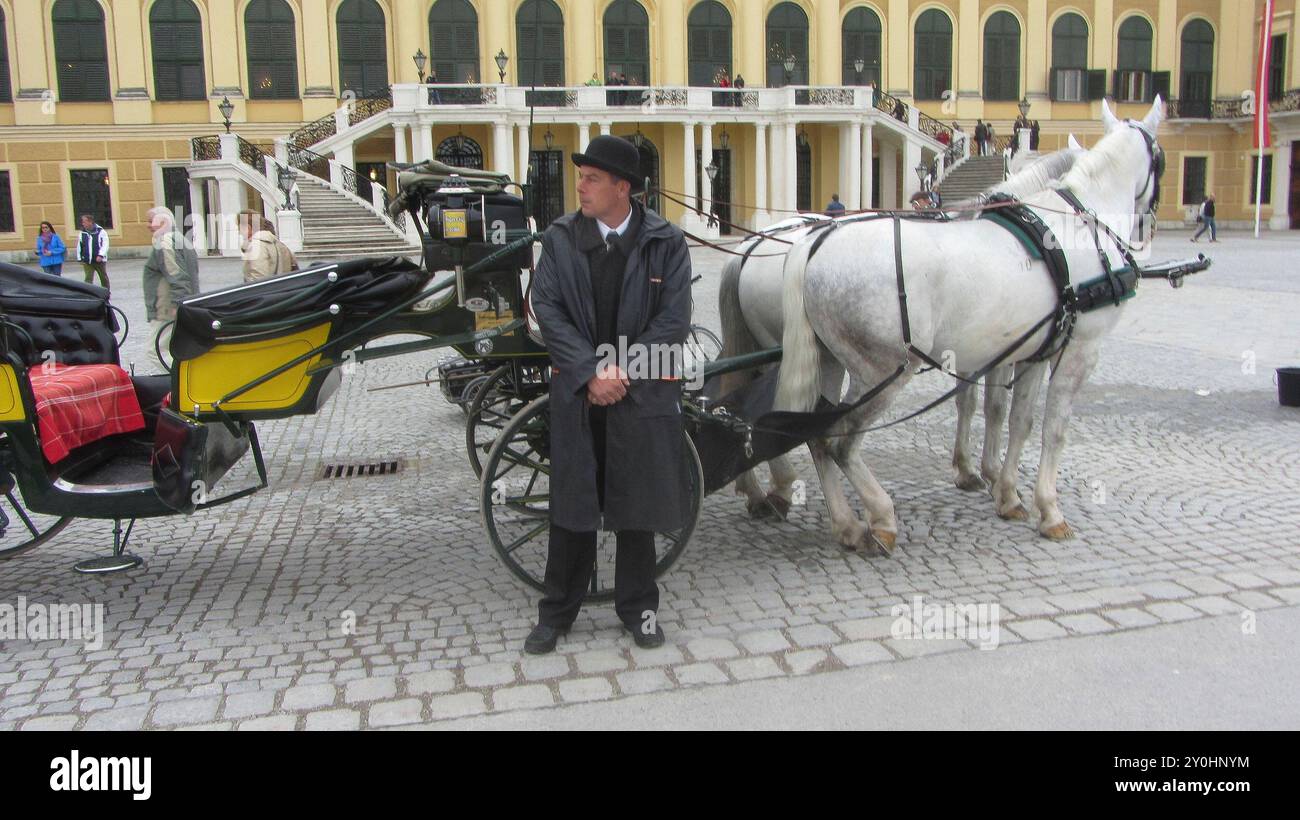 the empire of austria can still be seen everywhere in austria and beyond the empire of austria can still be seen everywhere in austria Stock Photohttps://www.alamy.com/image-license-details/?v=1https://www.alamy.com/the-empire-of-austria-can-still-be-seen-everywhere-in-austria-and-beyond-the-empire-of-austria-can-still-be-seen-everywhere-in-austria-image619963672.html
the empire of austria can still be seen everywhere in austria and beyond the empire of austria can still be seen everywhere in austria Stock Photohttps://www.alamy.com/image-license-details/?v=1https://www.alamy.com/the-empire-of-austria-can-still-be-seen-everywhere-in-austria-and-beyond-the-empire-of-austria-can-still-be-seen-everywhere-in-austria-image619963672.htmlRM2Y0HNYM–the empire of austria can still be seen everywhere in austria and beyond the empire of austria can still be seen everywhere in austria
 the empire of austria can still be seen everywhere in austria and beyond the empire of austria can still be seen everywhere in austria Stock Photohttps://www.alamy.com/image-license-details/?v=1https://www.alamy.com/the-empire-of-austria-can-still-be-seen-everywhere-in-austria-and-beyond-the-empire-of-austria-can-still-be-seen-everywhere-in-austria-image619468788.html
the empire of austria can still be seen everywhere in austria and beyond the empire of austria can still be seen everywhere in austria Stock Photohttps://www.alamy.com/image-license-details/?v=1https://www.alamy.com/the-empire-of-austria-can-still-be-seen-everywhere-in-austria-and-beyond-the-empire-of-austria-can-still-be-seen-everywhere-in-austria-image619468788.htmlRM2XYR6N8–the empire of austria can still be seen everywhere in austria and beyond the empire of austria can still be seen everywhere in austria
 the empire of austria can still be seen everywhere in austria and beyond the empire of austria can still be seen everywhere in austria Stock Photohttps://www.alamy.com/image-license-details/?v=1https://www.alamy.com/the-empire-of-austria-can-still-be-seen-everywhere-in-austria-and-beyond-the-empire-of-austria-can-still-be-seen-everywhere-in-austria-image619963844.html
the empire of austria can still be seen everywhere in austria and beyond the empire of austria can still be seen everywhere in austria Stock Photohttps://www.alamy.com/image-license-details/?v=1https://www.alamy.com/the-empire-of-austria-can-still-be-seen-everywhere-in-austria-and-beyond-the-empire-of-austria-can-still-be-seen-everywhere-in-austria-image619963844.htmlRM2Y0HP5T–the empire of austria can still be seen everywhere in austria and beyond the empire of austria can still be seen everywhere in austria
 the empire of austria can still be seen everywhere in austria and beyond the empire of austria can still be seen everywhere in austria Stock Photohttps://www.alamy.com/image-license-details/?v=1https://www.alamy.com/the-empire-of-austria-can-still-be-seen-everywhere-in-austria-and-beyond-the-empire-of-austria-can-still-be-seen-everywhere-in-austria-image619468775.html
the empire of austria can still be seen everywhere in austria and beyond the empire of austria can still be seen everywhere in austria Stock Photohttps://www.alamy.com/image-license-details/?v=1https://www.alamy.com/the-empire-of-austria-can-still-be-seen-everywhere-in-austria-and-beyond-the-empire-of-austria-can-still-be-seen-everywhere-in-austria-image619468775.htmlRM2XYR6MR–the empire of austria can still be seen everywhere in austria and beyond the empire of austria can still be seen everywhere in austria
 the empire of austria can still be seen everywhere in austria and beyond the empire of austria can still be seen everywhere in austria Stock Photohttps://www.alamy.com/image-license-details/?v=1https://www.alamy.com/the-empire-of-austria-can-still-be-seen-everywhere-in-austria-and-beyond-the-empire-of-austria-can-still-be-seen-everywhere-in-austria-image619469212.html
the empire of austria can still be seen everywhere in austria and beyond the empire of austria can still be seen everywhere in austria Stock Photohttps://www.alamy.com/image-license-details/?v=1https://www.alamy.com/the-empire-of-austria-can-still-be-seen-everywhere-in-austria-and-beyond-the-empire-of-austria-can-still-be-seen-everywhere-in-austria-image619469212.htmlRM2XYR78C–the empire of austria can still be seen everywhere in austria and beyond the empire of austria can still be seen everywhere in austria
 the empire of austria can still be seen everywhere in austria and beyond the empire of austria can still be seen everywhere in austria Stock Photohttps://www.alamy.com/image-license-details/?v=1https://www.alamy.com/the-empire-of-austria-can-still-be-seen-everywhere-in-austria-and-beyond-the-empire-of-austria-can-still-be-seen-everywhere-in-austria-image619964206.html
the empire of austria can still be seen everywhere in austria and beyond the empire of austria can still be seen everywhere in austria Stock Photohttps://www.alamy.com/image-license-details/?v=1https://www.alamy.com/the-empire-of-austria-can-still-be-seen-everywhere-in-austria-and-beyond-the-empire-of-austria-can-still-be-seen-everywhere-in-austria-image619964206.htmlRM2Y0HPJP–the empire of austria can still be seen everywhere in austria and beyond the empire of austria can still be seen everywhere in austria
 the empire of austria can still be seen everywhere in austria and beyond the empire of austria can still be seen everywhere in austria Stock Photohttps://www.alamy.com/image-license-details/?v=1https://www.alamy.com/the-empire-of-austria-can-still-be-seen-everywhere-in-austria-and-beyond-the-empire-of-austria-can-still-be-seen-everywhere-in-austria-image619963576.html
the empire of austria can still be seen everywhere in austria and beyond the empire of austria can still be seen everywhere in austria Stock Photohttps://www.alamy.com/image-license-details/?v=1https://www.alamy.com/the-empire-of-austria-can-still-be-seen-everywhere-in-austria-and-beyond-the-empire-of-austria-can-still-be-seen-everywhere-in-austria-image619963576.htmlRM2Y0HNT8–the empire of austria can still be seen everywhere in austria and beyond the empire of austria can still be seen everywhere in austria
 the empire of austria can still be seen everywhere in austria and beyond the empire of austria can still be seen everywhere in austria Stock Photohttps://www.alamy.com/image-license-details/?v=1https://www.alamy.com/the-empire-of-austria-can-still-be-seen-everywhere-in-austria-and-beyond-the-empire-of-austria-can-still-be-seen-everywhere-in-austria-image619963573.html
the empire of austria can still be seen everywhere in austria and beyond the empire of austria can still be seen everywhere in austria Stock Photohttps://www.alamy.com/image-license-details/?v=1https://www.alamy.com/the-empire-of-austria-can-still-be-seen-everywhere-in-austria-and-beyond-the-empire-of-austria-can-still-be-seen-everywhere-in-austria-image619963573.htmlRM2Y0HNT5–the empire of austria can still be seen everywhere in austria and beyond the empire of austria can still be seen everywhere in austria
 the empire of austria can still be seen everywhere in austria and beyond the empire of austria can still be seen everywhere in austria Stock Photohttps://www.alamy.com/image-license-details/?v=1https://www.alamy.com/the-empire-of-austria-can-still-be-seen-everywhere-in-austria-and-beyond-the-empire-of-austria-can-still-be-seen-everywhere-in-austria-image619963846.html
the empire of austria can still be seen everywhere in austria and beyond the empire of austria can still be seen everywhere in austria Stock Photohttps://www.alamy.com/image-license-details/?v=1https://www.alamy.com/the-empire-of-austria-can-still-be-seen-everywhere-in-austria-and-beyond-the-empire-of-austria-can-still-be-seen-everywhere-in-austria-image619963846.htmlRM2Y0HP5X–the empire of austria can still be seen everywhere in austria and beyond the empire of austria can still be seen everywhere in austria
 the empire of austria can still be seen everywhere in austria and beyond the empire of austria can still be seen everywhere in austria Stock Photohttps://www.alamy.com/image-license-details/?v=1https://www.alamy.com/the-empire-of-austria-can-still-be-seen-everywhere-in-austria-and-beyond-the-empire-of-austria-can-still-be-seen-everywhere-in-austria-image619468814.html
the empire of austria can still be seen everywhere in austria and beyond the empire of austria can still be seen everywhere in austria Stock Photohttps://www.alamy.com/image-license-details/?v=1https://www.alamy.com/the-empire-of-austria-can-still-be-seen-everywhere-in-austria-and-beyond-the-empire-of-austria-can-still-be-seen-everywhere-in-austria-image619468814.htmlRM2XYR6P6–the empire of austria can still be seen everywhere in austria and beyond the empire of austria can still be seen everywhere in austria
 the empire of austria can still be seen everywhere in austria and beyond the empire of austria can still be seen everywhere in austria Stock Photohttps://www.alamy.com/image-license-details/?v=1https://www.alamy.com/the-empire-of-austria-can-still-be-seen-everywhere-in-austria-and-beyond-the-empire-of-austria-can-still-be-seen-everywhere-in-austria-image619468796.html
the empire of austria can still be seen everywhere in austria and beyond the empire of austria can still be seen everywhere in austria Stock Photohttps://www.alamy.com/image-license-details/?v=1https://www.alamy.com/the-empire-of-austria-can-still-be-seen-everywhere-in-austria-and-beyond-the-empire-of-austria-can-still-be-seen-everywhere-in-austria-image619468796.htmlRM2XYR6NG–the empire of austria can still be seen everywhere in austria and beyond the empire of austria can still be seen everywhere in austria
 the empire of austria can still be seen everywhere in austria and beyond the empire of austria can still be seen everywhere in austria Stock Photohttps://www.alamy.com/image-license-details/?v=1https://www.alamy.com/the-empire-of-austria-can-still-be-seen-everywhere-in-austria-and-beyond-the-empire-of-austria-can-still-be-seen-everywhere-in-austria-image619668674.html
the empire of austria can still be seen everywhere in austria and beyond the empire of austria can still be seen everywhere in austria Stock Photohttps://www.alamy.com/image-license-details/?v=1https://www.alamy.com/the-empire-of-austria-can-still-be-seen-everywhere-in-austria-and-beyond-the-empire-of-austria-can-still-be-seen-everywhere-in-austria-image619668674.htmlRM2Y049M2–the empire of austria can still be seen everywhere in austria and beyond the empire of austria can still be seen everywhere in austria
 the empire of austria can still be seen everywhere in austria and beyond the empire of austria can still be seen everywhere in austria Stock Photohttps://www.alamy.com/image-license-details/?v=1https://www.alamy.com/the-empire-of-austria-can-still-be-seen-everywhere-in-austria-and-beyond-the-empire-of-austria-can-still-be-seen-everywhere-in-austria-image619668754.html
the empire of austria can still be seen everywhere in austria and beyond the empire of austria can still be seen everywhere in austria Stock Photohttps://www.alamy.com/image-license-details/?v=1https://www.alamy.com/the-empire-of-austria-can-still-be-seen-everywhere-in-austria-and-beyond-the-empire-of-austria-can-still-be-seen-everywhere-in-austria-image619668754.htmlRM2Y049PX–the empire of austria can still be seen everywhere in austria and beyond the empire of austria can still be seen everywhere in austria
 the empire of austria can still be seen everywhere in austria and beyond the empire of austria can still be seen everywhere in austria Stock Photohttps://www.alamy.com/image-license-details/?v=1https://www.alamy.com/the-empire-of-austria-can-still-be-seen-everywhere-in-austria-and-beyond-the-empire-of-austria-can-still-be-seen-everywhere-in-austria-image619668728.html
the empire of austria can still be seen everywhere in austria and beyond the empire of austria can still be seen everywhere in austria Stock Photohttps://www.alamy.com/image-license-details/?v=1https://www.alamy.com/the-empire-of-austria-can-still-be-seen-everywhere-in-austria-and-beyond-the-empire-of-austria-can-still-be-seen-everywhere-in-austria-image619668728.htmlRM2Y049P0–the empire of austria can still be seen everywhere in austria and beyond the empire of austria can still be seen everywhere in austria
 the empire of austria can still be seen everywhere in austria and beyond the empire of austria can still be seen everywhere in austria Stock Photohttps://www.alamy.com/image-license-details/?v=1https://www.alamy.com/the-empire-of-austria-can-still-be-seen-everywhere-in-austria-and-beyond-the-empire-of-austria-can-still-be-seen-everywhere-in-austria-image619668643.html
the empire of austria can still be seen everywhere in austria and beyond the empire of austria can still be seen everywhere in austria Stock Photohttps://www.alamy.com/image-license-details/?v=1https://www.alamy.com/the-empire-of-austria-can-still-be-seen-everywhere-in-austria-and-beyond-the-empire-of-austria-can-still-be-seen-everywhere-in-austria-image619668643.htmlRM2Y049JY–the empire of austria can still be seen everywhere in austria and beyond the empire of austria can still be seen everywhere in austria
 the empire of austria can still be seen everywhere in austria and beyond the empire of austria can still be seen everywhere in austria Stock Photohttps://www.alamy.com/image-license-details/?v=1https://www.alamy.com/the-empire-of-austria-can-still-be-seen-everywhere-in-austria-and-beyond-the-empire-of-austria-can-still-be-seen-everywhere-in-austria-image619668671.html
the empire of austria can still be seen everywhere in austria and beyond the empire of austria can still be seen everywhere in austria Stock Photohttps://www.alamy.com/image-license-details/?v=1https://www.alamy.com/the-empire-of-austria-can-still-be-seen-everywhere-in-austria-and-beyond-the-empire-of-austria-can-still-be-seen-everywhere-in-austria-image619668671.htmlRM2Y049KY–the empire of austria can still be seen everywhere in austria and beyond the empire of austria can still be seen everywhere in austria
 the empire of austria can still be seen everywhere in austria and beyond the empire of austria can still be seen everywhere in austria Stock Photohttps://www.alamy.com/image-license-details/?v=1https://www.alamy.com/the-empire-of-austria-can-still-be-seen-everywhere-in-austria-and-beyond-the-empire-of-austria-can-still-be-seen-everywhere-in-austria-image619668730.html
the empire of austria can still be seen everywhere in austria and beyond the empire of austria can still be seen everywhere in austria Stock Photohttps://www.alamy.com/image-license-details/?v=1https://www.alamy.com/the-empire-of-austria-can-still-be-seen-everywhere-in-austria-and-beyond-the-empire-of-austria-can-still-be-seen-everywhere-in-austria-image619668730.htmlRM2Y049P2–the empire of austria can still be seen everywhere in austria and beyond the empire of austria can still be seen everywhere in austria
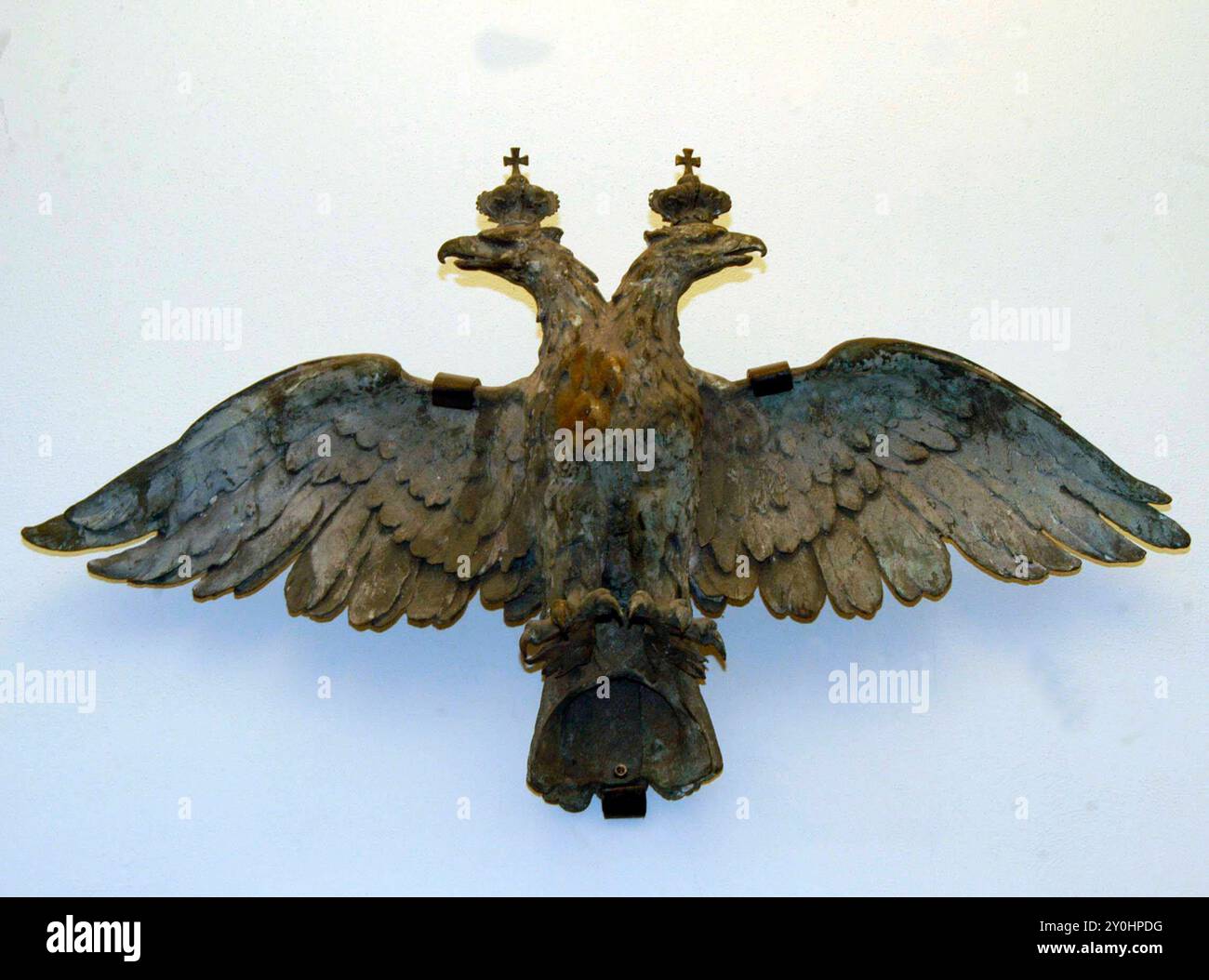 the empire of austria can still be seen everywhere in austria and beyond the empire of austria can still be seen everywhere in austria Stock Photohttps://www.alamy.com/image-license-details/?v=1https://www.alamy.com/the-empire-of-austria-can-still-be-seen-everywhere-in-austria-and-beyond-the-empire-of-austria-can-still-be-seen-everywhere-in-austria-image619964060.html
the empire of austria can still be seen everywhere in austria and beyond the empire of austria can still be seen everywhere in austria Stock Photohttps://www.alamy.com/image-license-details/?v=1https://www.alamy.com/the-empire-of-austria-can-still-be-seen-everywhere-in-austria-and-beyond-the-empire-of-austria-can-still-be-seen-everywhere-in-austria-image619964060.htmlRM2Y0HPDG–the empire of austria can still be seen everywhere in austria and beyond the empire of austria can still be seen everywhere in austria
 the empire of austria can still be seen everywhere in austria and beyond the empire of austria can still be seen everywhere in austria Stock Photohttps://www.alamy.com/image-license-details/?v=1https://www.alamy.com/the-empire-of-austria-can-still-be-seen-everywhere-in-austria-and-beyond-the-empire-of-austria-can-still-be-seen-everywhere-in-austria-image619468930.html
the empire of austria can still be seen everywhere in austria and beyond the empire of austria can still be seen everywhere in austria Stock Photohttps://www.alamy.com/image-license-details/?v=1https://www.alamy.com/the-empire-of-austria-can-still-be-seen-everywhere-in-austria-and-beyond-the-empire-of-austria-can-still-be-seen-everywhere-in-austria-image619468930.htmlRM2XYR6XA–the empire of austria can still be seen everywhere in austria and beyond the empire of austria can still be seen everywhere in austria
 the empire of austria can still be seen everywhere in austria and beyond the empire of austria can still be seen everywhere in austria Stock Photohttps://www.alamy.com/image-license-details/?v=1https://www.alamy.com/the-empire-of-austria-can-still-be-seen-everywhere-in-austria-and-beyond-the-empire-of-austria-can-still-be-seen-everywhere-in-austria-image619668745.html
the empire of austria can still be seen everywhere in austria and beyond the empire of austria can still be seen everywhere in austria Stock Photohttps://www.alamy.com/image-license-details/?v=1https://www.alamy.com/the-empire-of-austria-can-still-be-seen-everywhere-in-austria-and-beyond-the-empire-of-austria-can-still-be-seen-everywhere-in-austria-image619668745.htmlRM2Y049PH–the empire of austria can still be seen everywhere in austria and beyond the empire of austria can still be seen everywhere in austria
 RECORD DATE NOT STATED the empire of austria can still be seen everywhere in austria and beyond the empire of austria can still be seen everywhere in austria Stock Photohttps://www.alamy.com/image-license-details/?v=1https://www.alamy.com/record-date-not-stated-the-empire-of-austria-can-still-be-seen-everywhere-in-austria-and-beyond-the-empire-of-austria-can-still-be-seen-everywhere-in-austria-image620024035.html
RECORD DATE NOT STATED the empire of austria can still be seen everywhere in austria and beyond the empire of austria can still be seen everywhere in austria Stock Photohttps://www.alamy.com/image-license-details/?v=1https://www.alamy.com/record-date-not-stated-the-empire-of-austria-can-still-be-seen-everywhere-in-austria-and-beyond-the-empire-of-austria-can-still-be-seen-everywhere-in-austria-image620024035.htmlRM2Y0MEYF–RECORD DATE NOT STATED the empire of austria can still be seen everywhere in austria and beyond the empire of austria can still be seen everywhere in austria